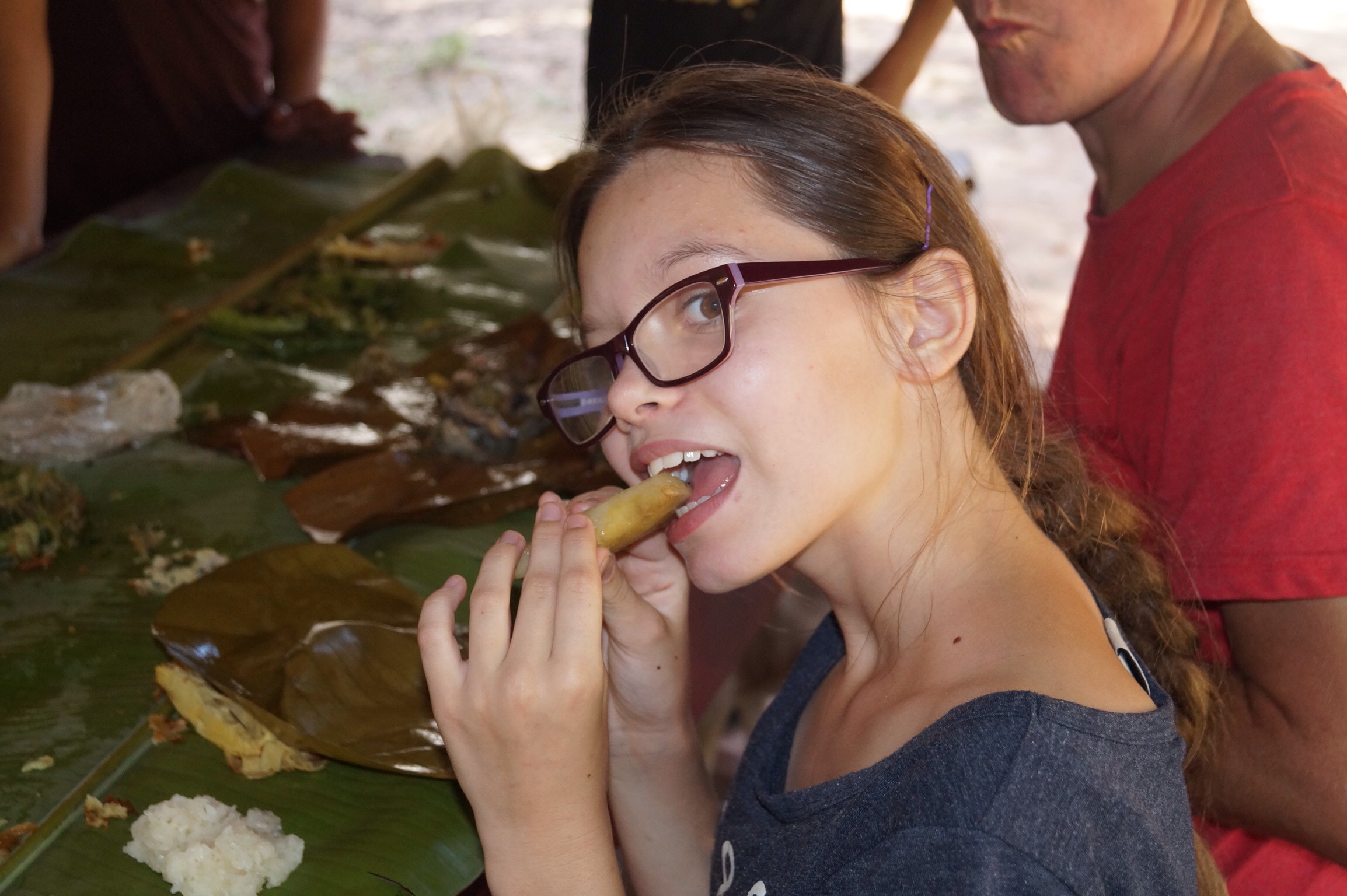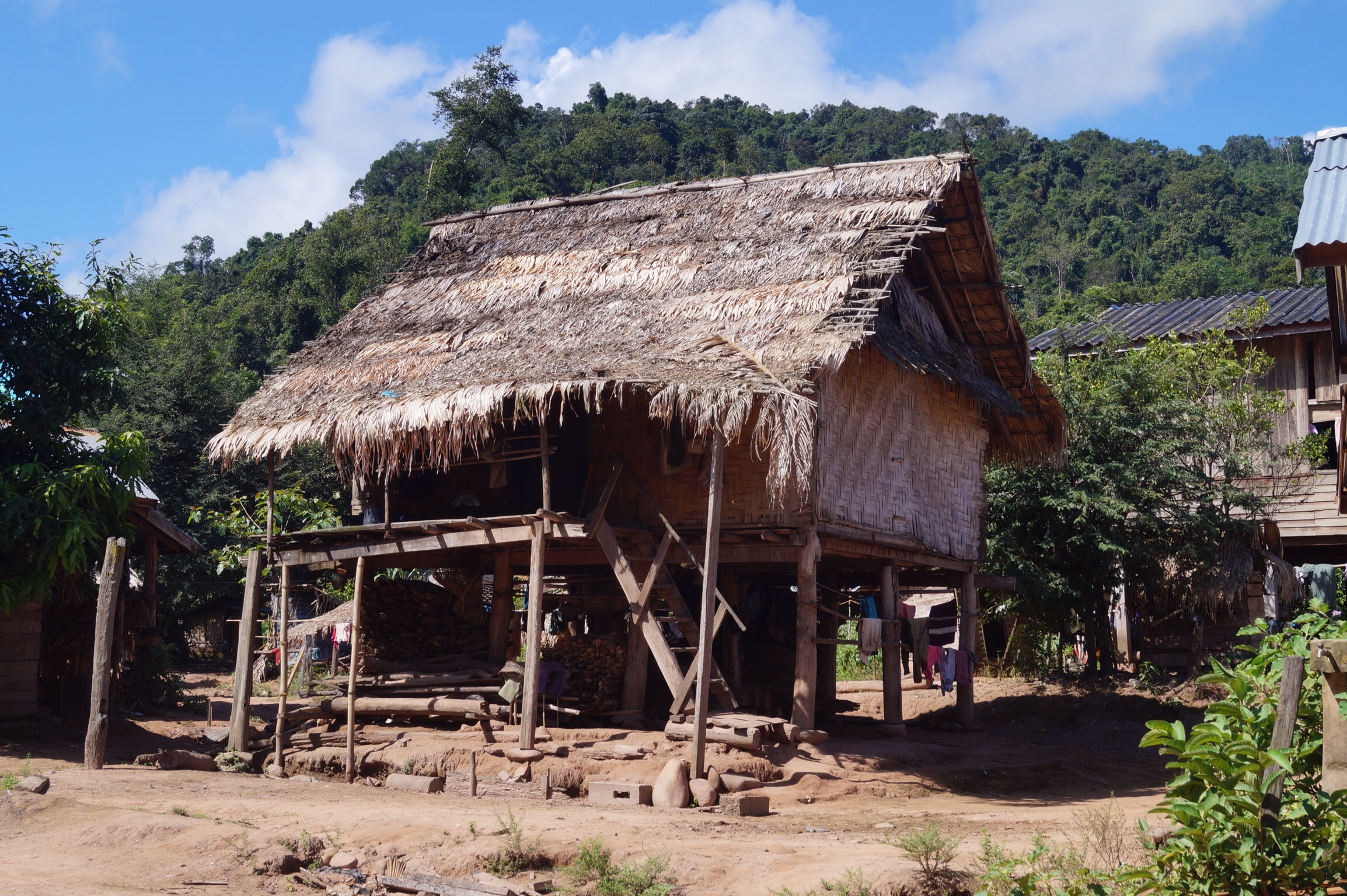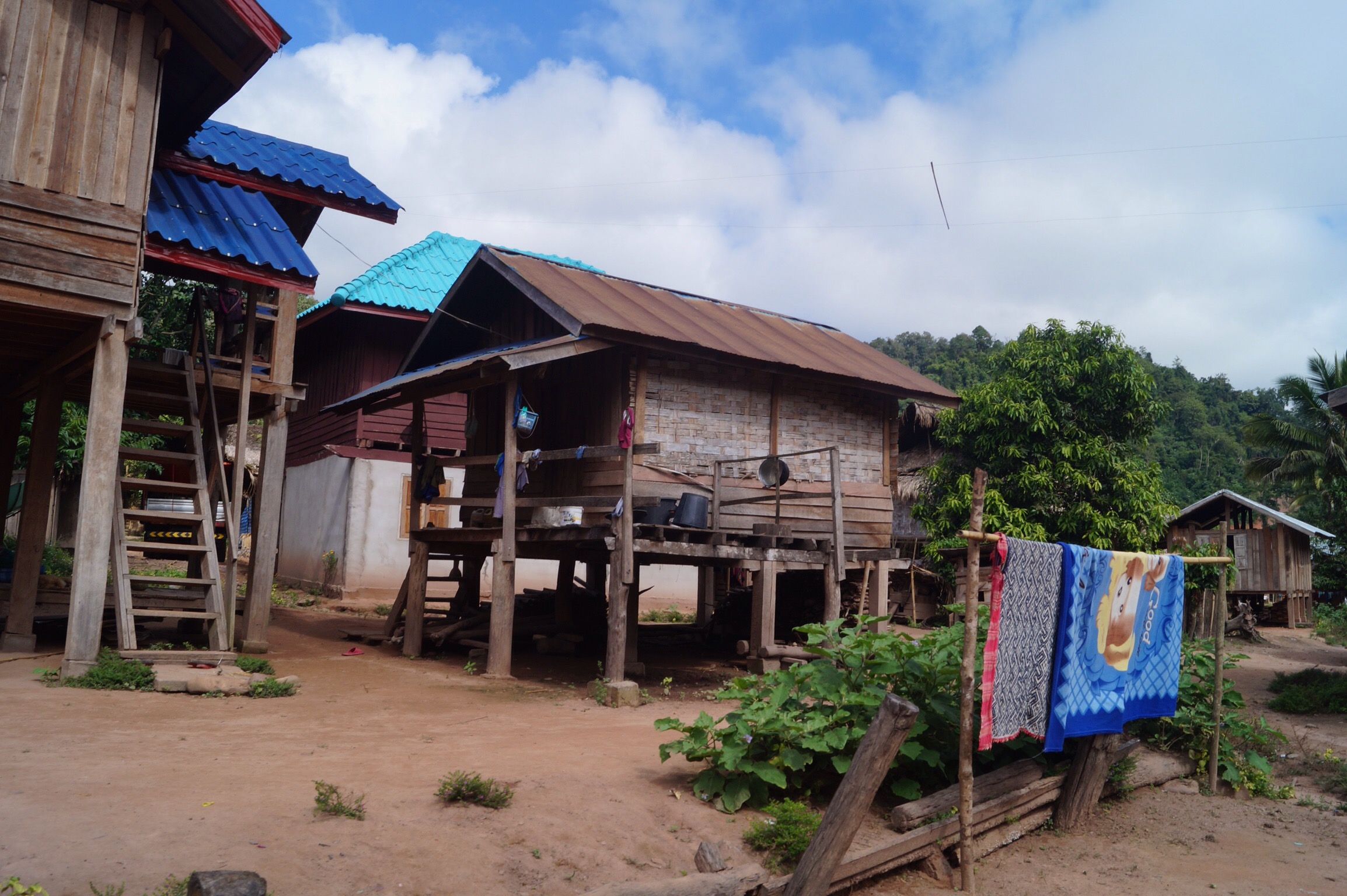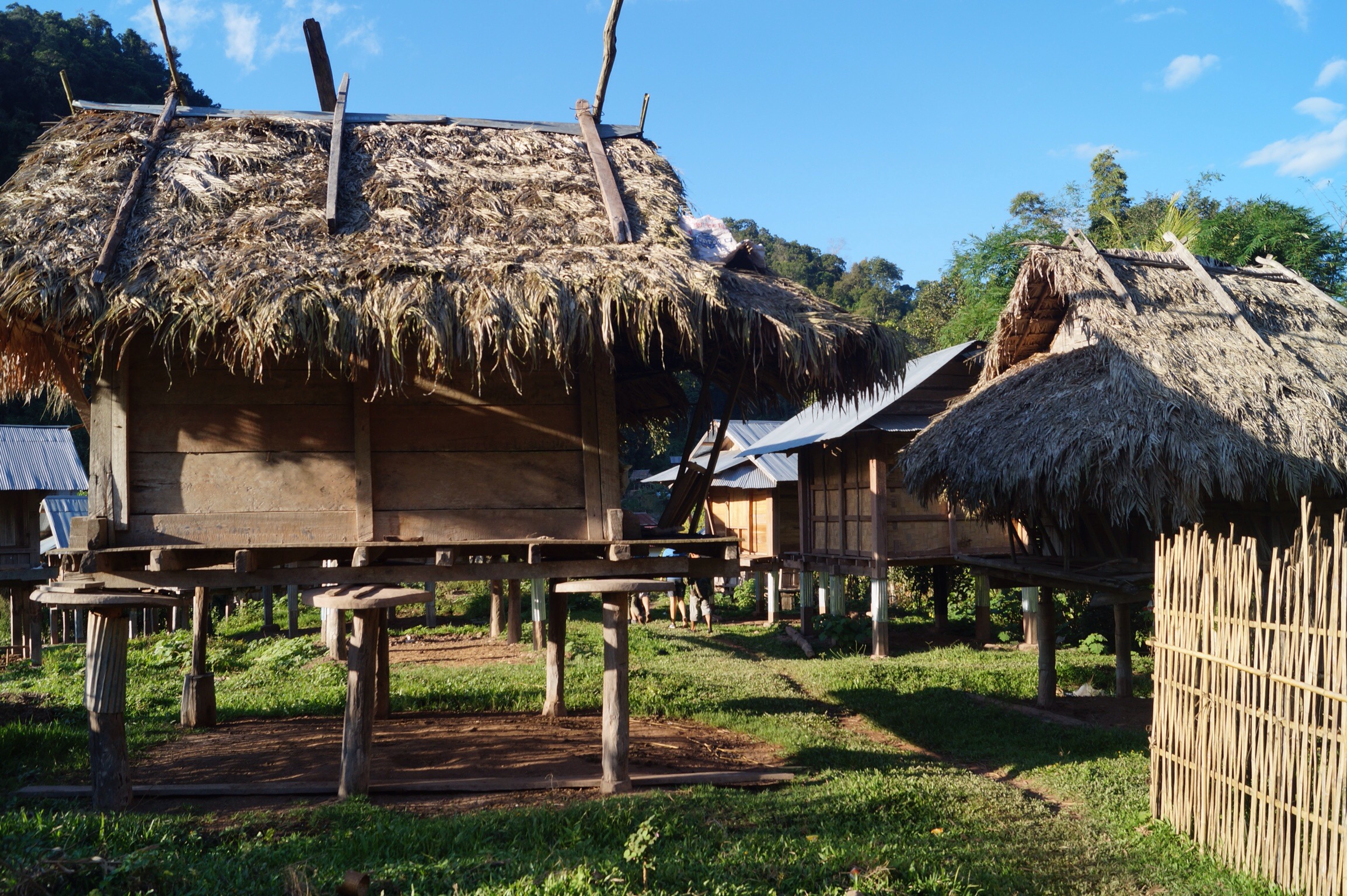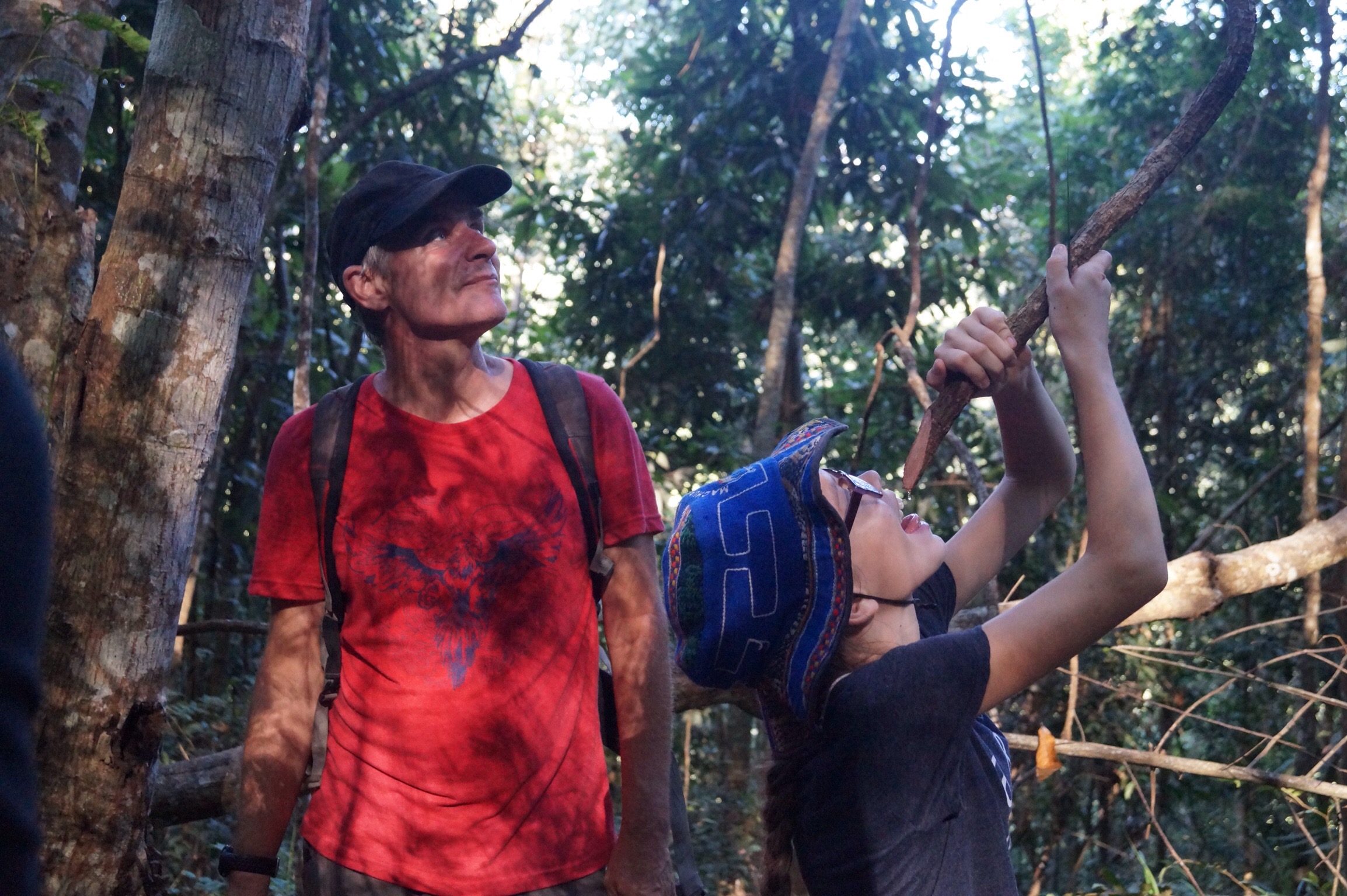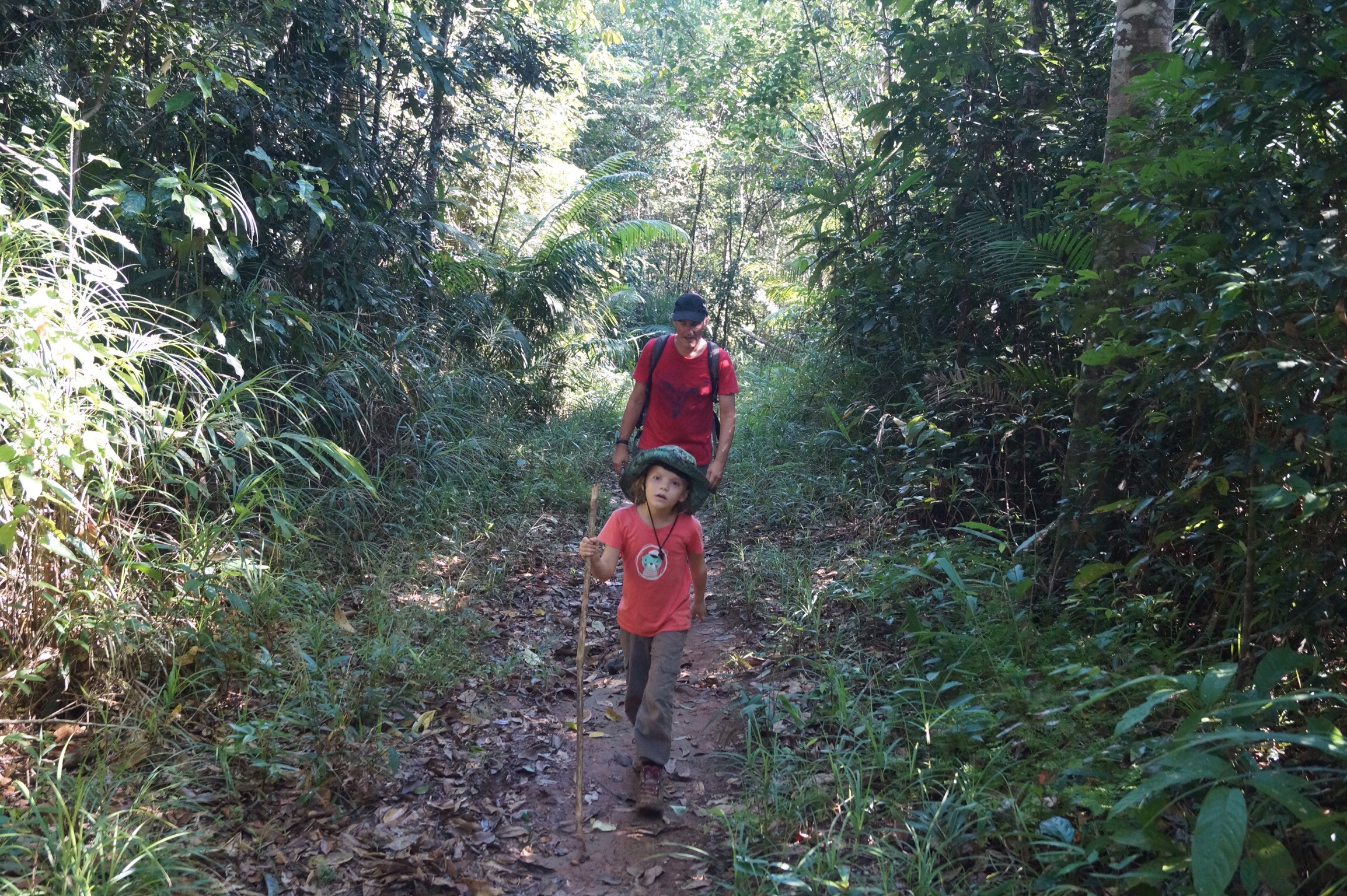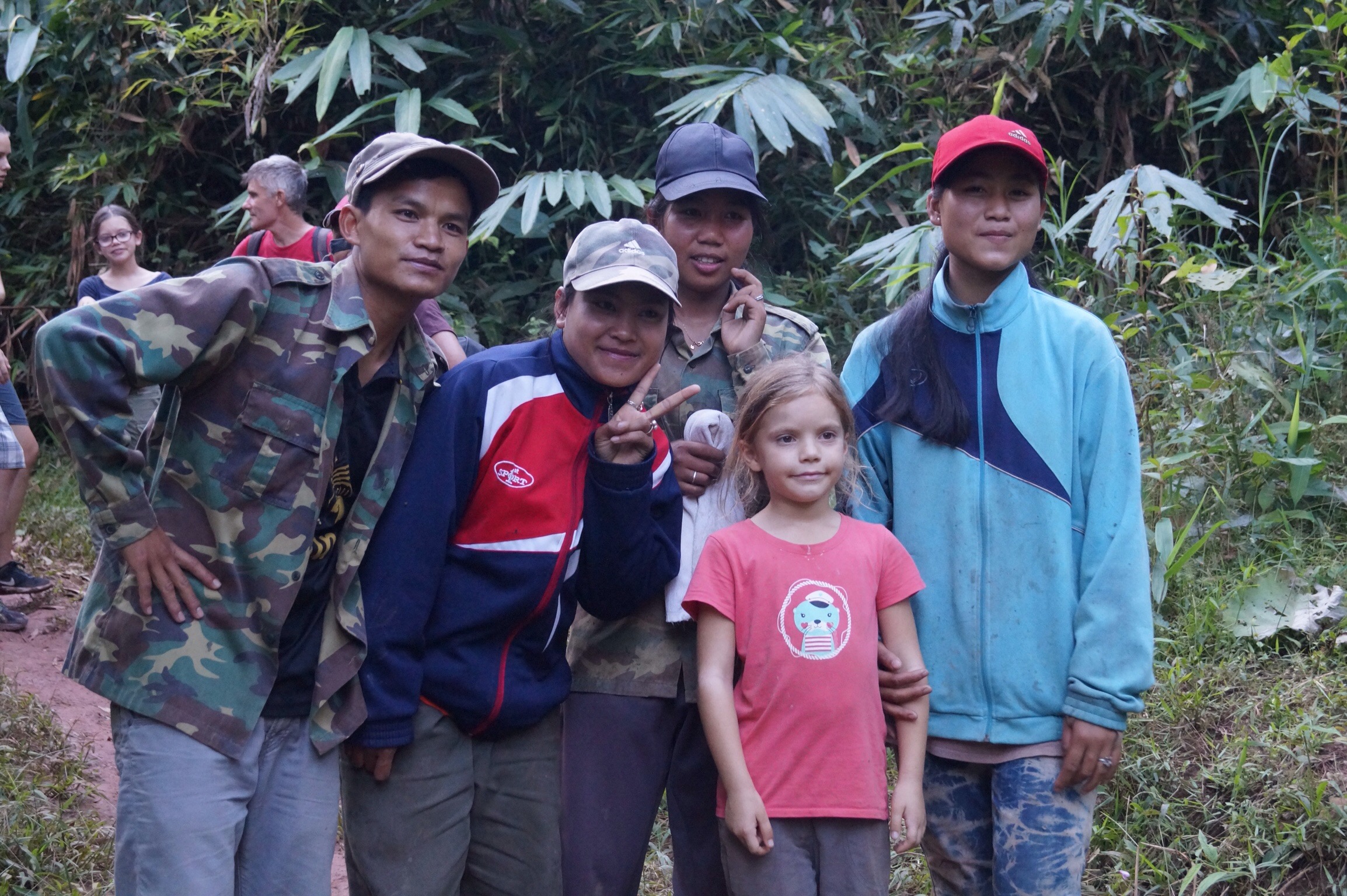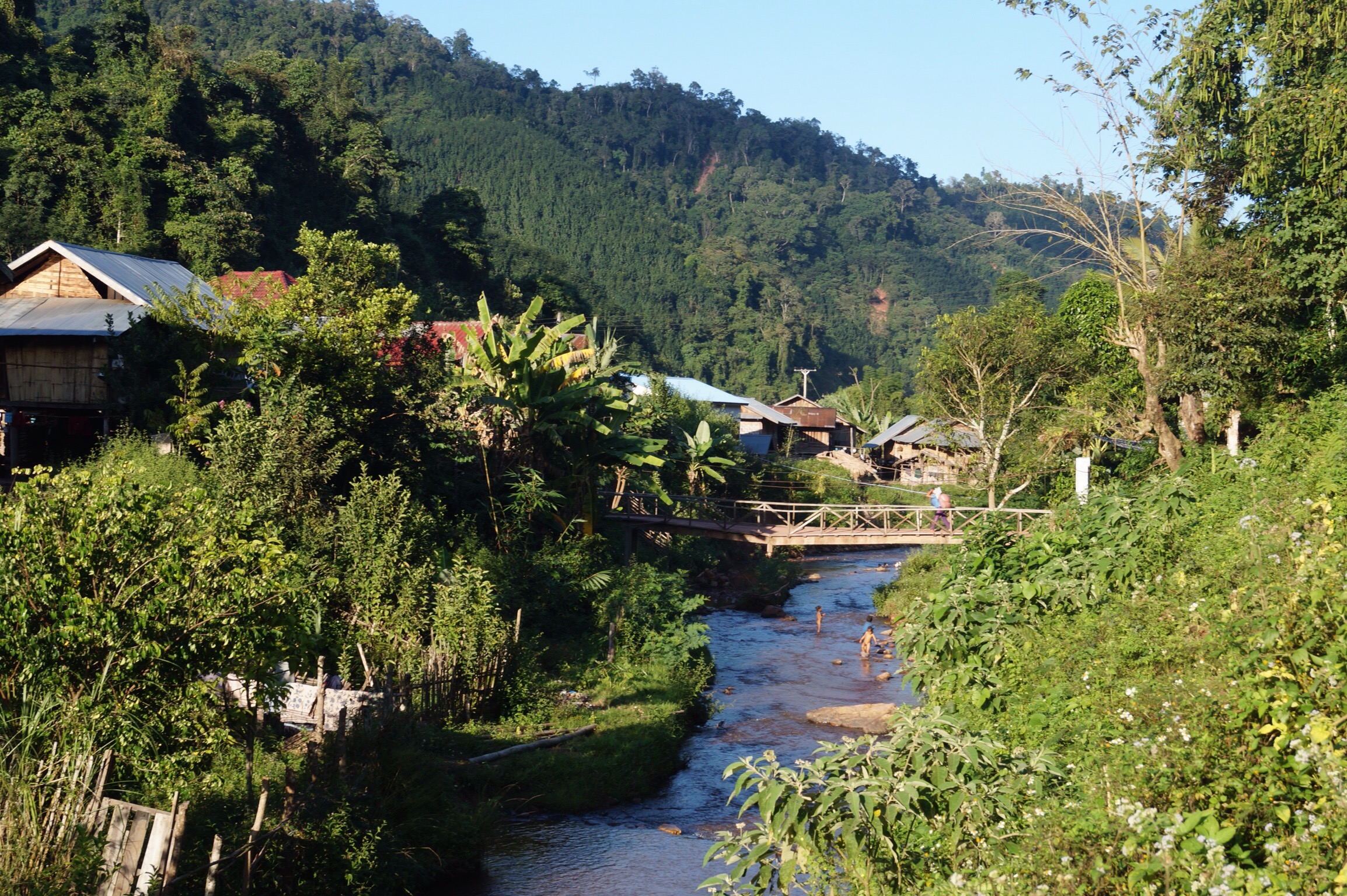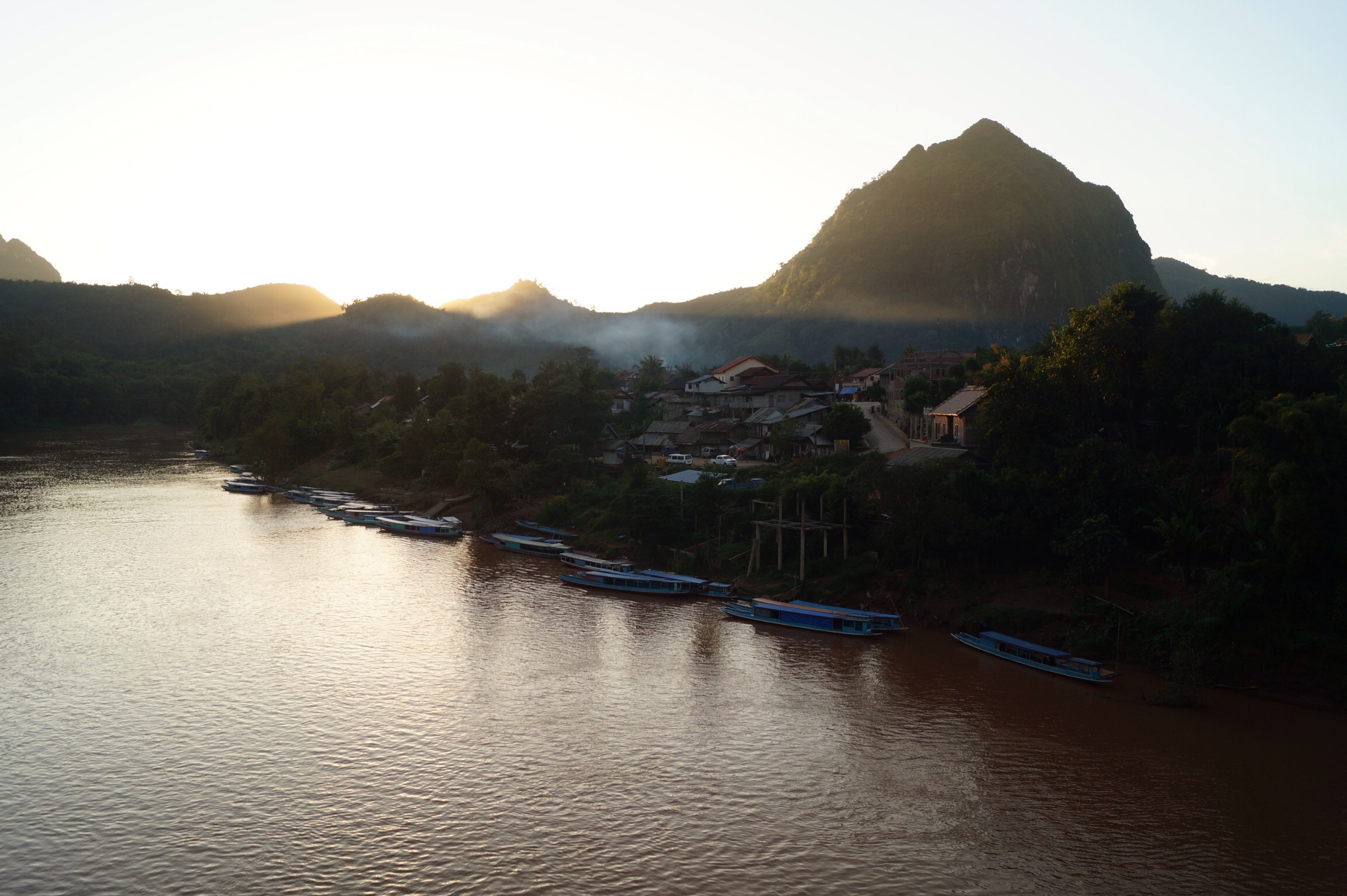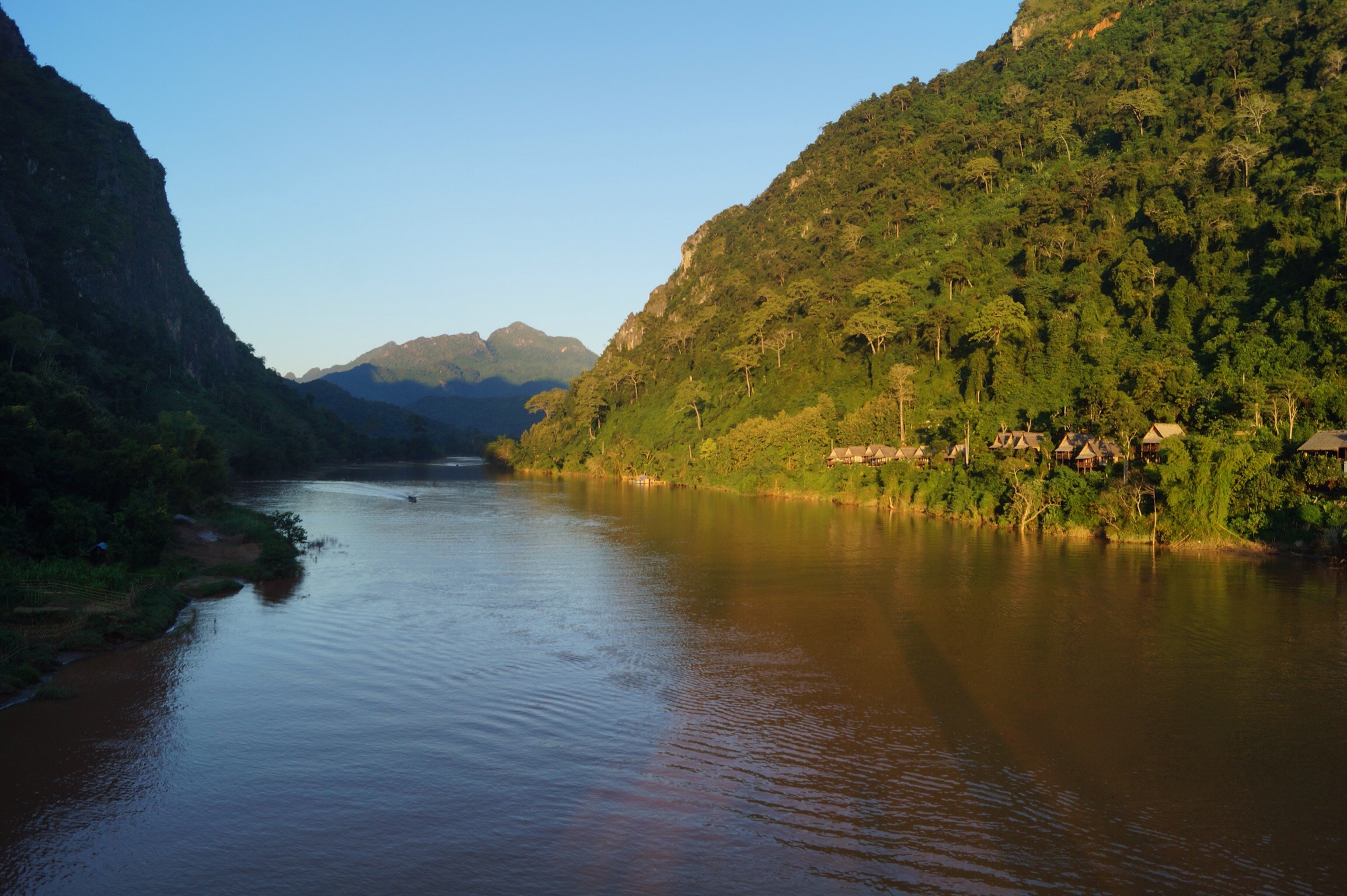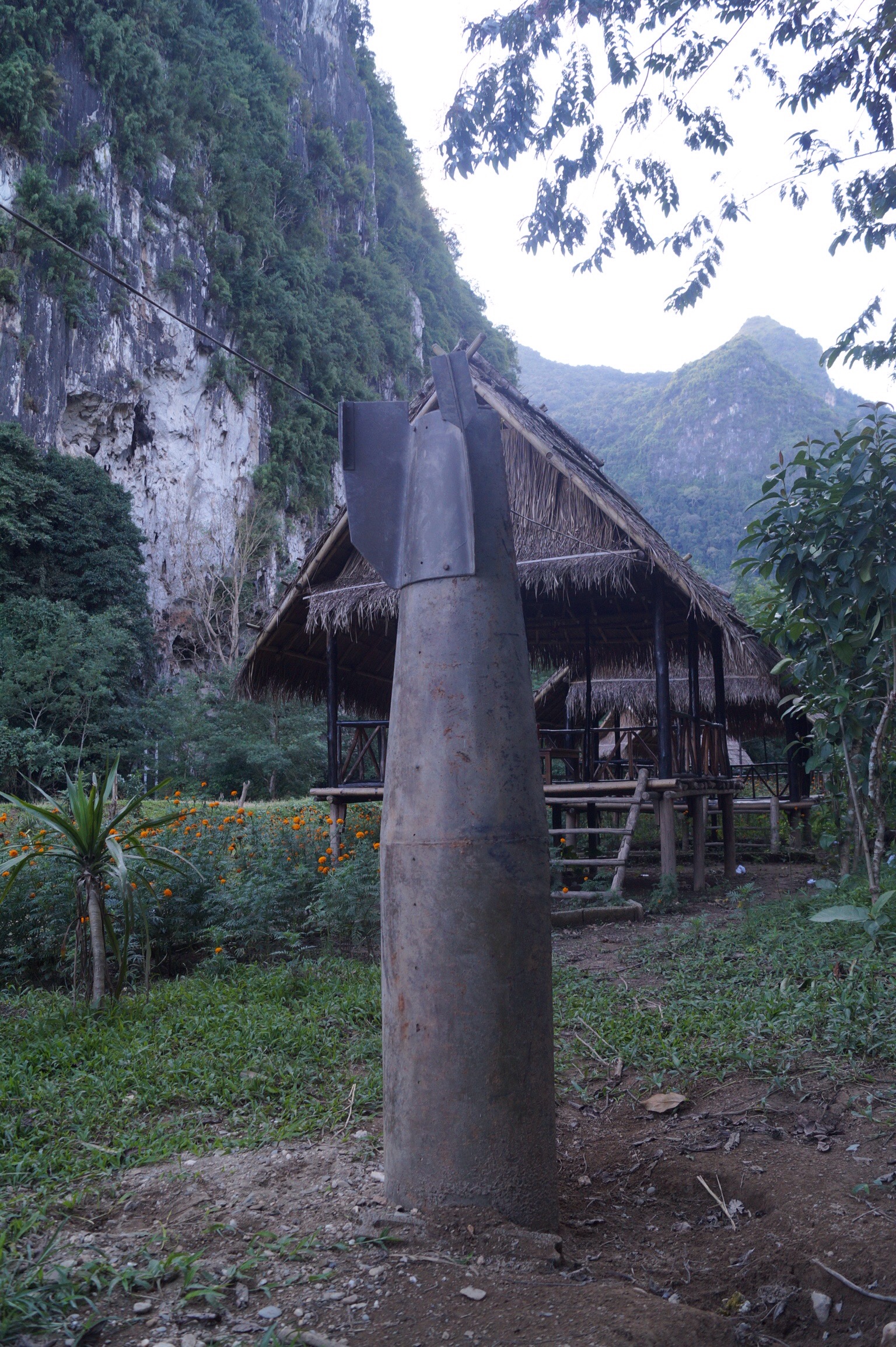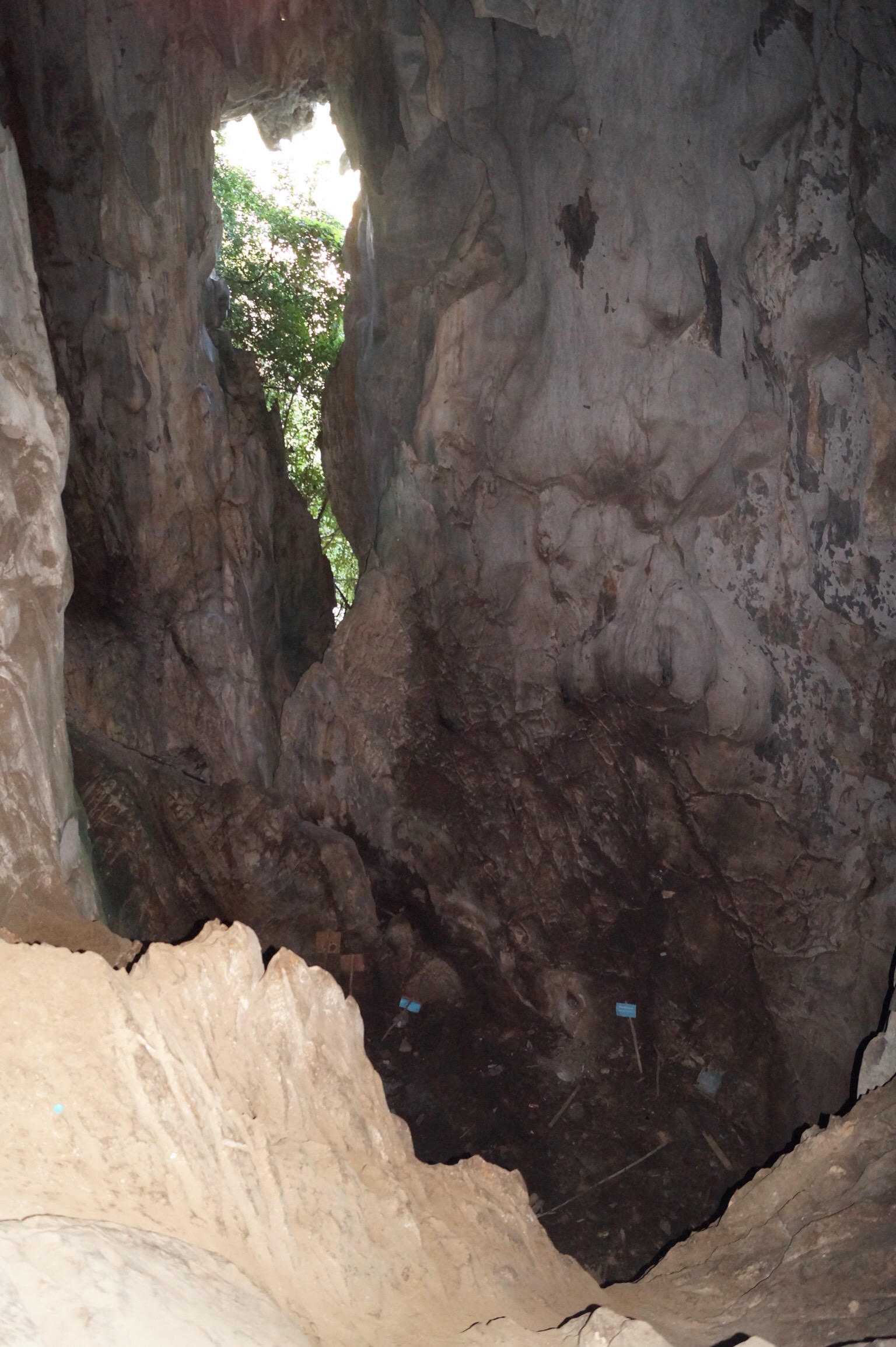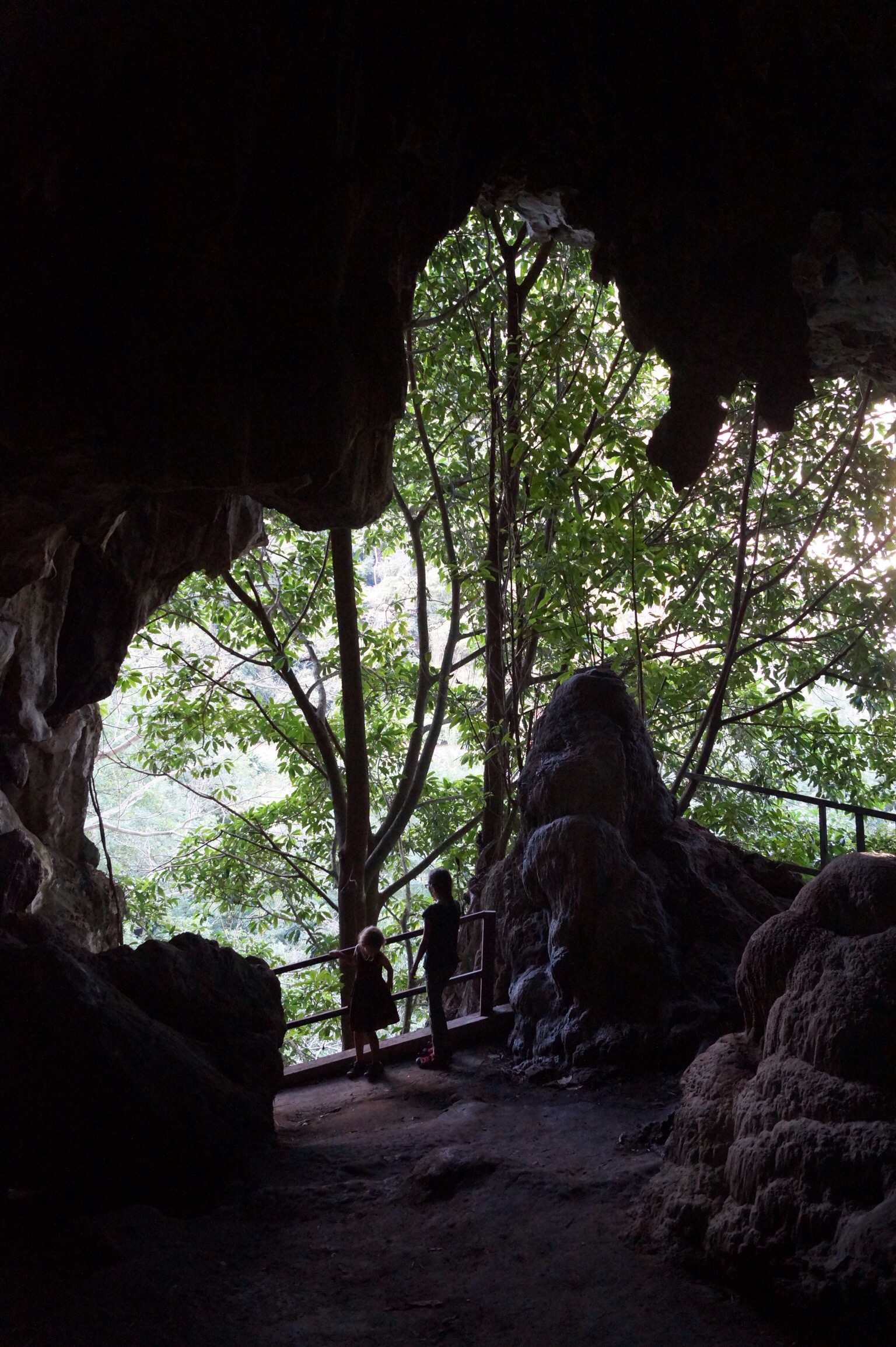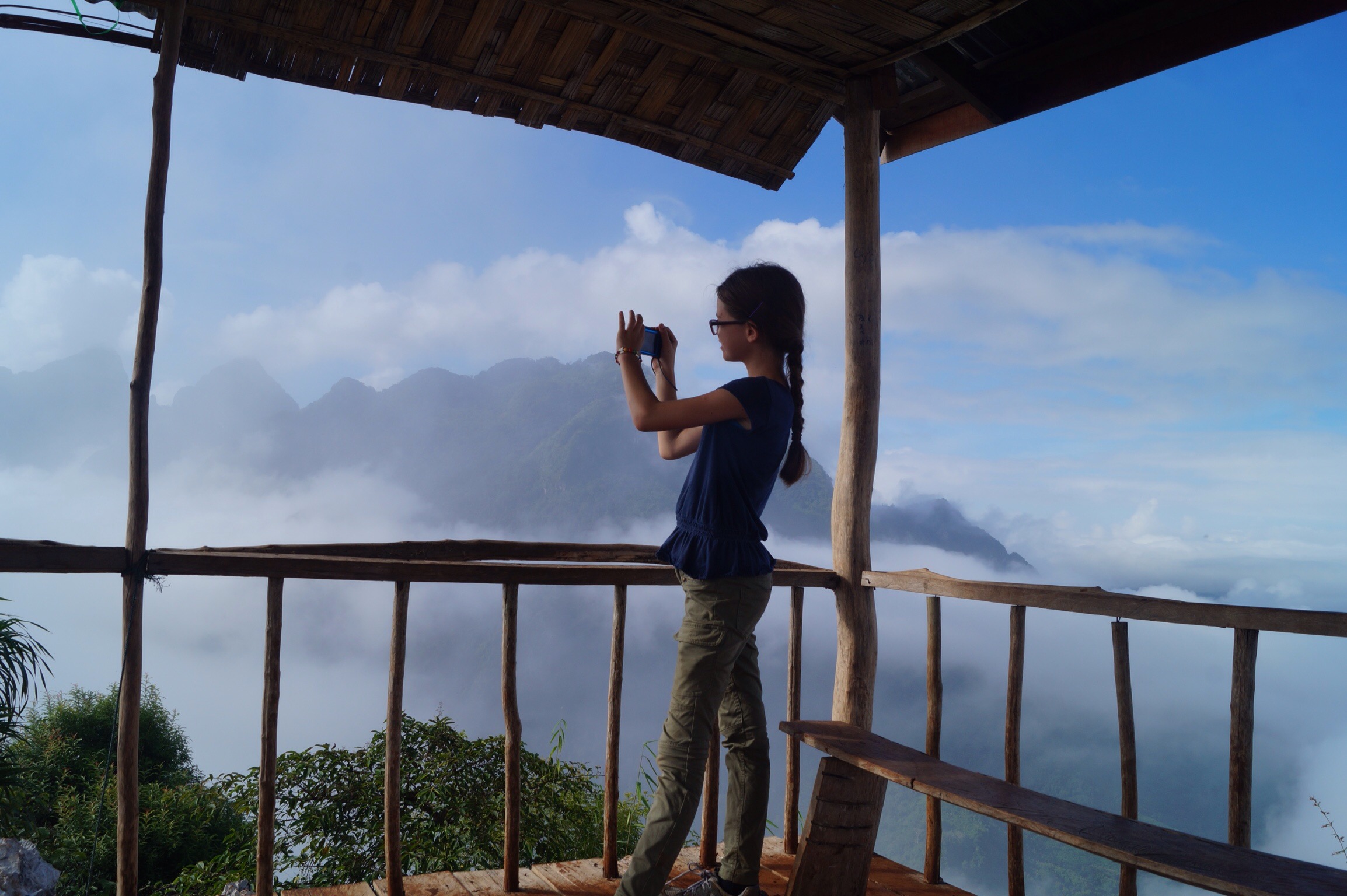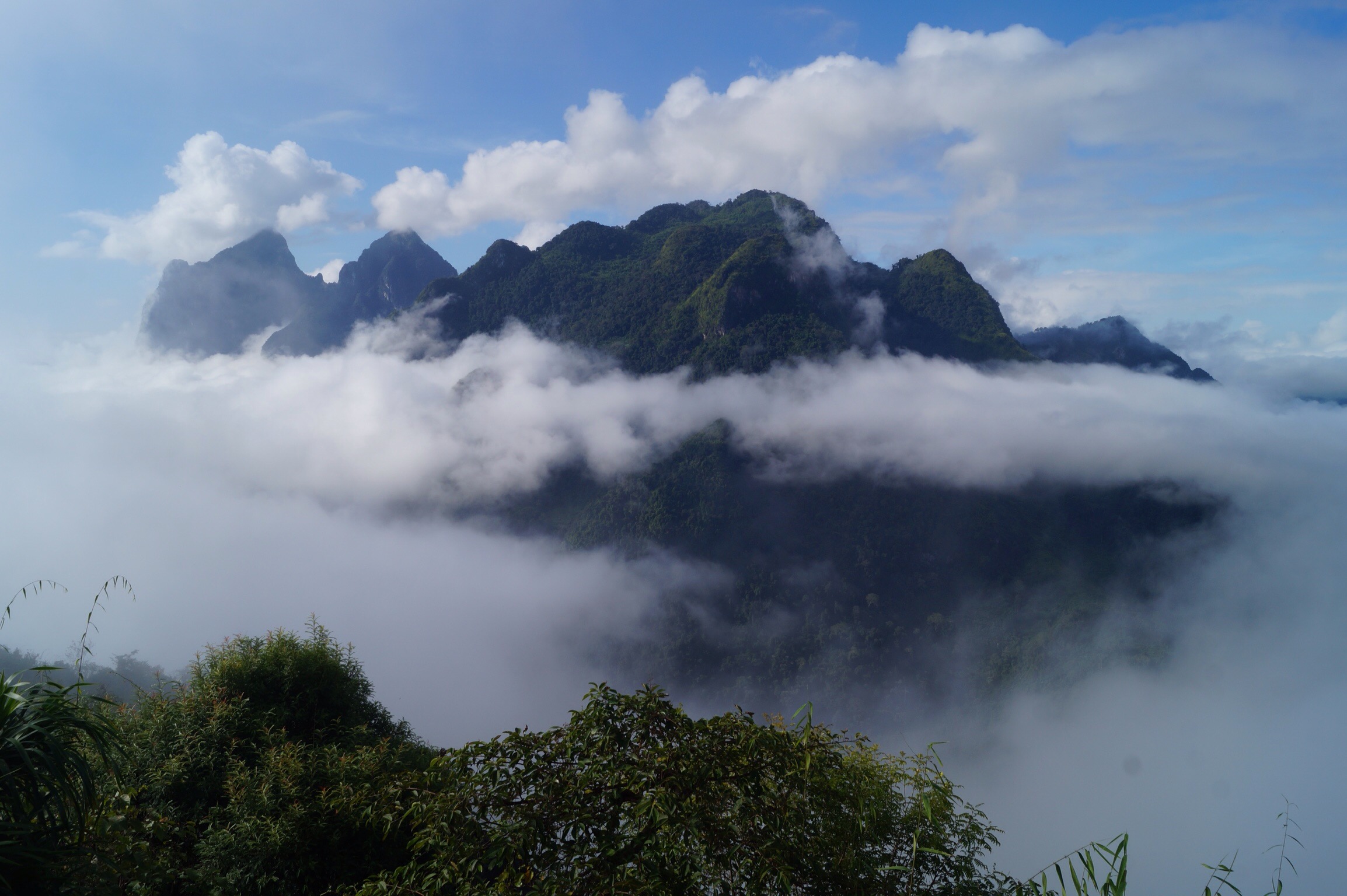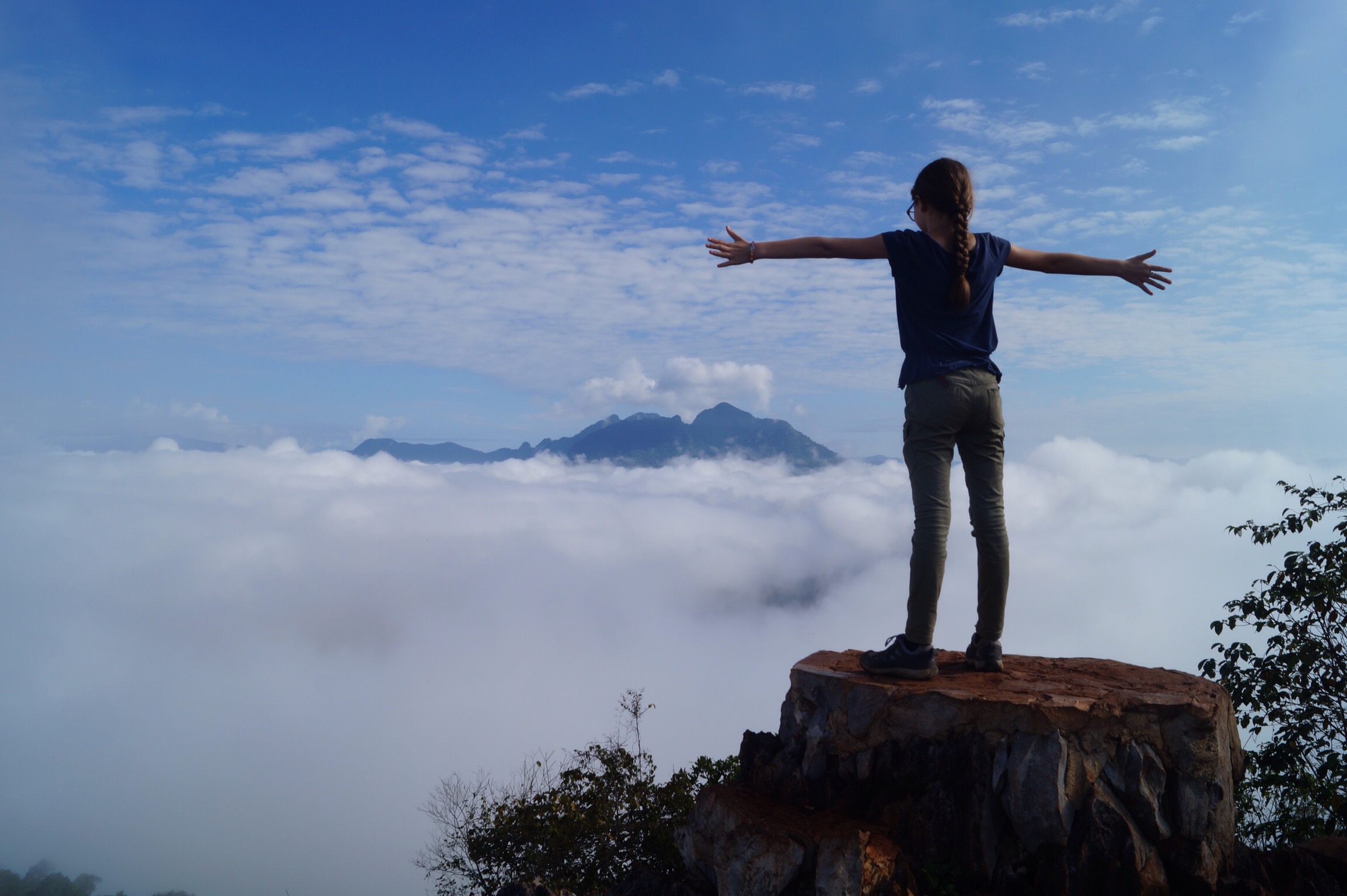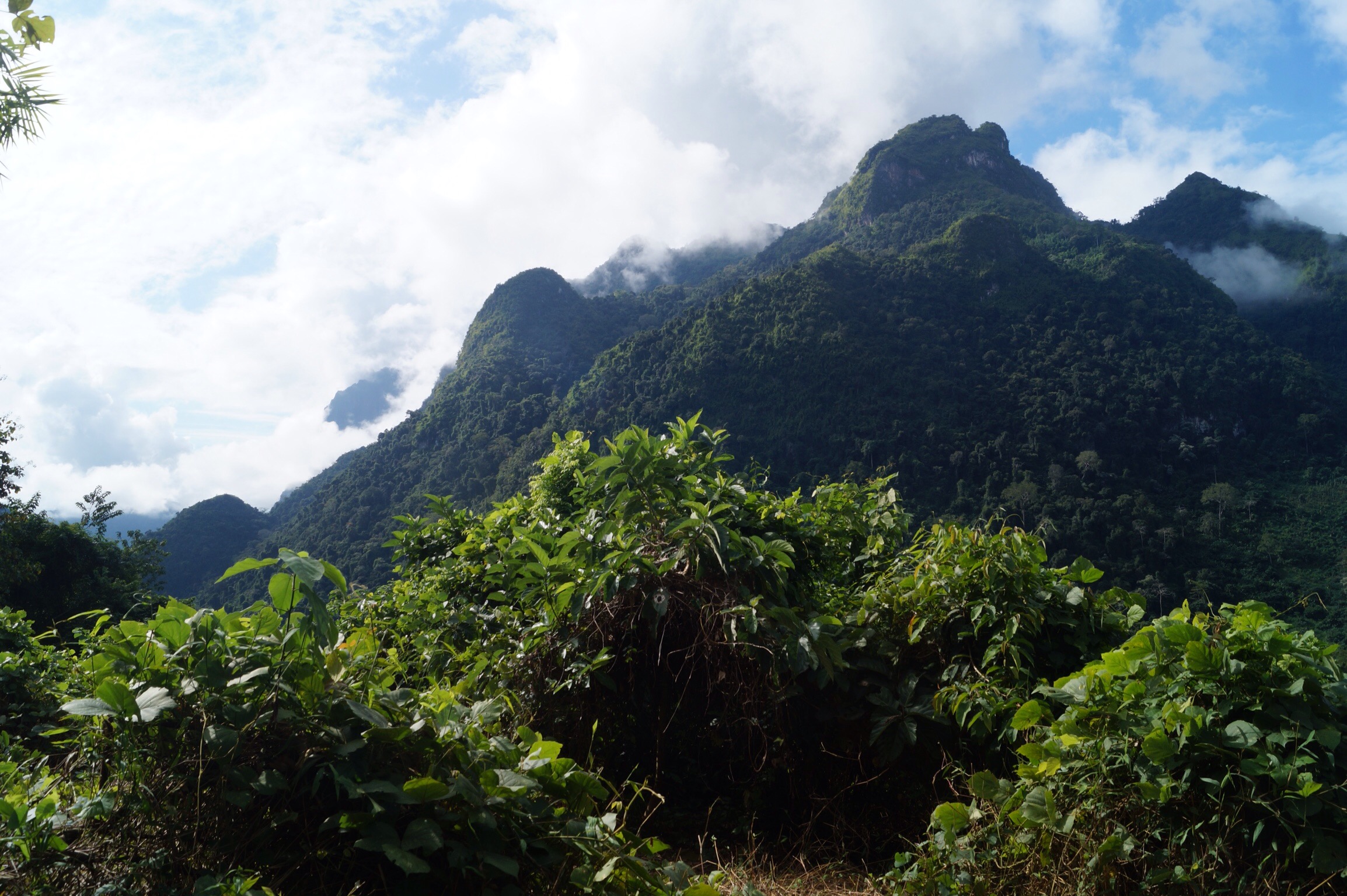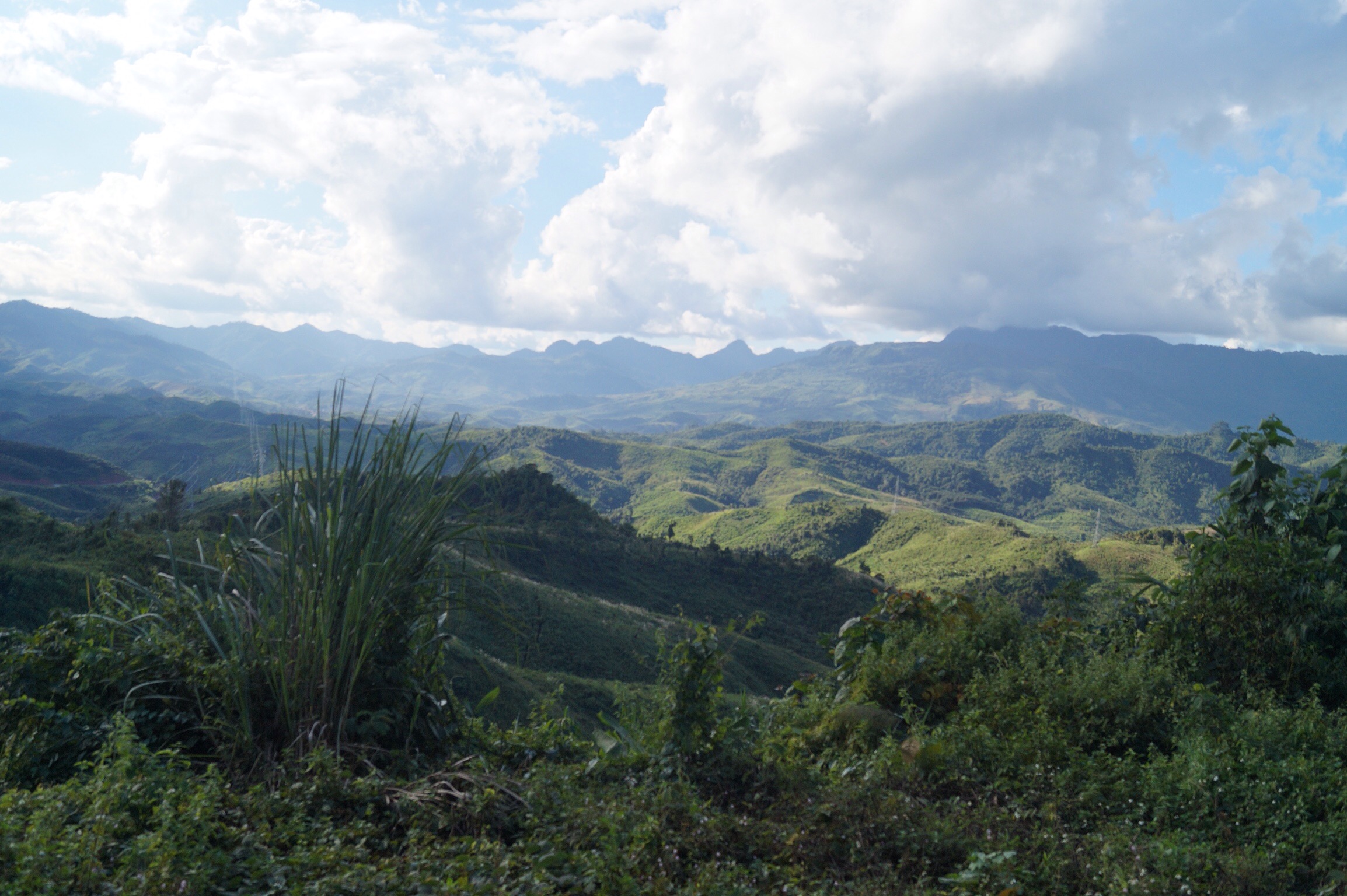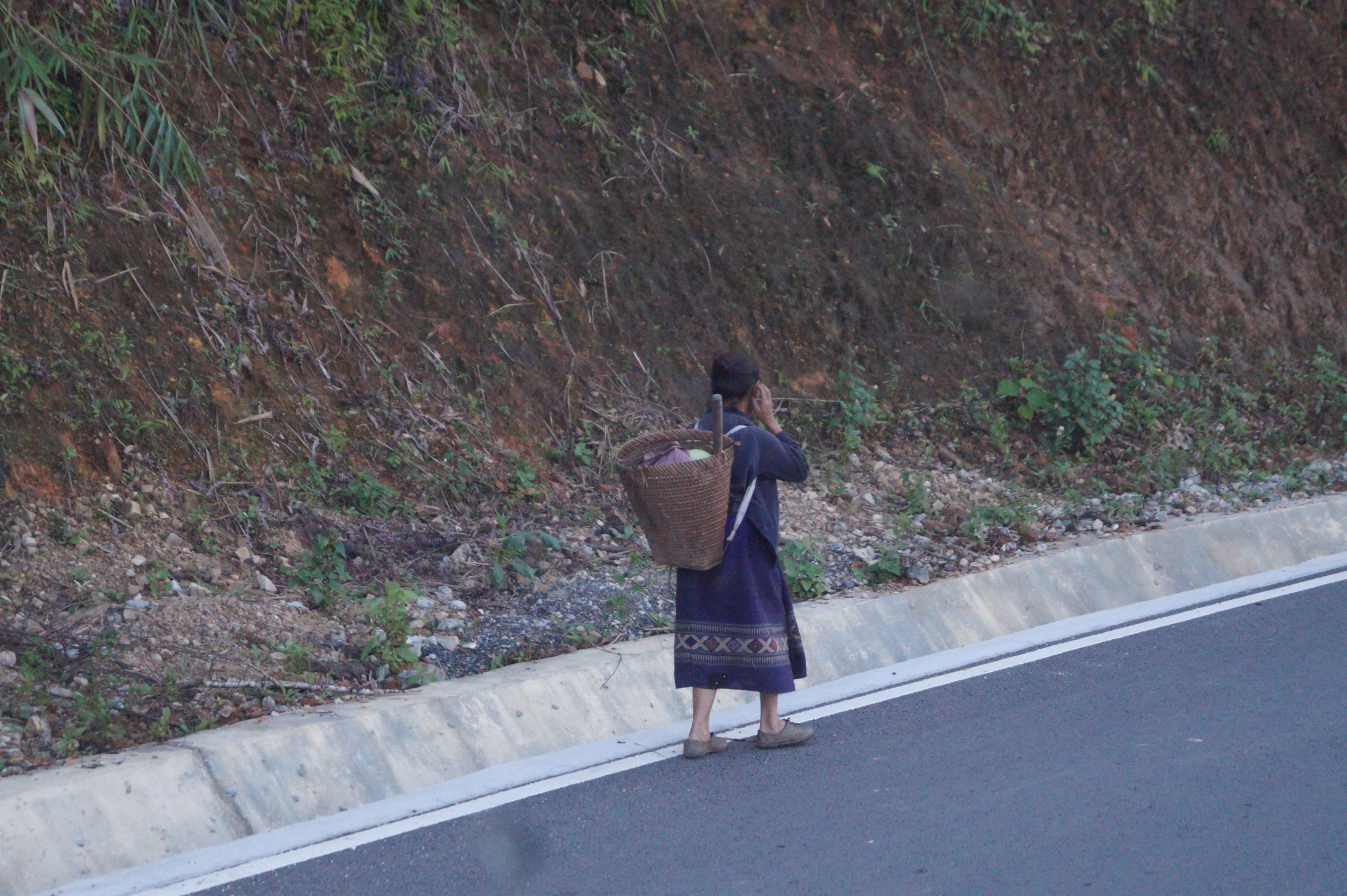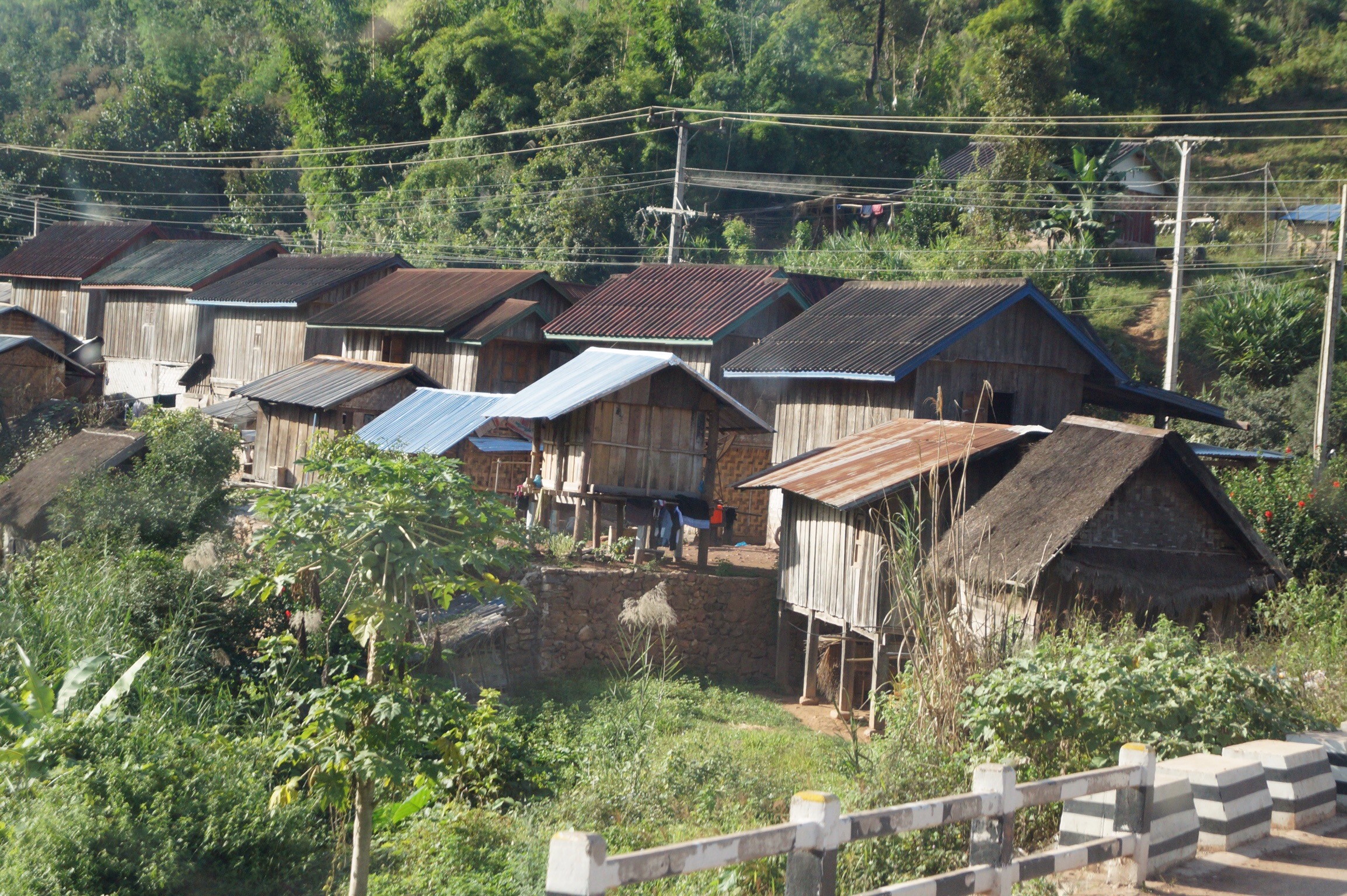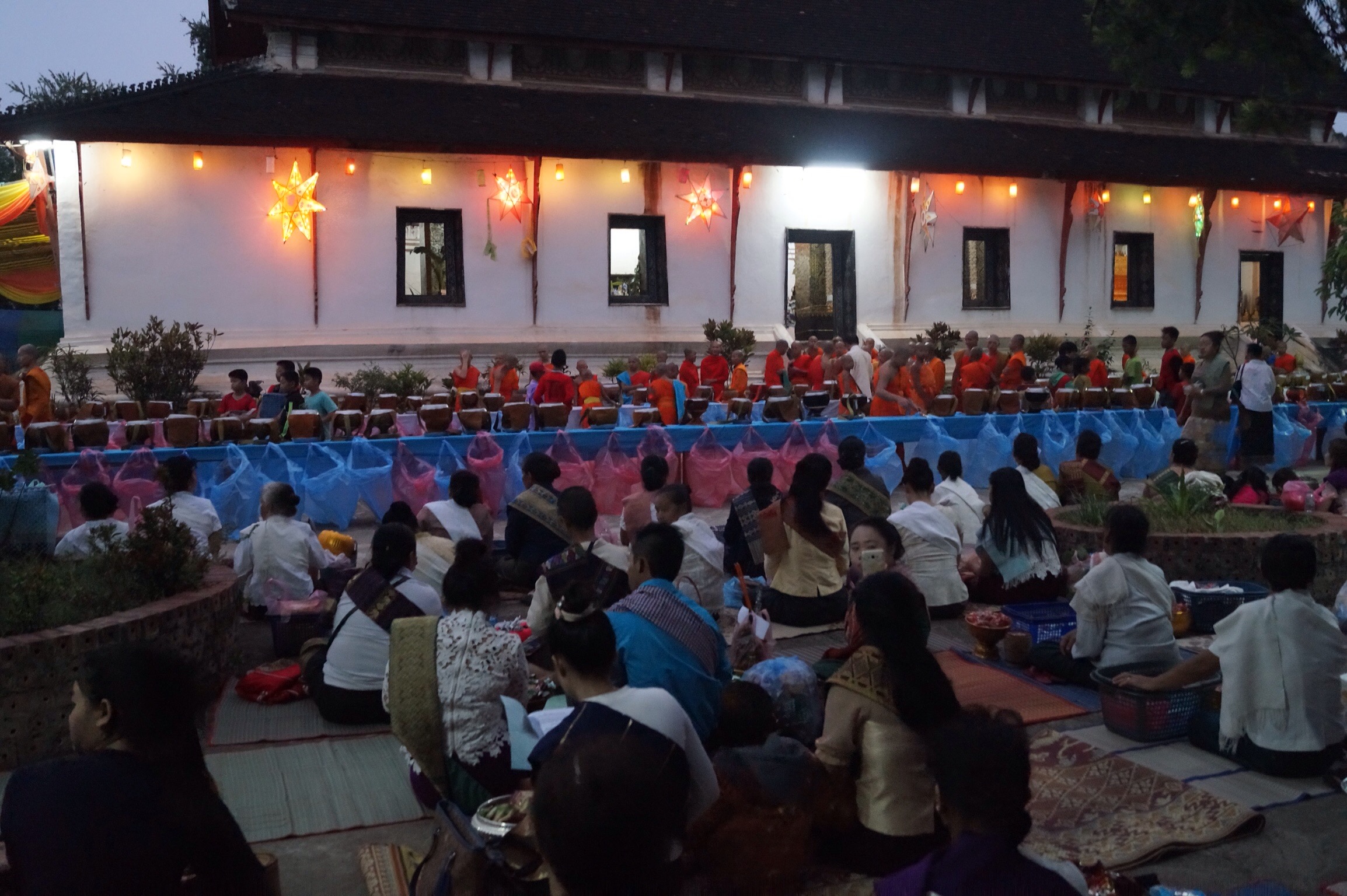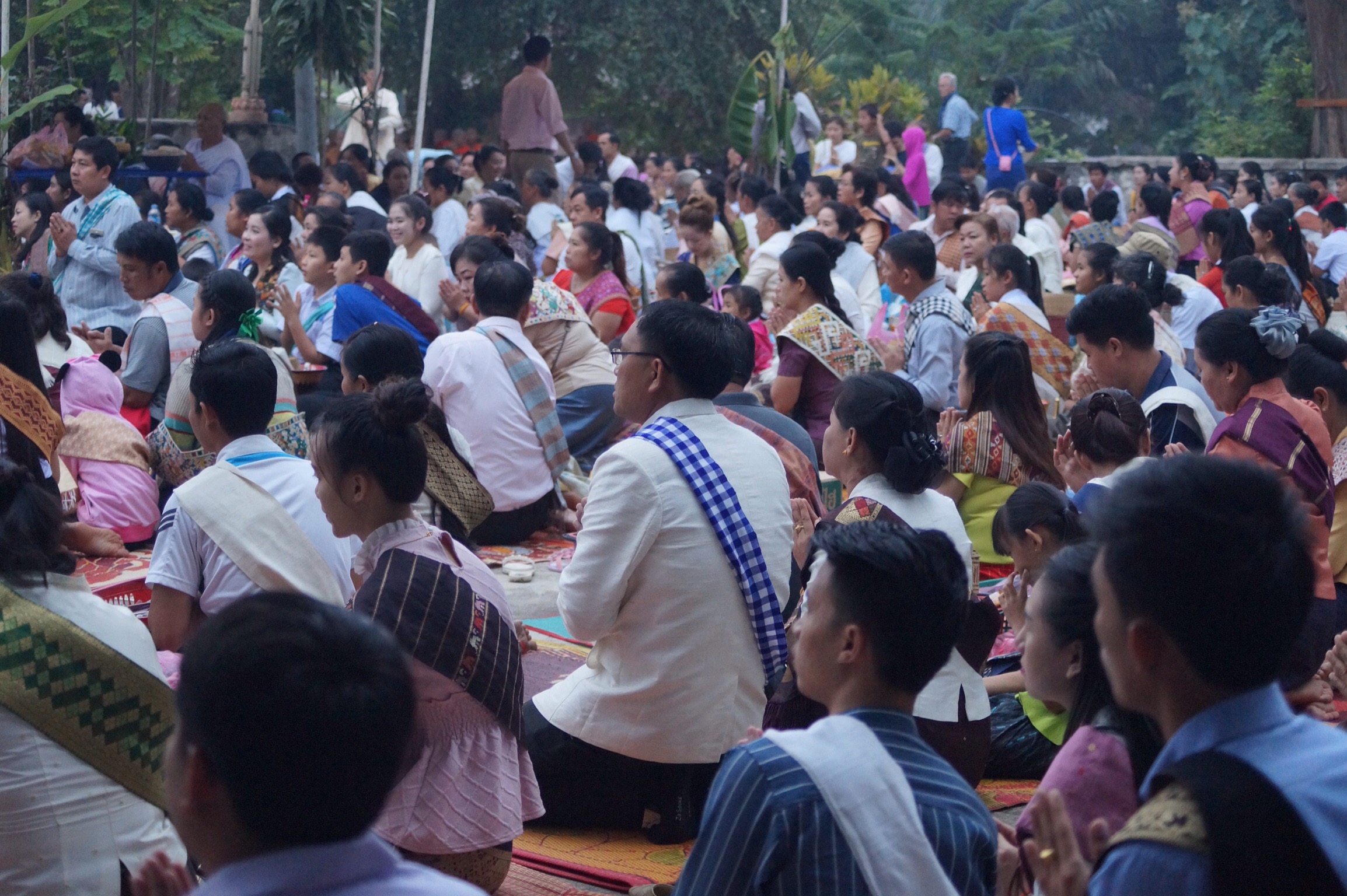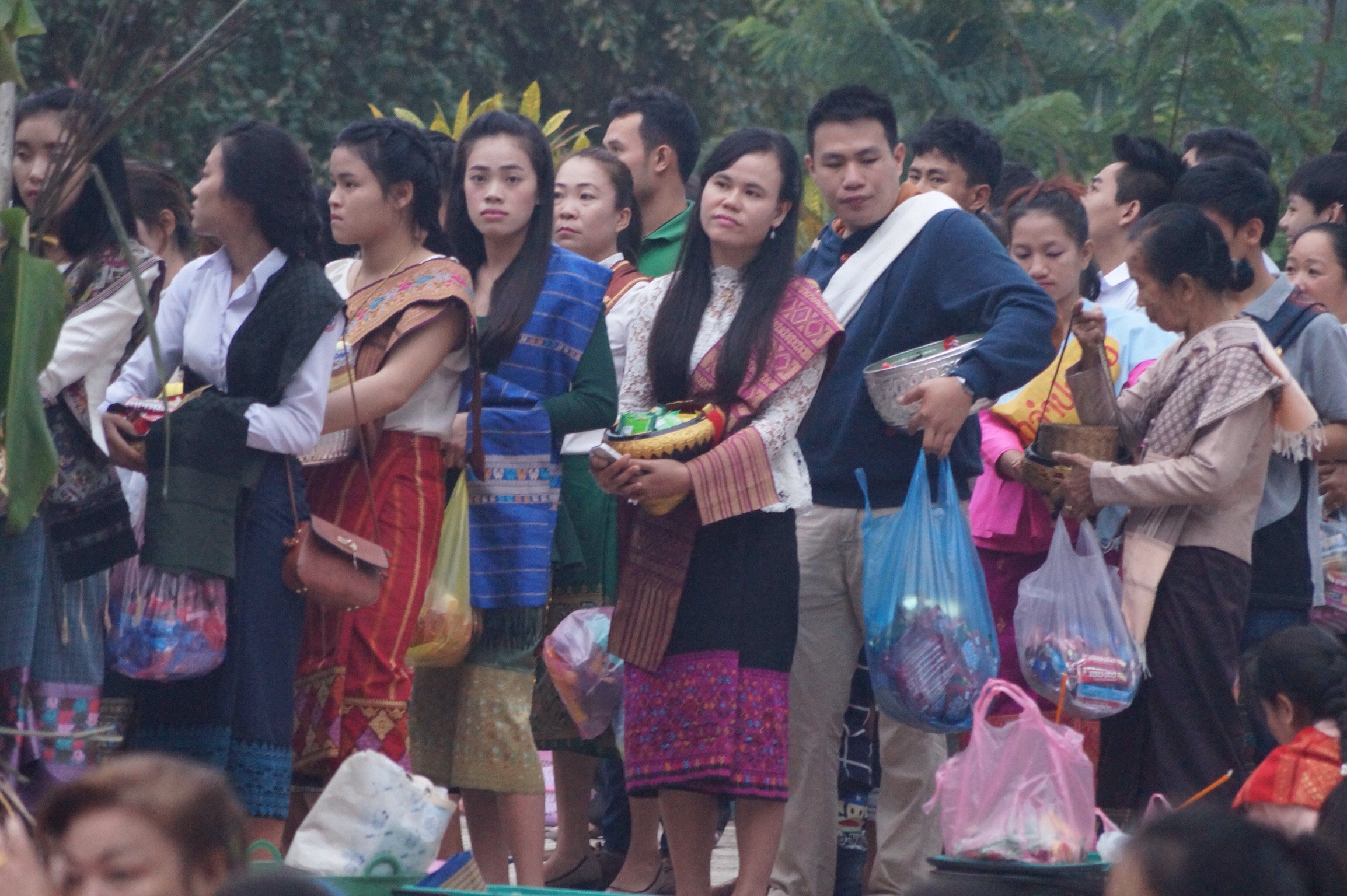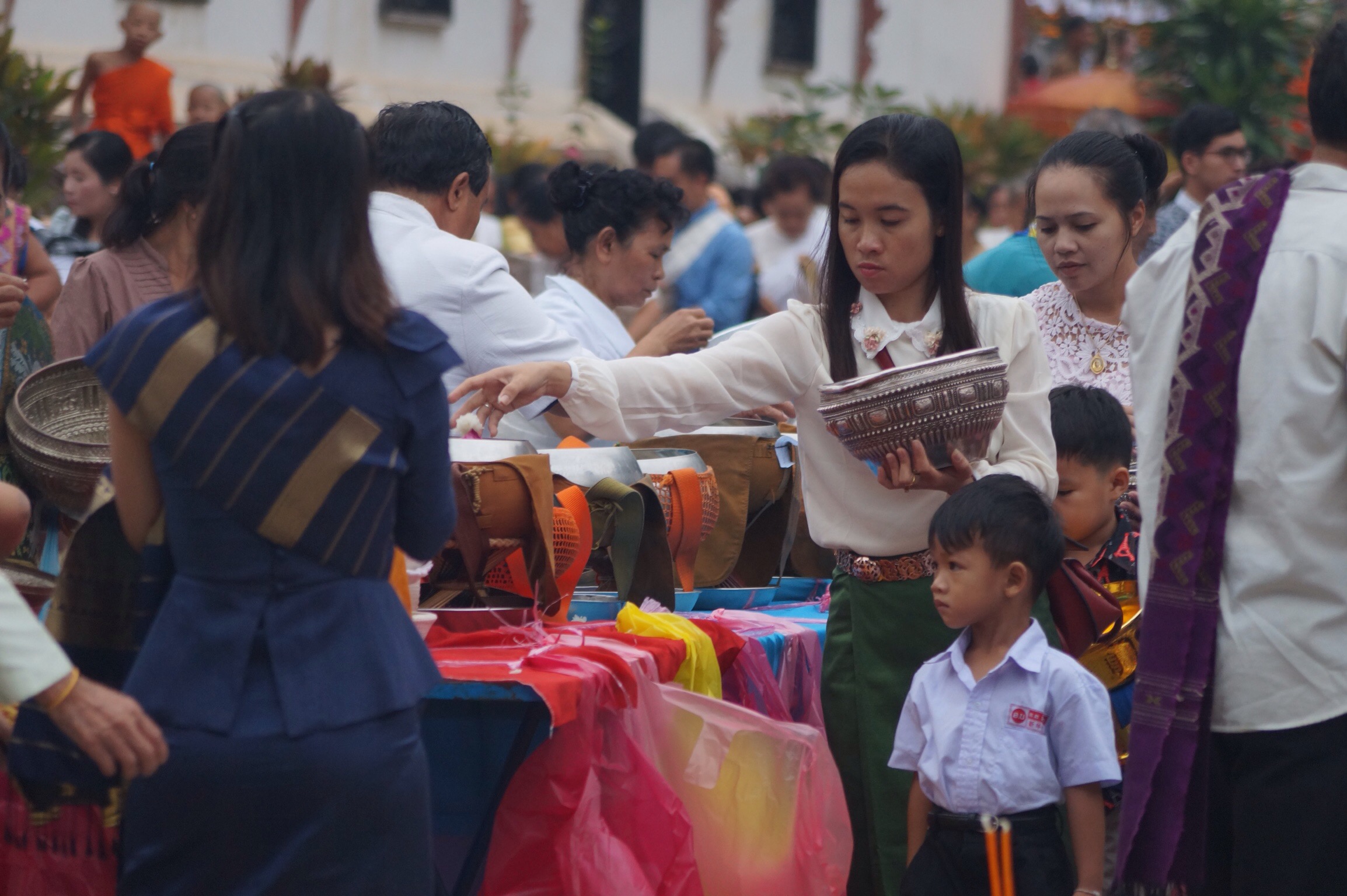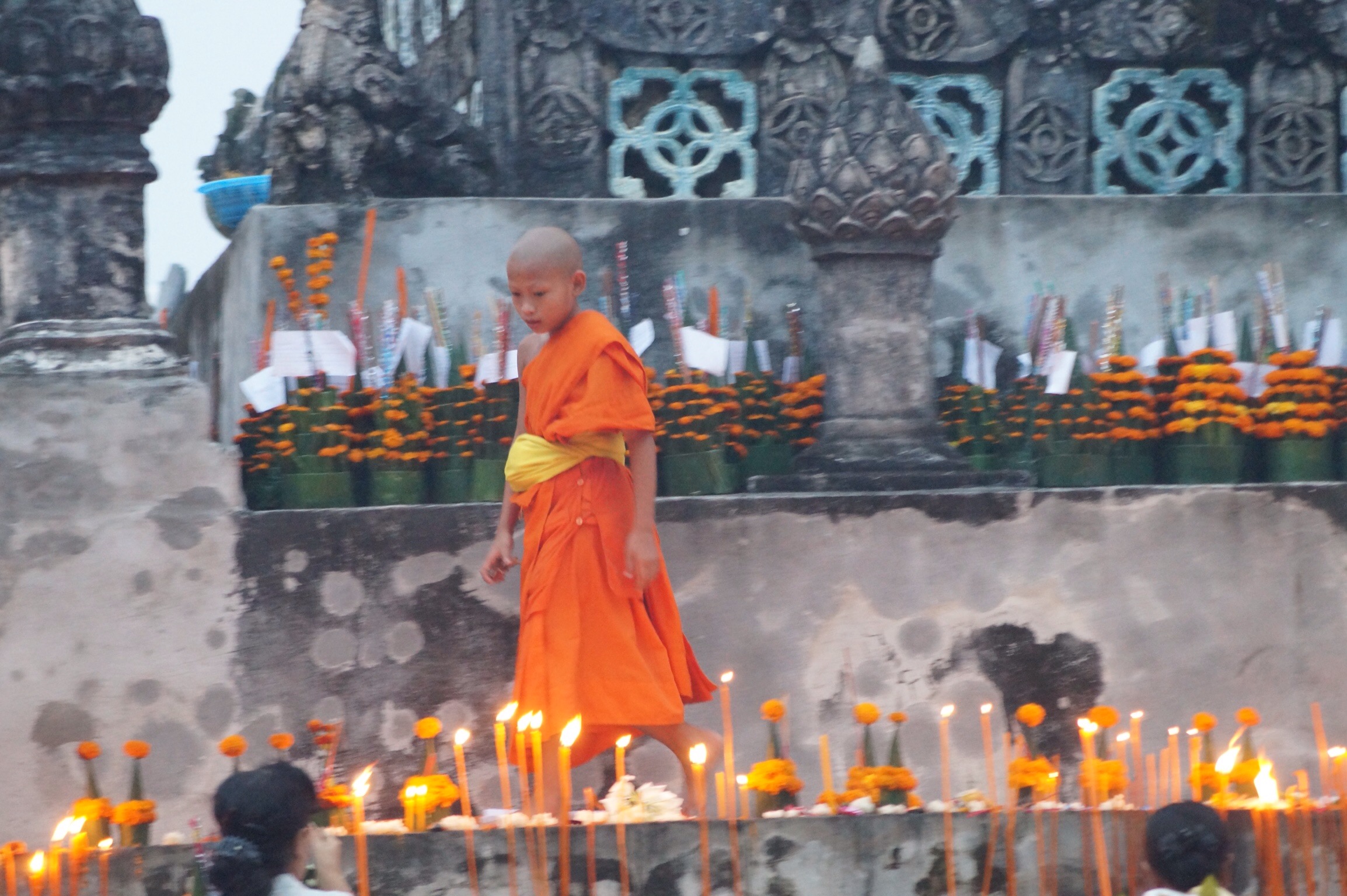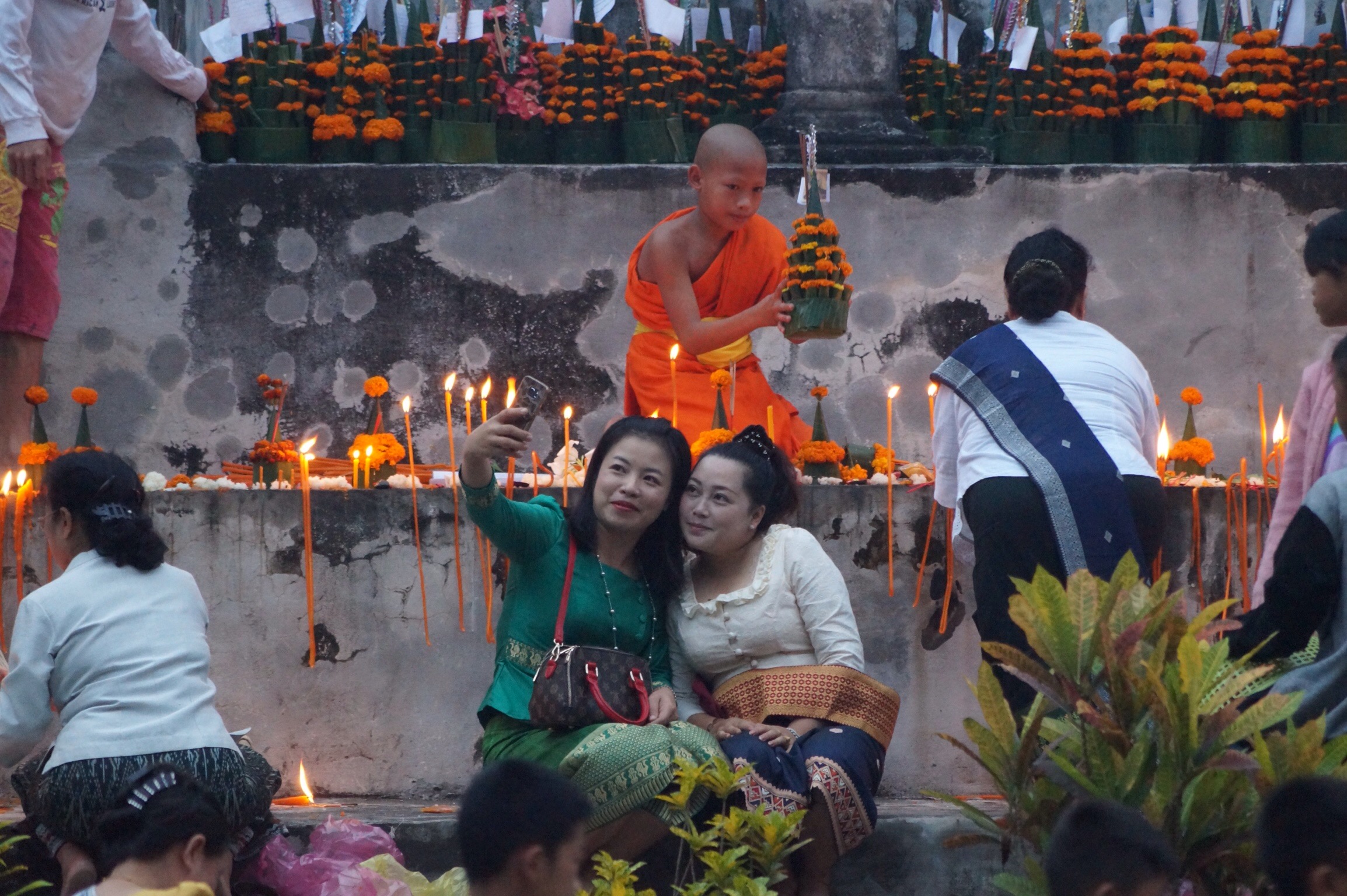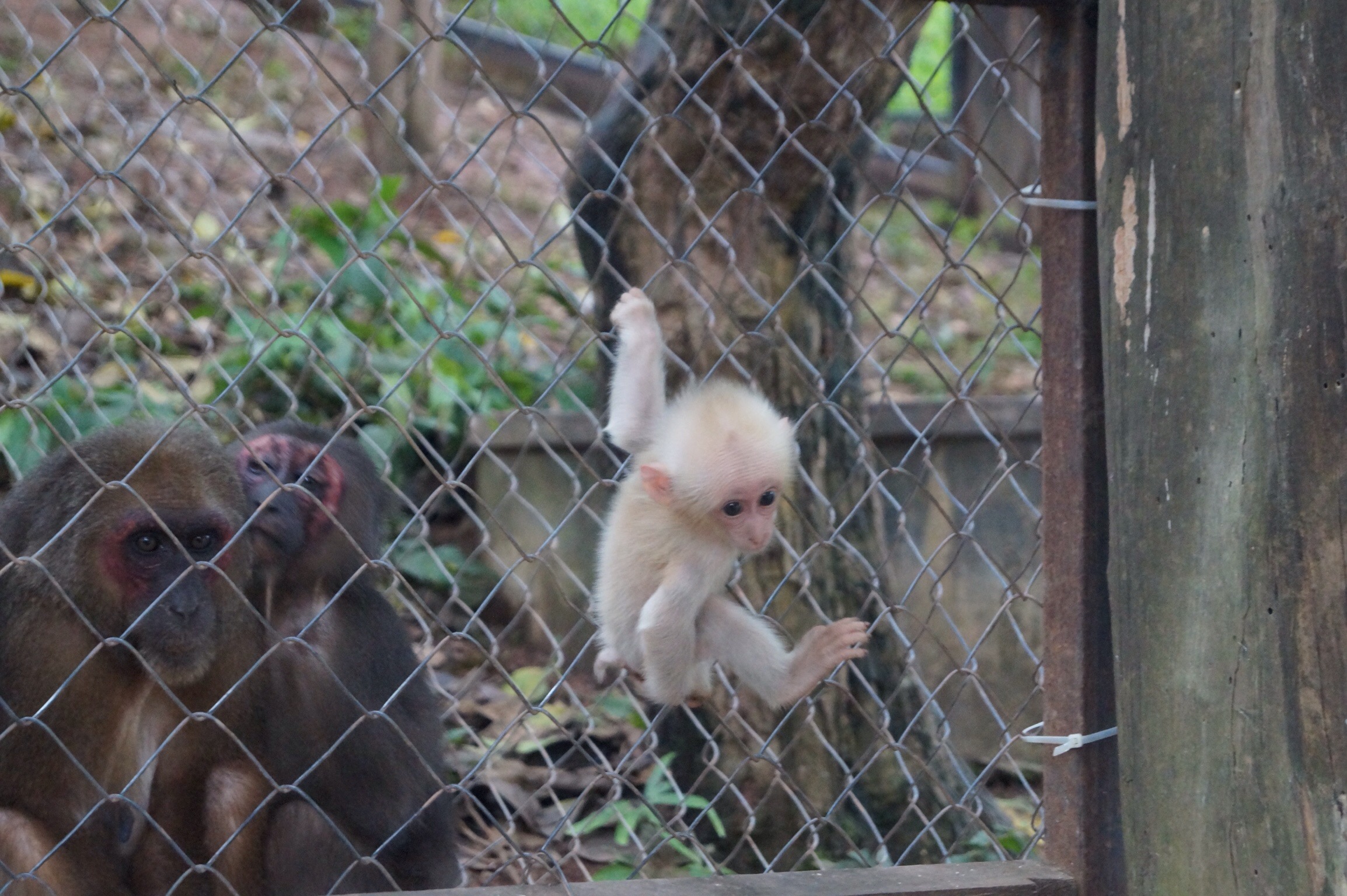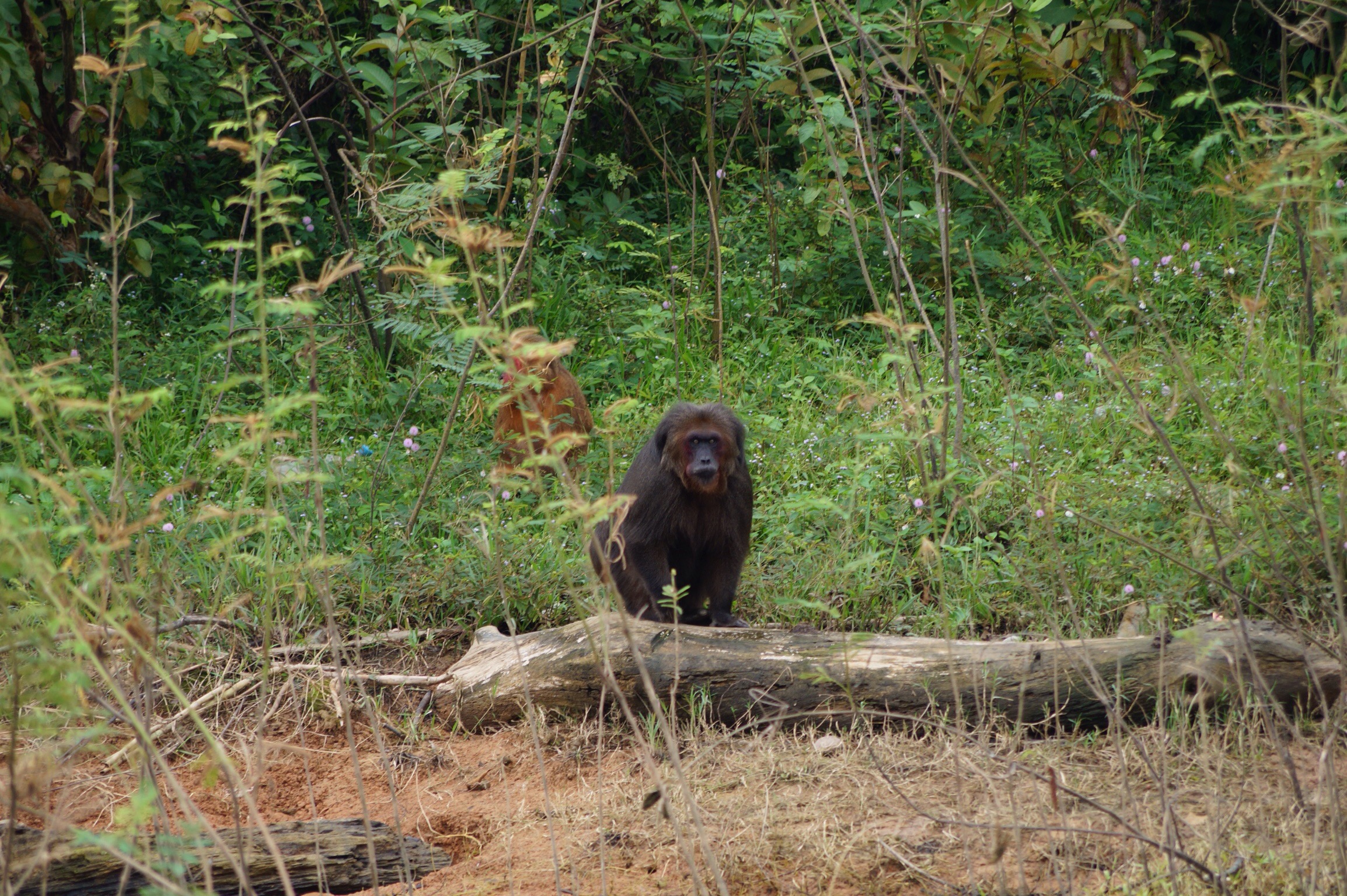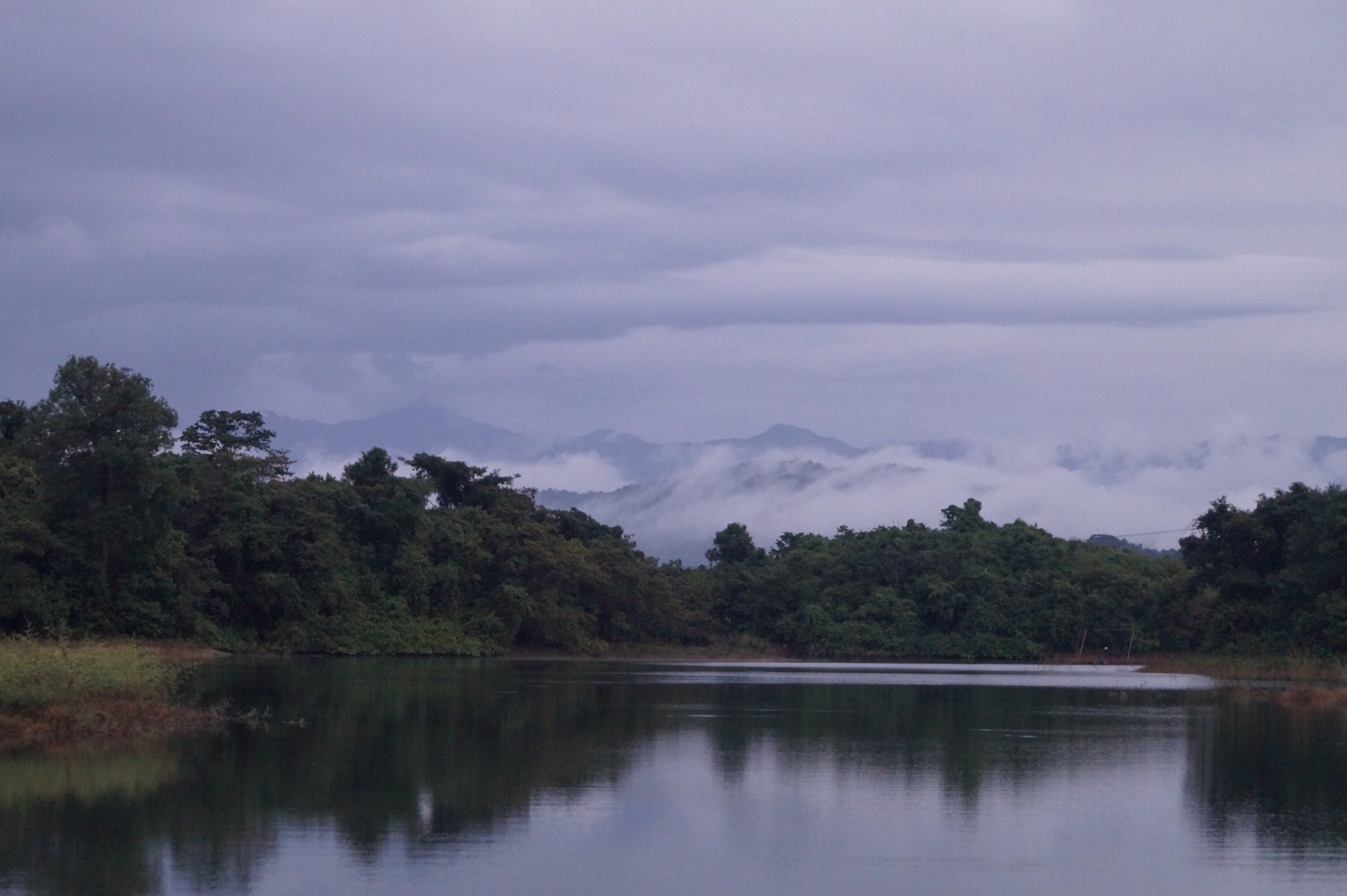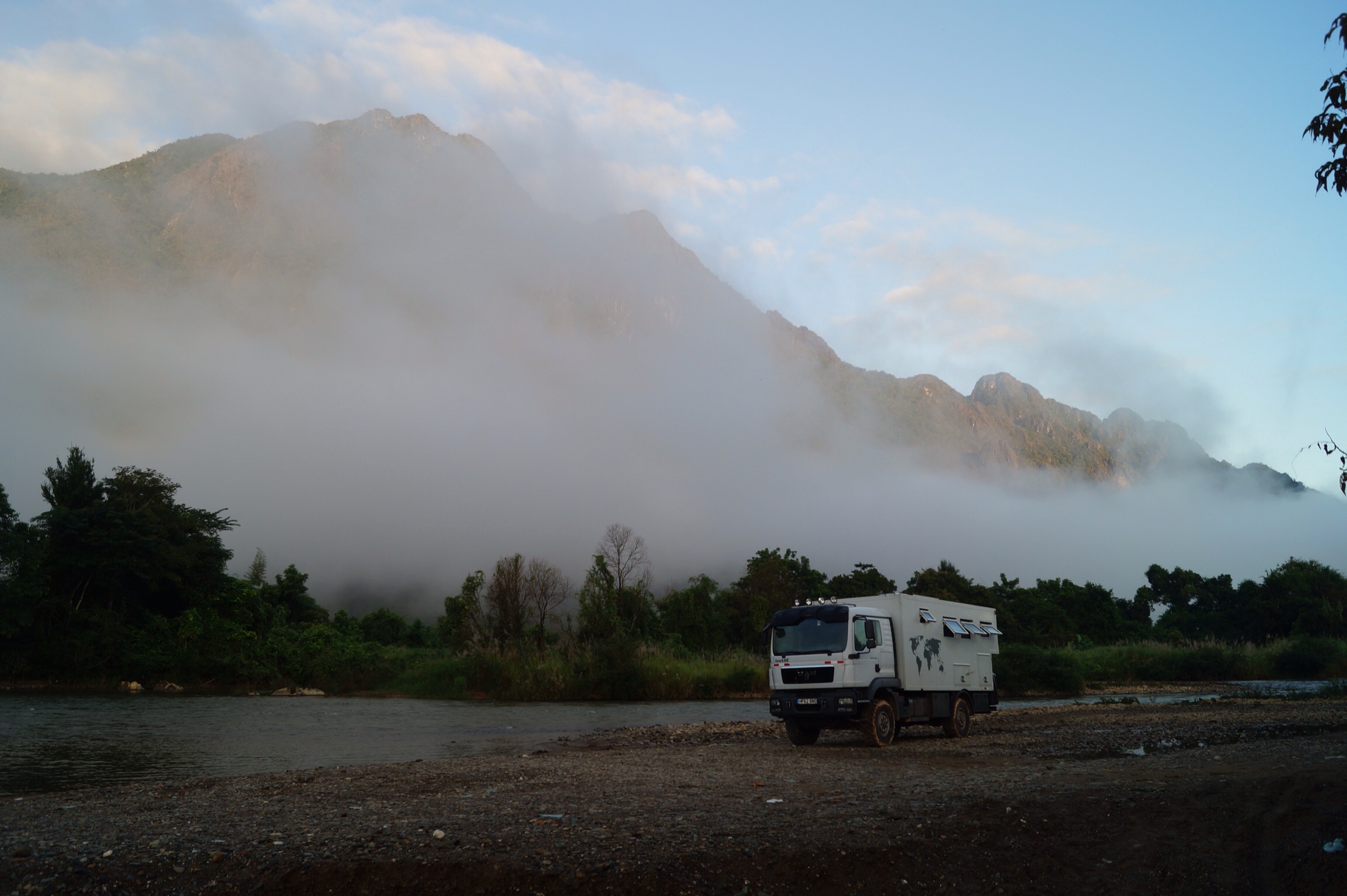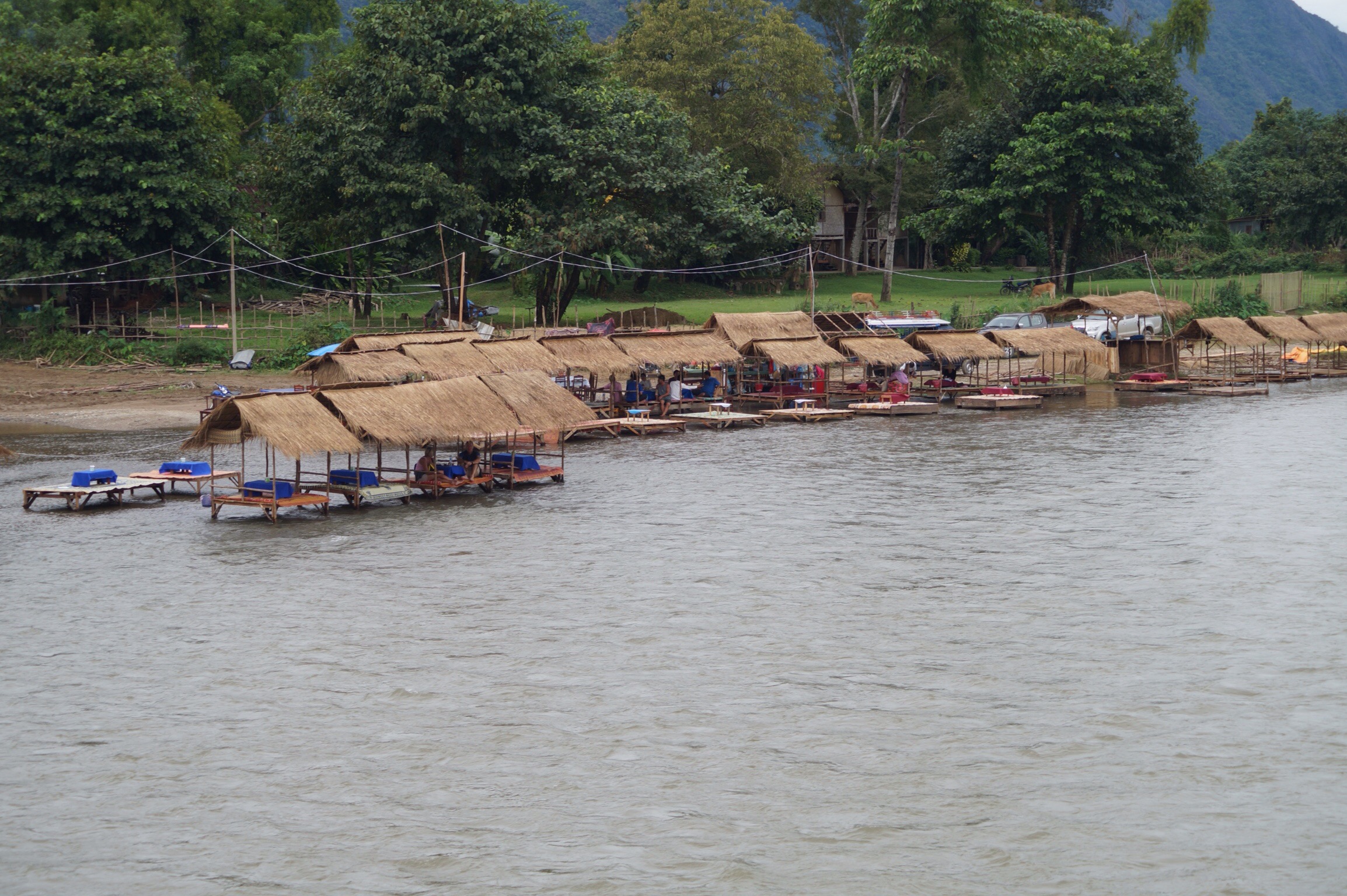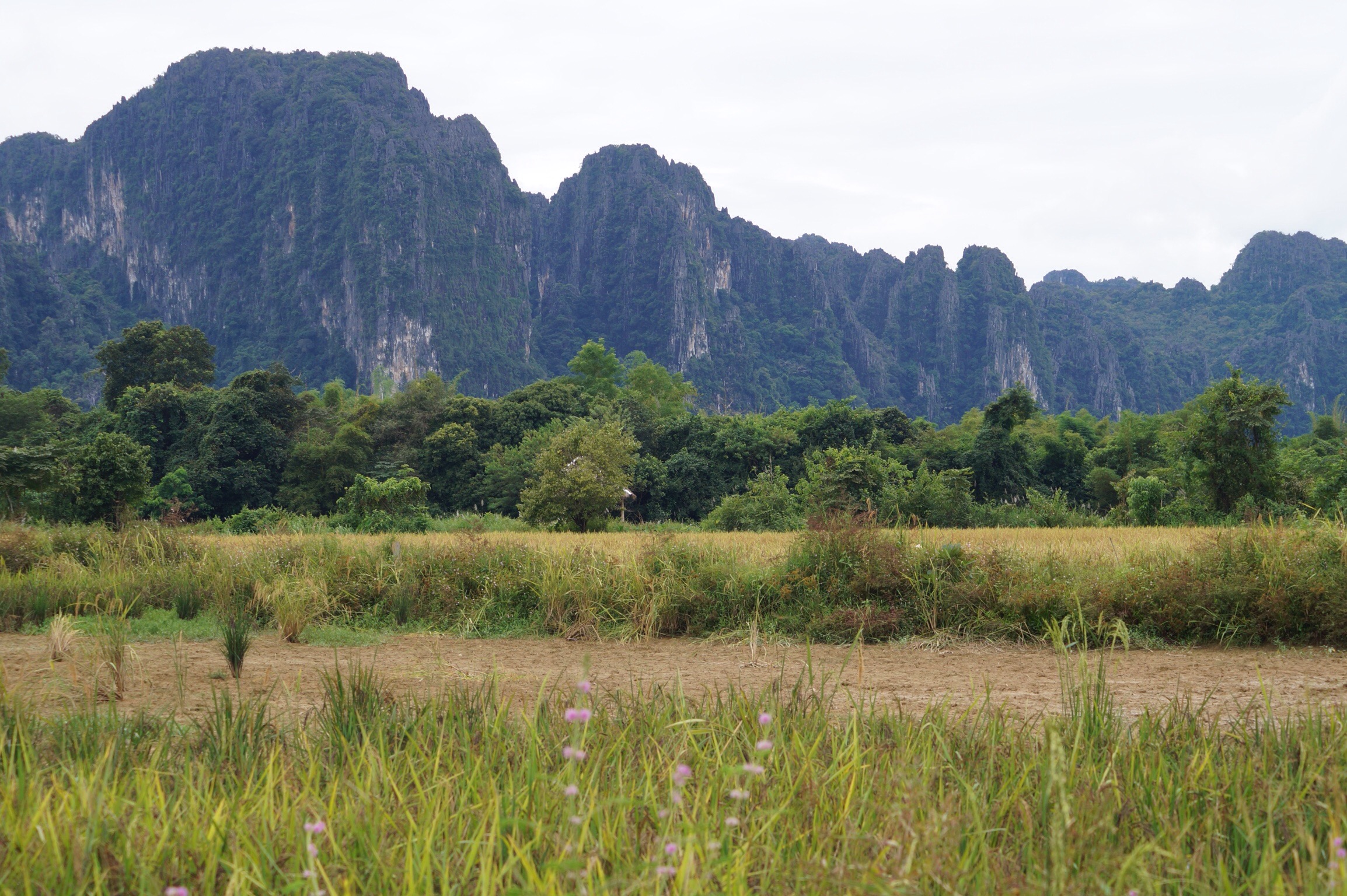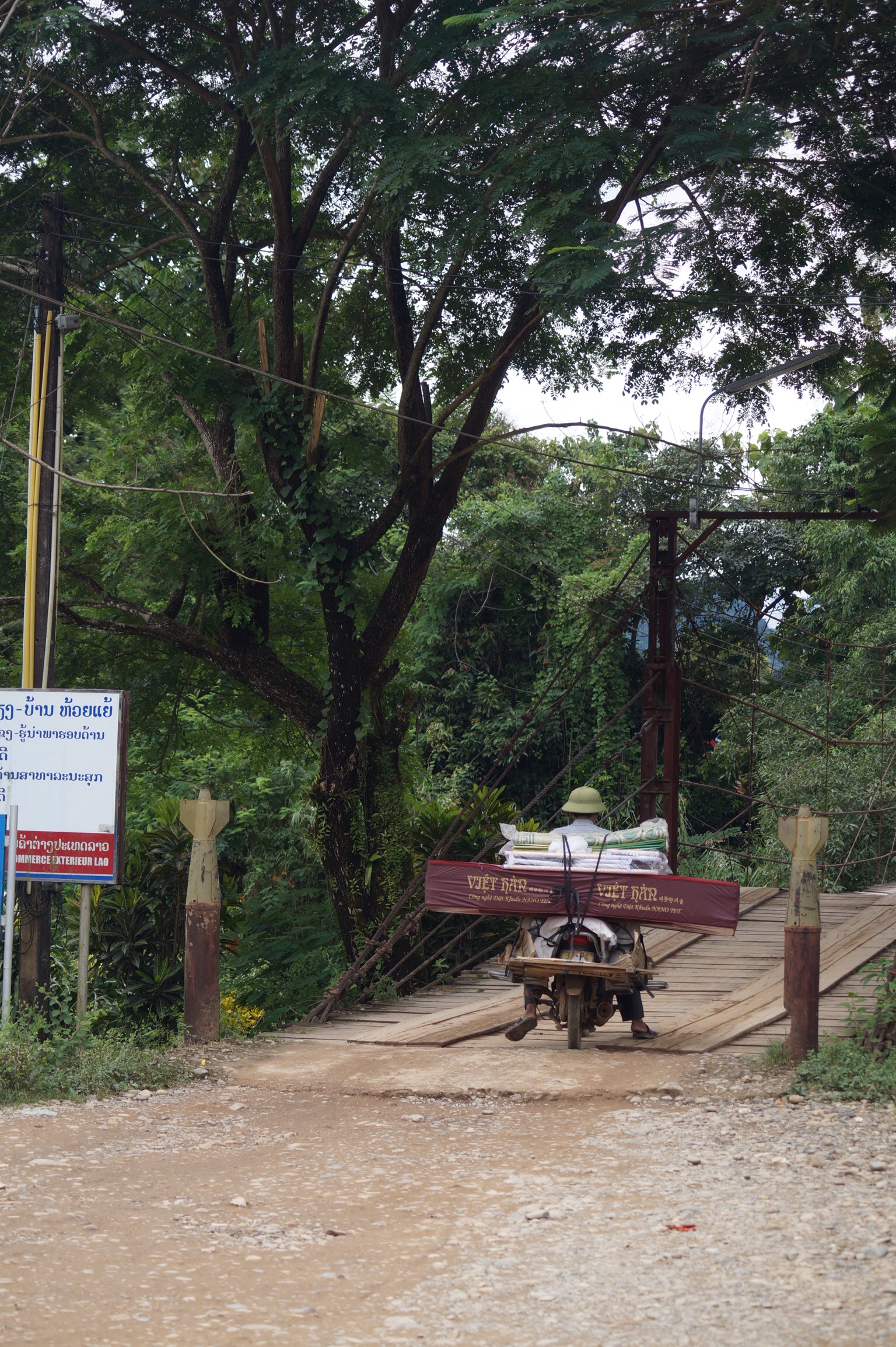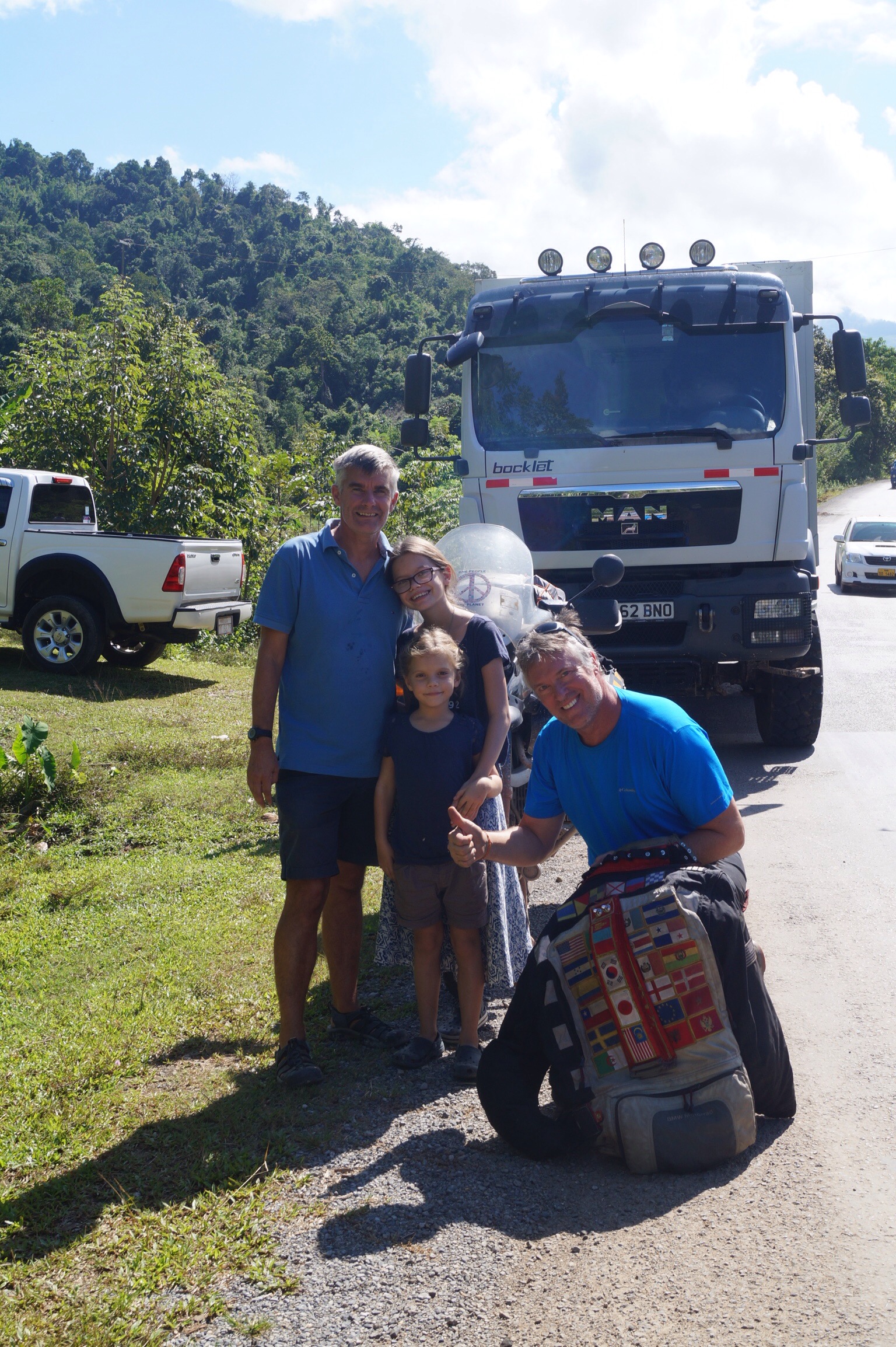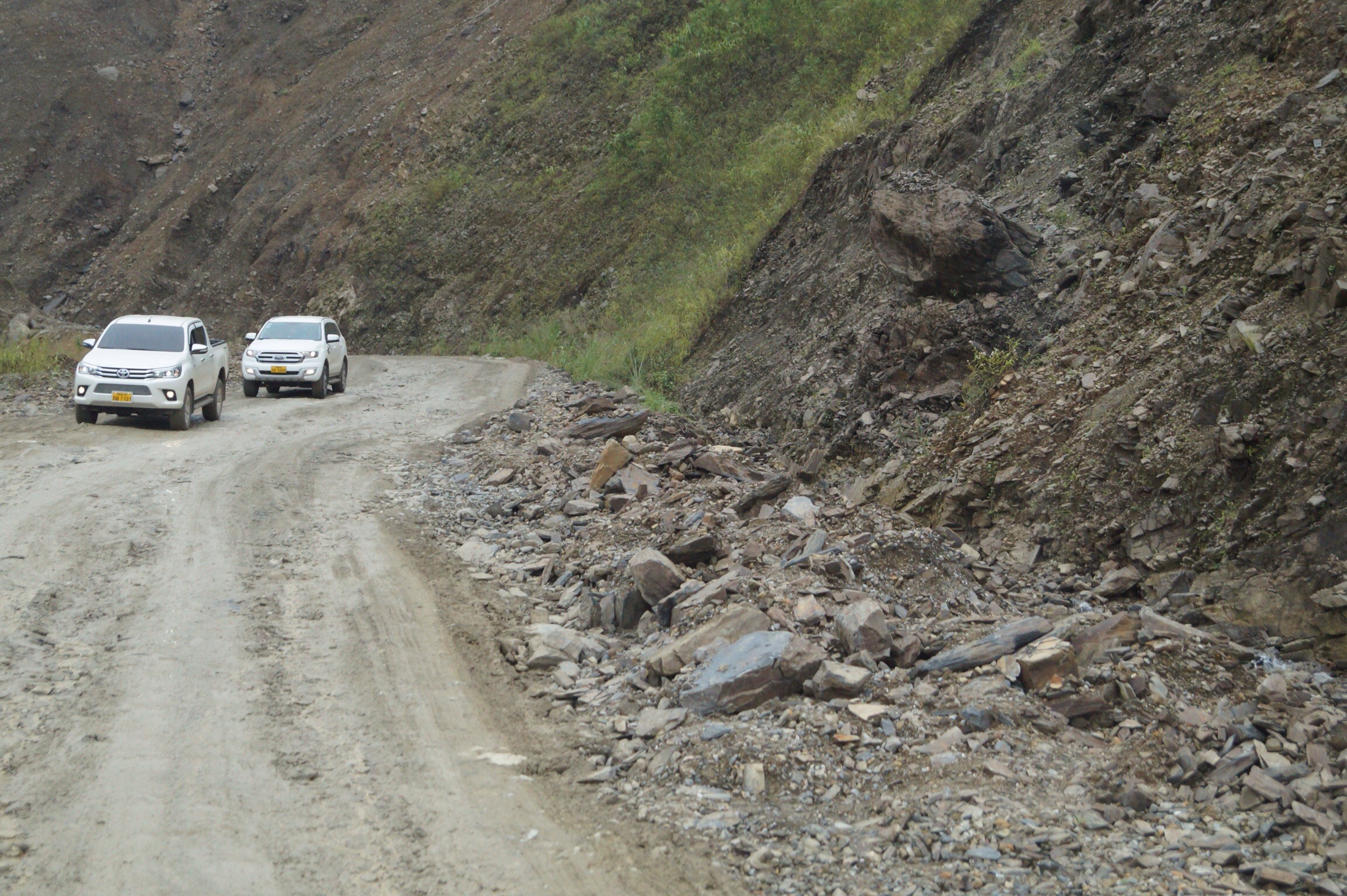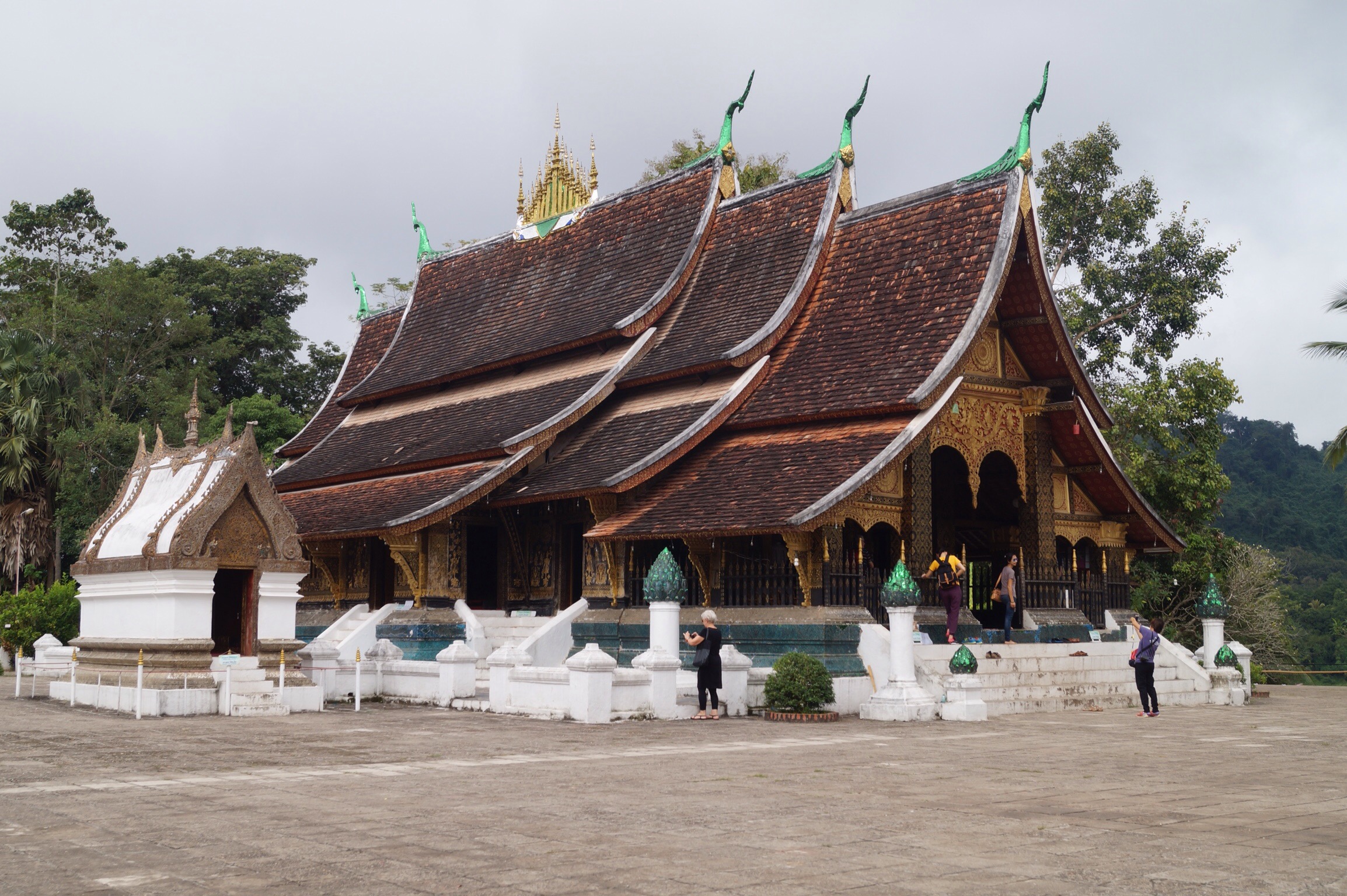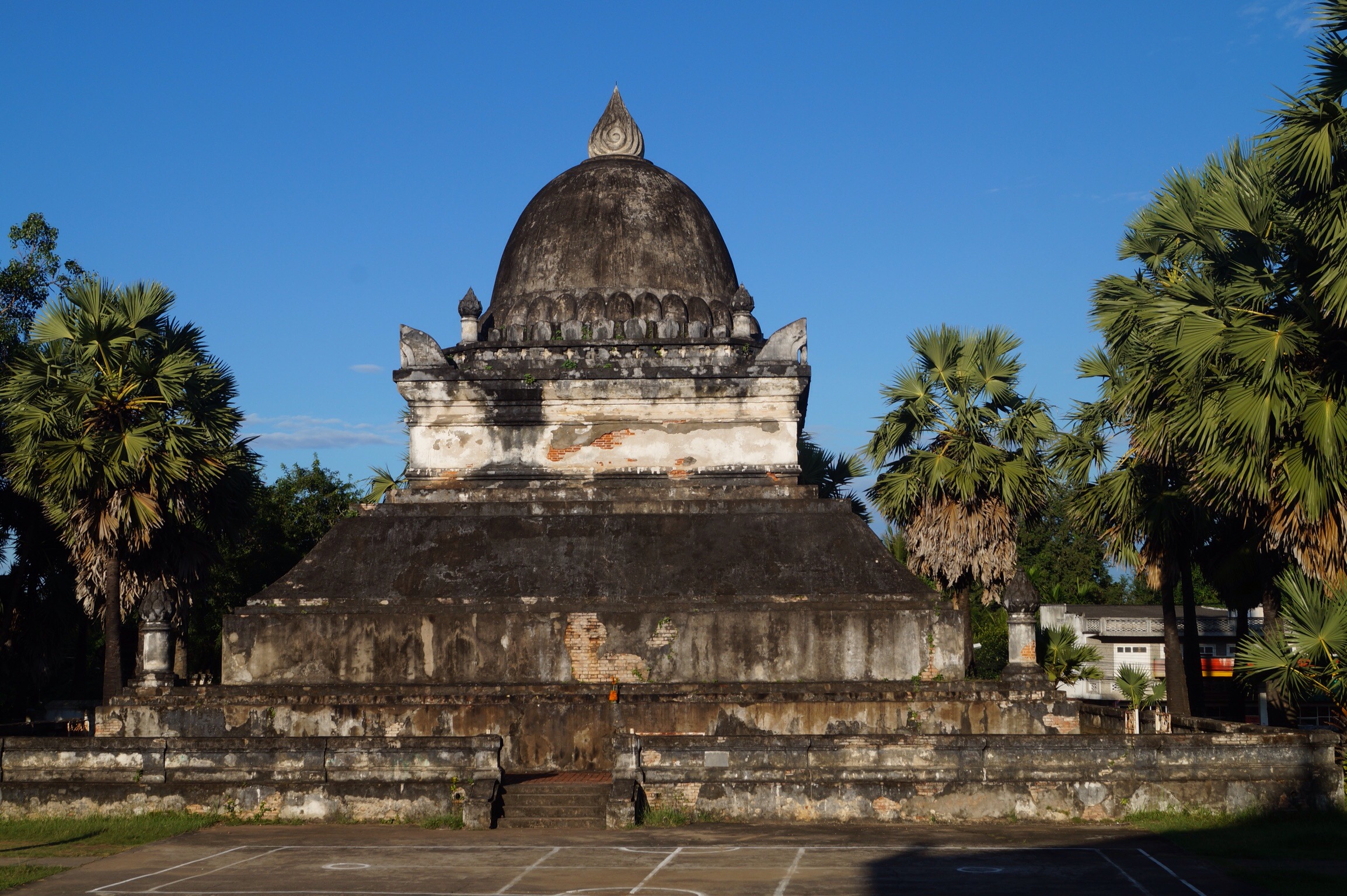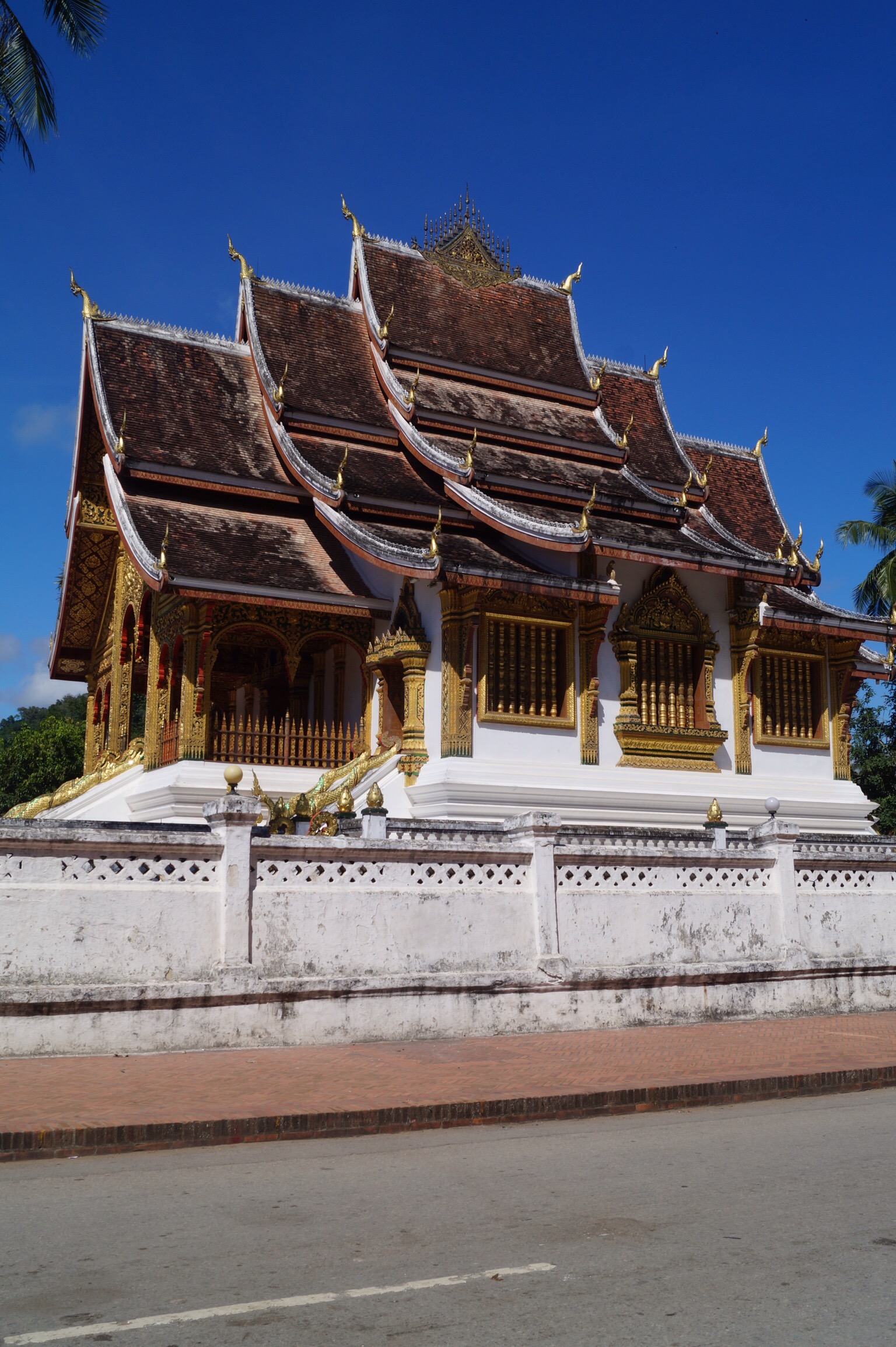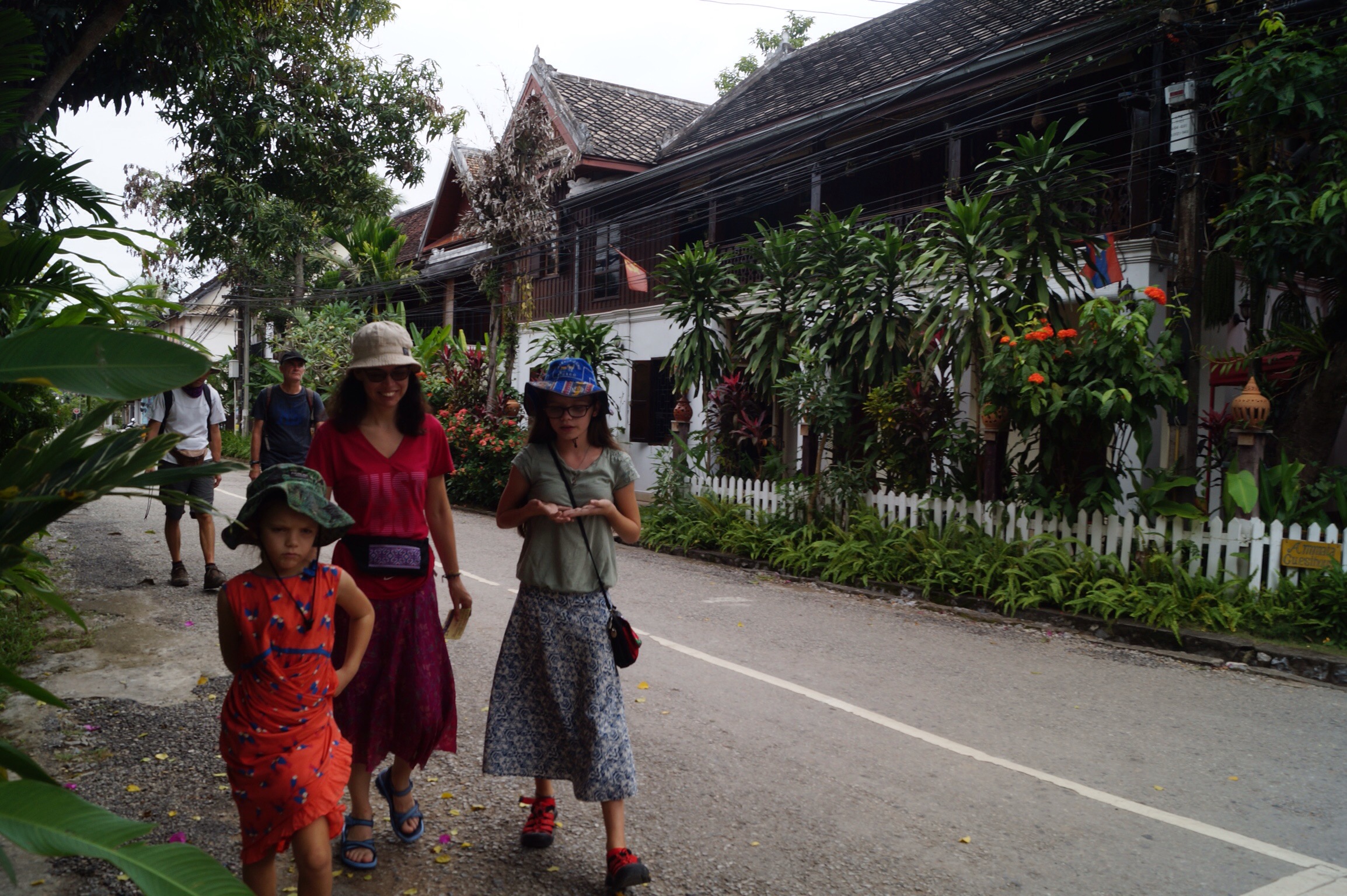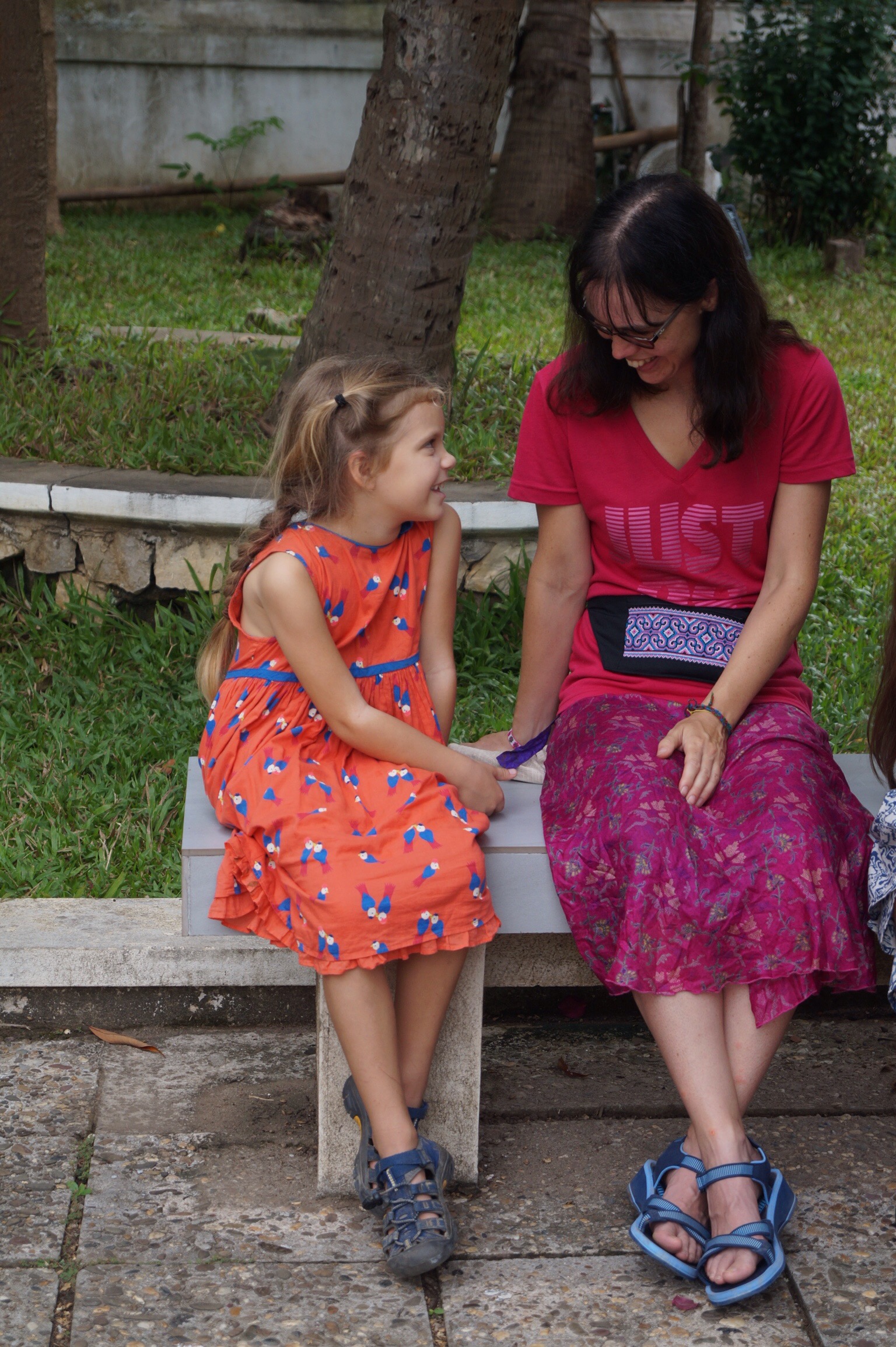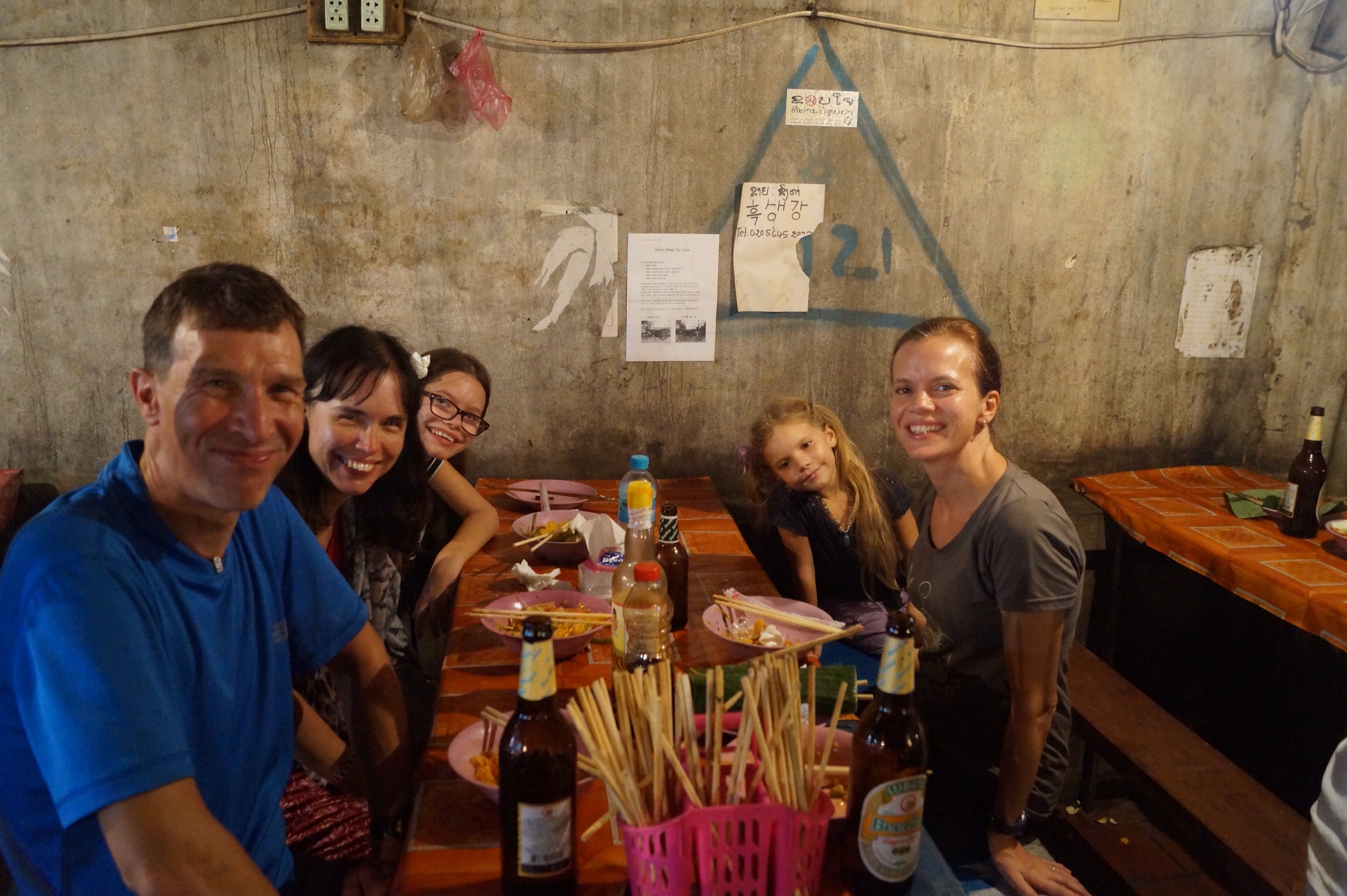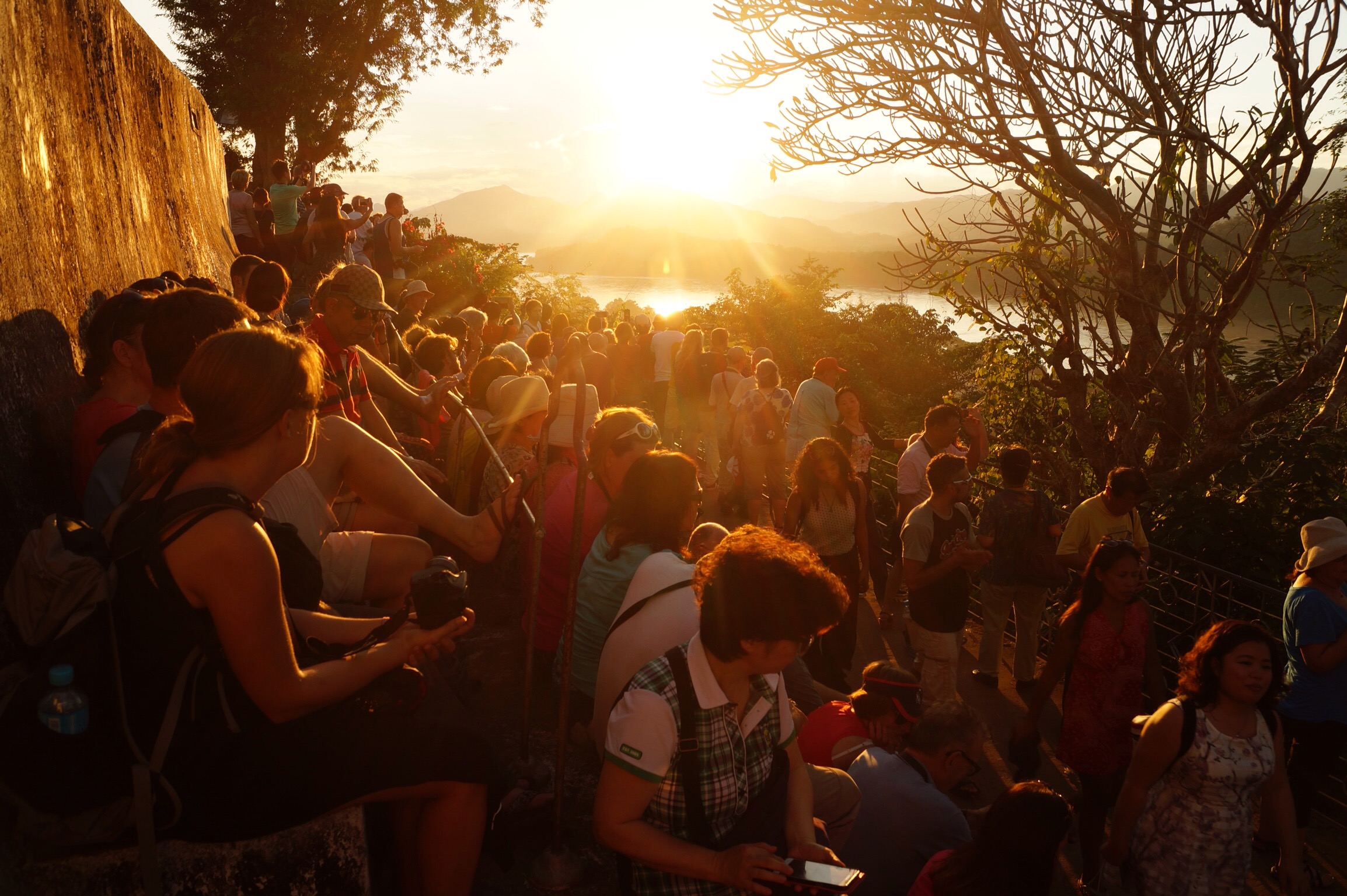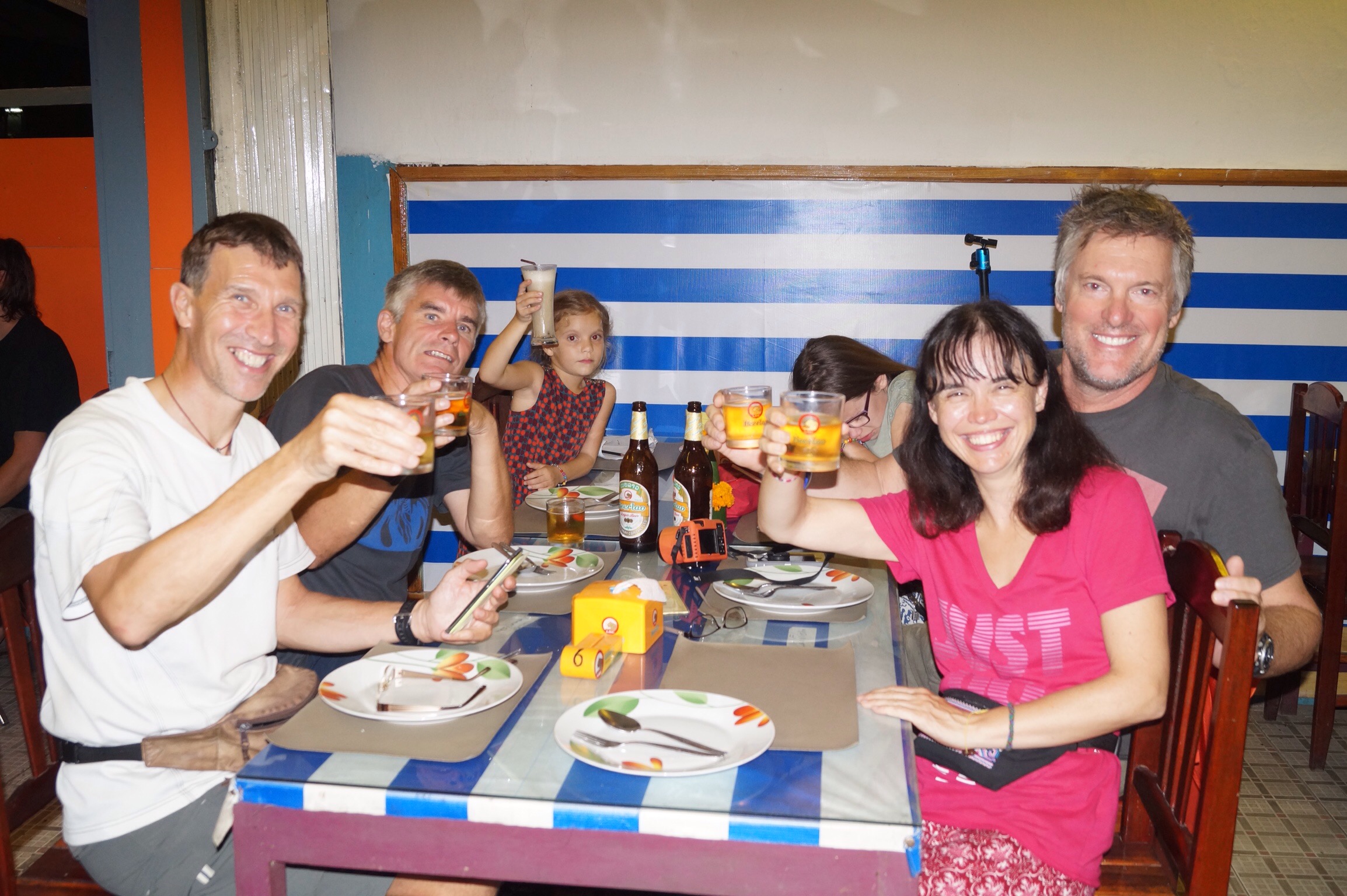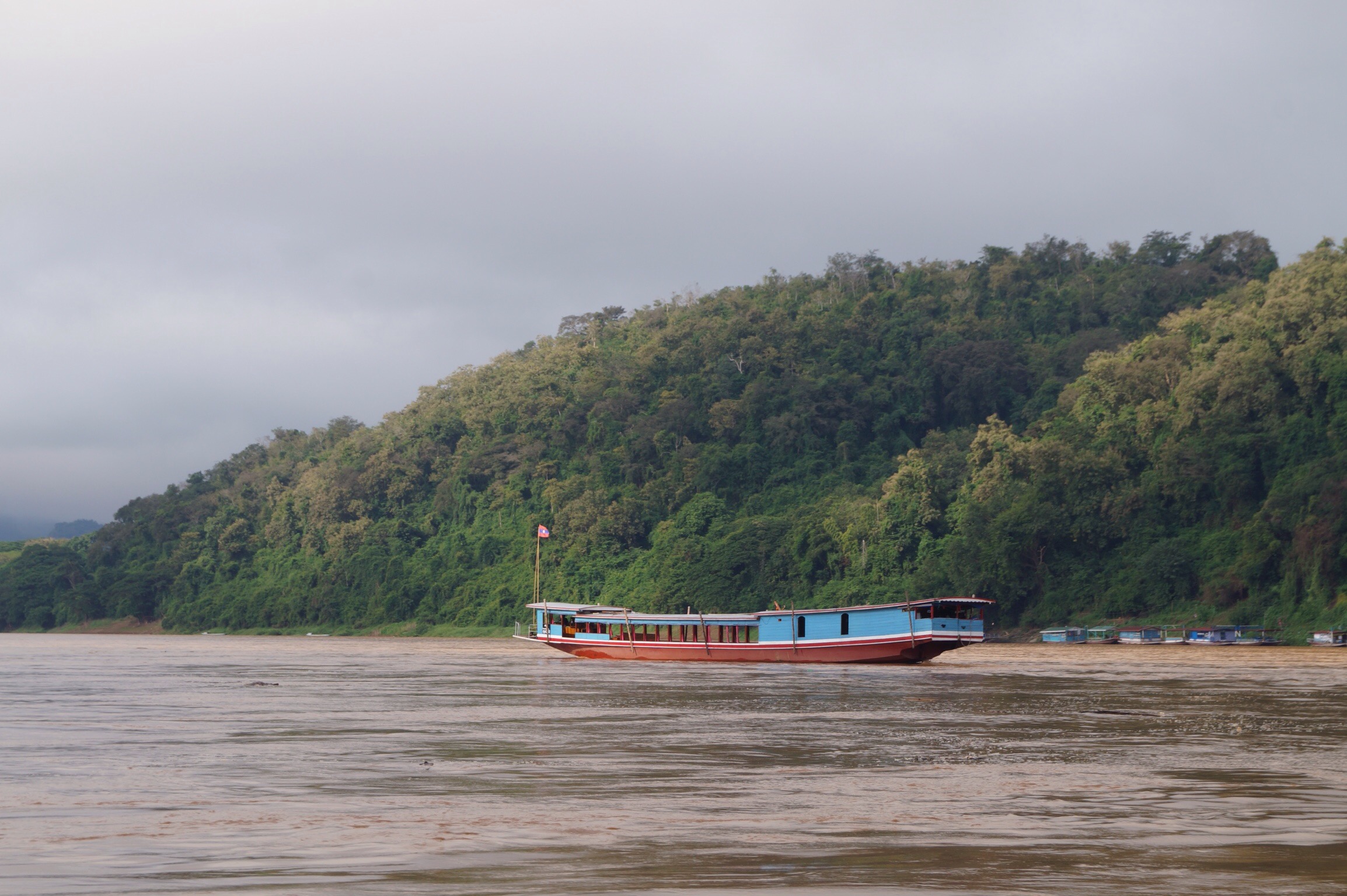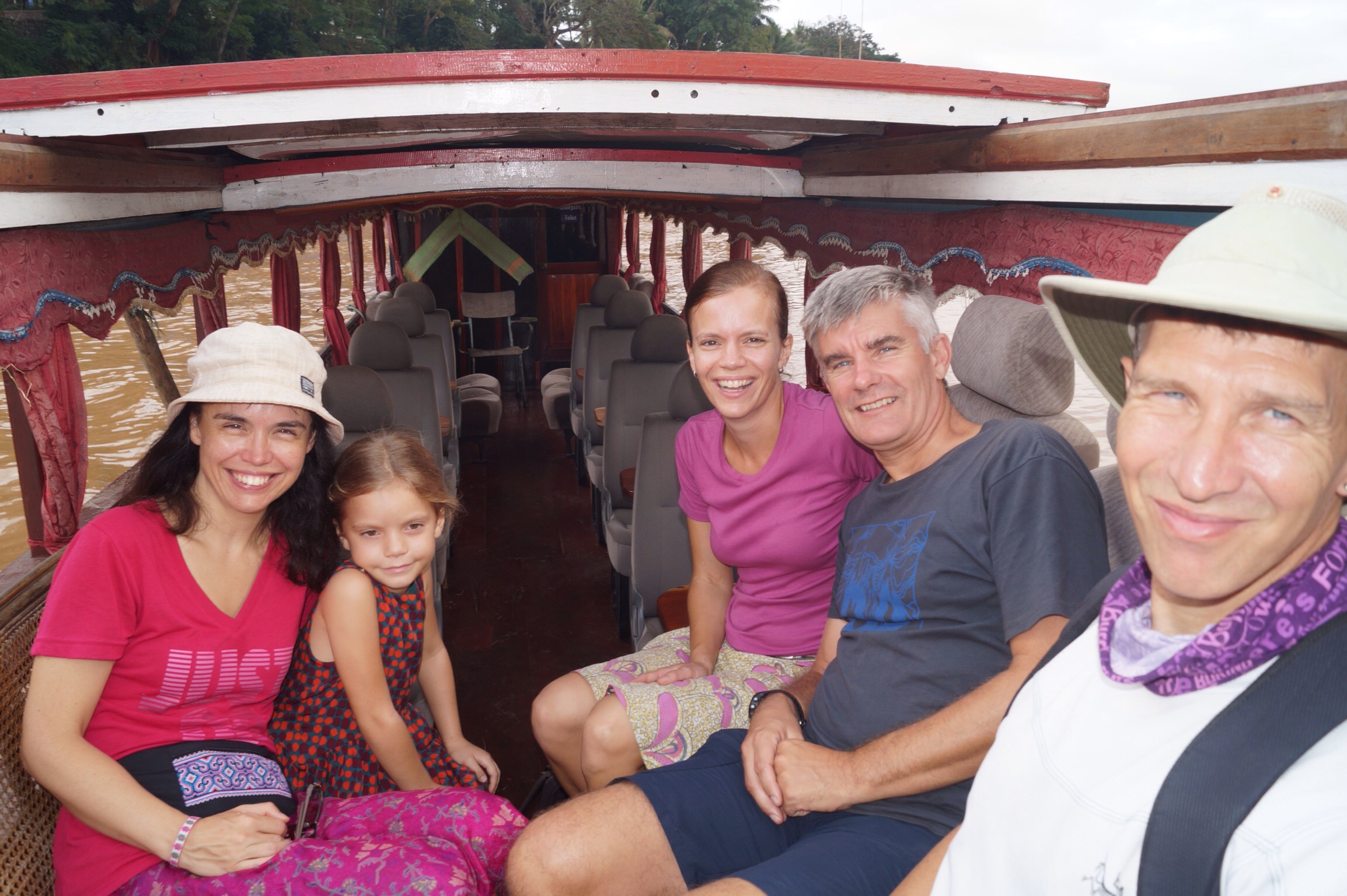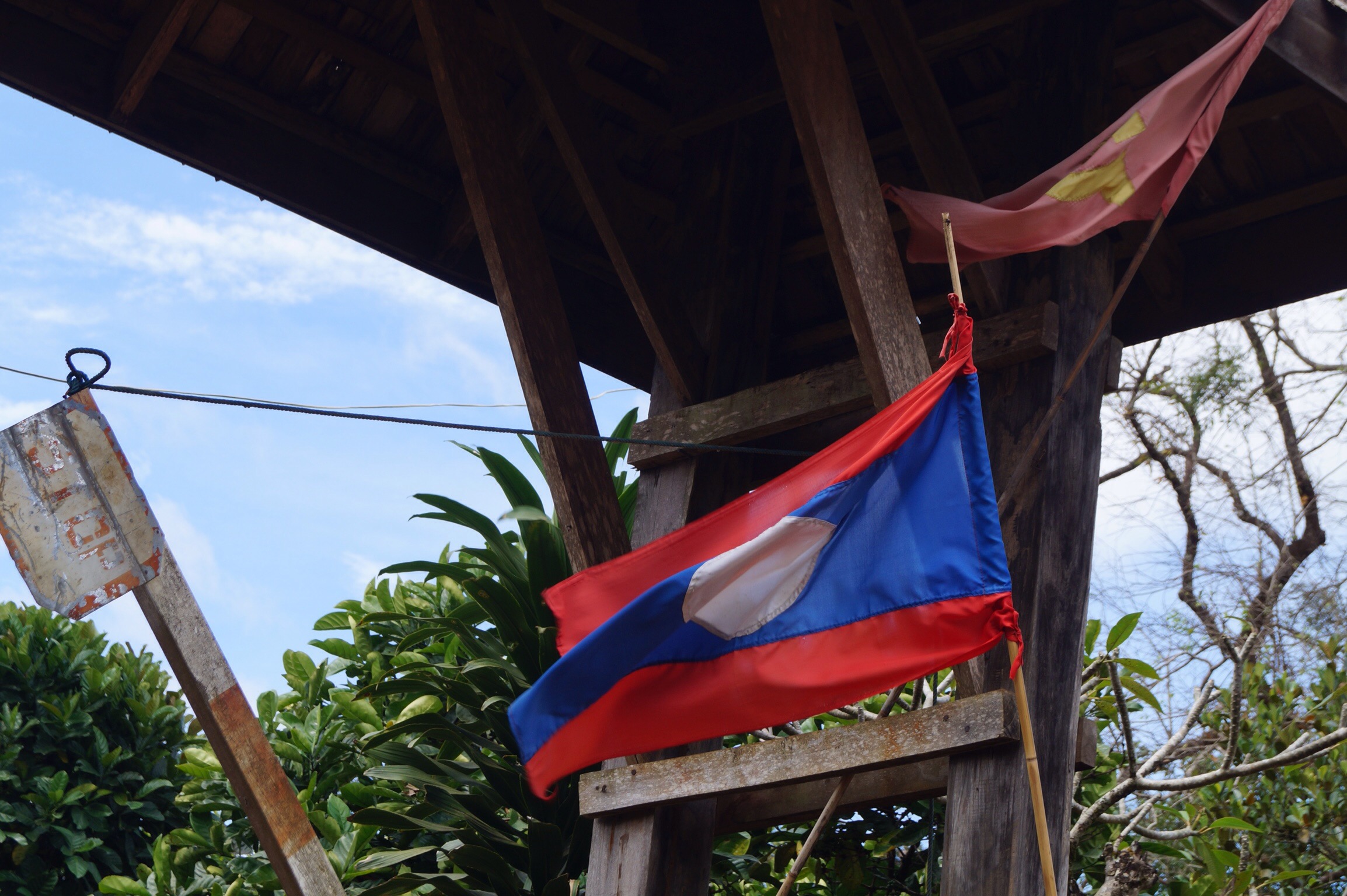
Lucy
We crossed a river as we entered Laos and went to an island. One of the first things we saw was some beautiful kittens, the island was full of lovely cats and puppies. As we walked around the islands we saw pigs, cows, chickens, goats and water buffaloes. We walked through miles of rice paddies, where the rice was about to be harvested.
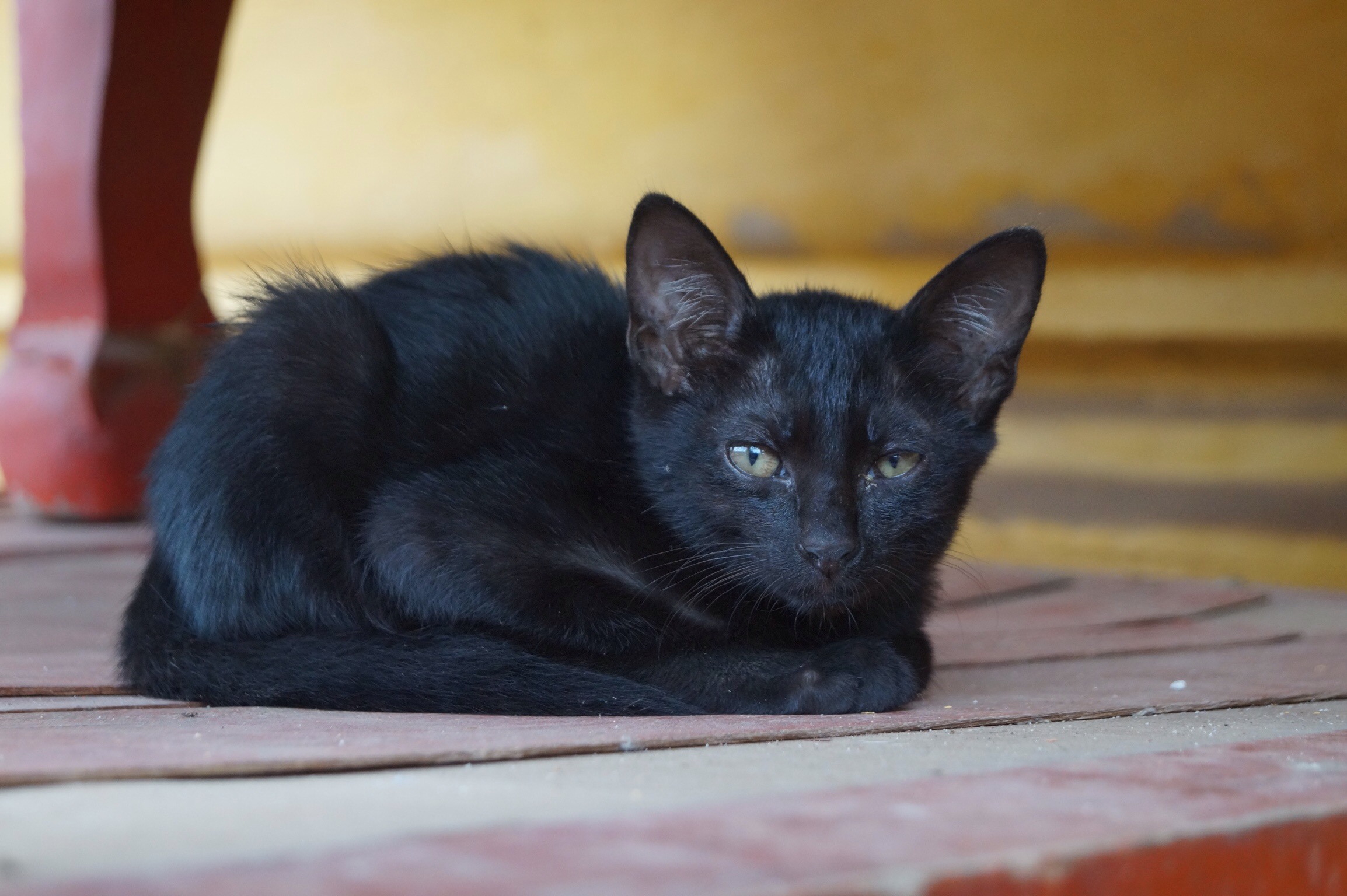
Before we met my Auntie Clare, we met a motorbiker who was travelling around the world, his name was Bob. When we saw my Auntie, we were so overjoyed. We went to the Night Market together in Luang Prabang, where we bought early Christmas presents. Once when we got up super early in the morning, it turned out there was a festival happening right next door, it was related to the full moon. We watched as all the monks put their bowls in a line on a table, while all the rest of the people put food in the bowls, an equal amount for each monk. There were other things that the monks might need, one lady brought some tissues, monks gets colds too.
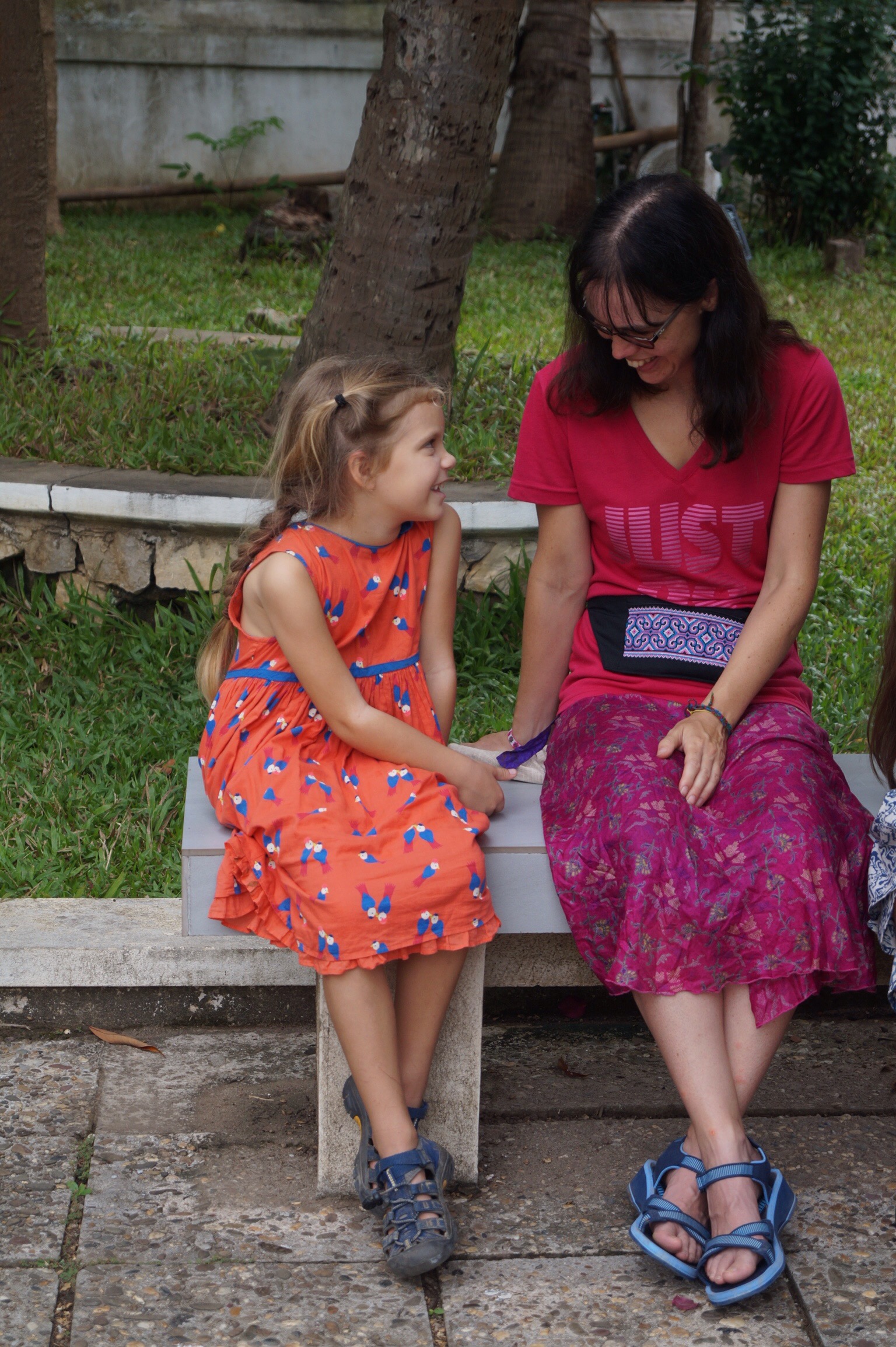
When we left Luang Prabang, we went to a museum that told us about bombs. Many people had died when the bombs dropped. These bombs were designed to blow up as soon as they hit the ground but many didn't go off straight away and still haven't gone YET. The bombs were dropped a long time ago, before mummy was born. They are still scattered all over the country, usually under the ground. They still go off when when a farmer touches it with his hoe, when children find them and play with them or when a cooking fire is lit above it. The bombs have lots of scrap metal in them, so people go out to collect them to get money because they are very poor. This is very dangerous. Thankfully the Lao people are working hard to get them and make them safe.
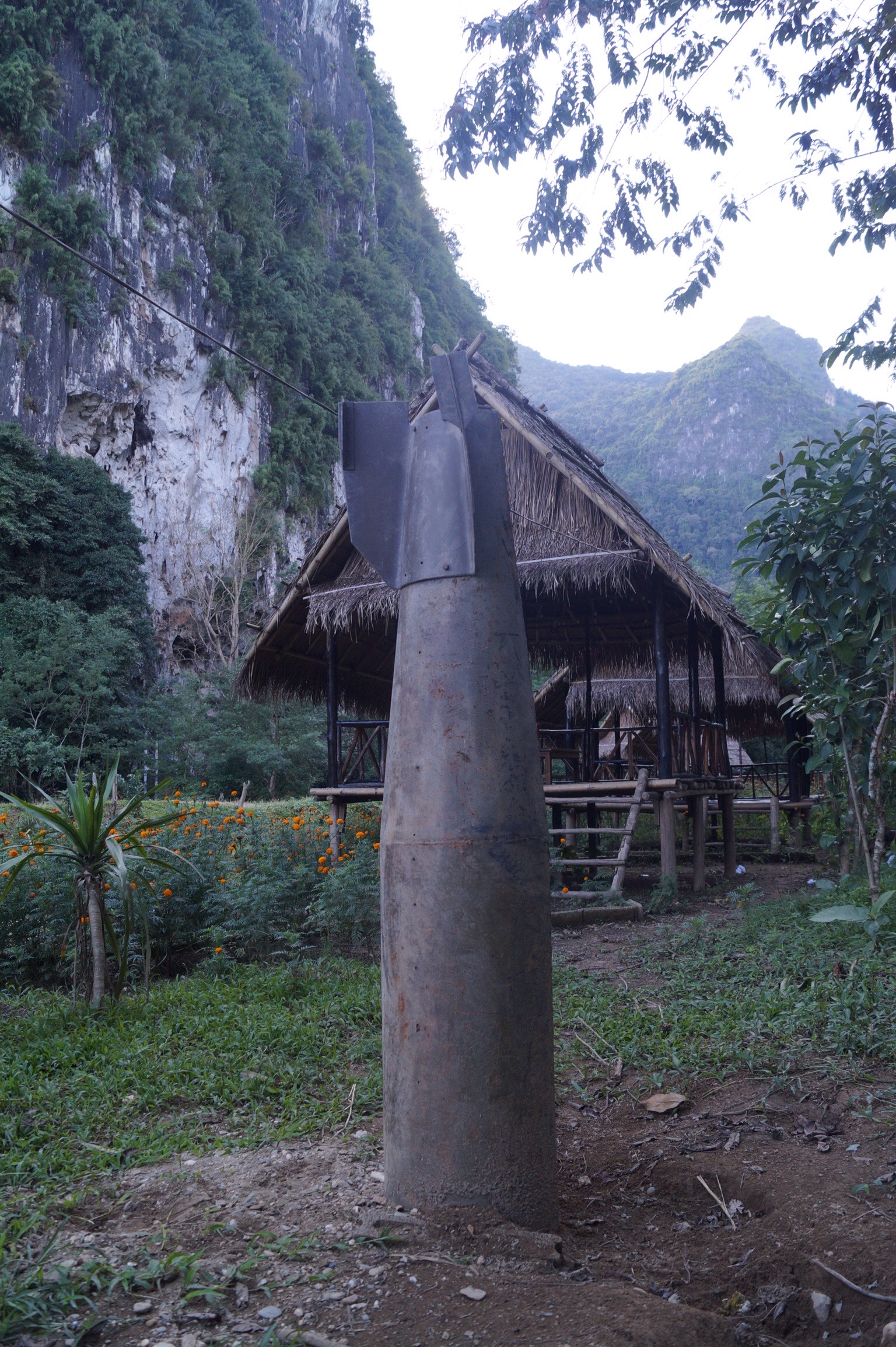
Alisha
I liked Laos, it was a good country. I think my farvourite bit was seeing Auntie Clare in Luang Prabang {I think that's how you spell it I might be wrong the computer certainly thinks so}
We started Laos off on an island in the middle off the Mekong. I enjoyed the many chicks, puppies and kittens running around the island.
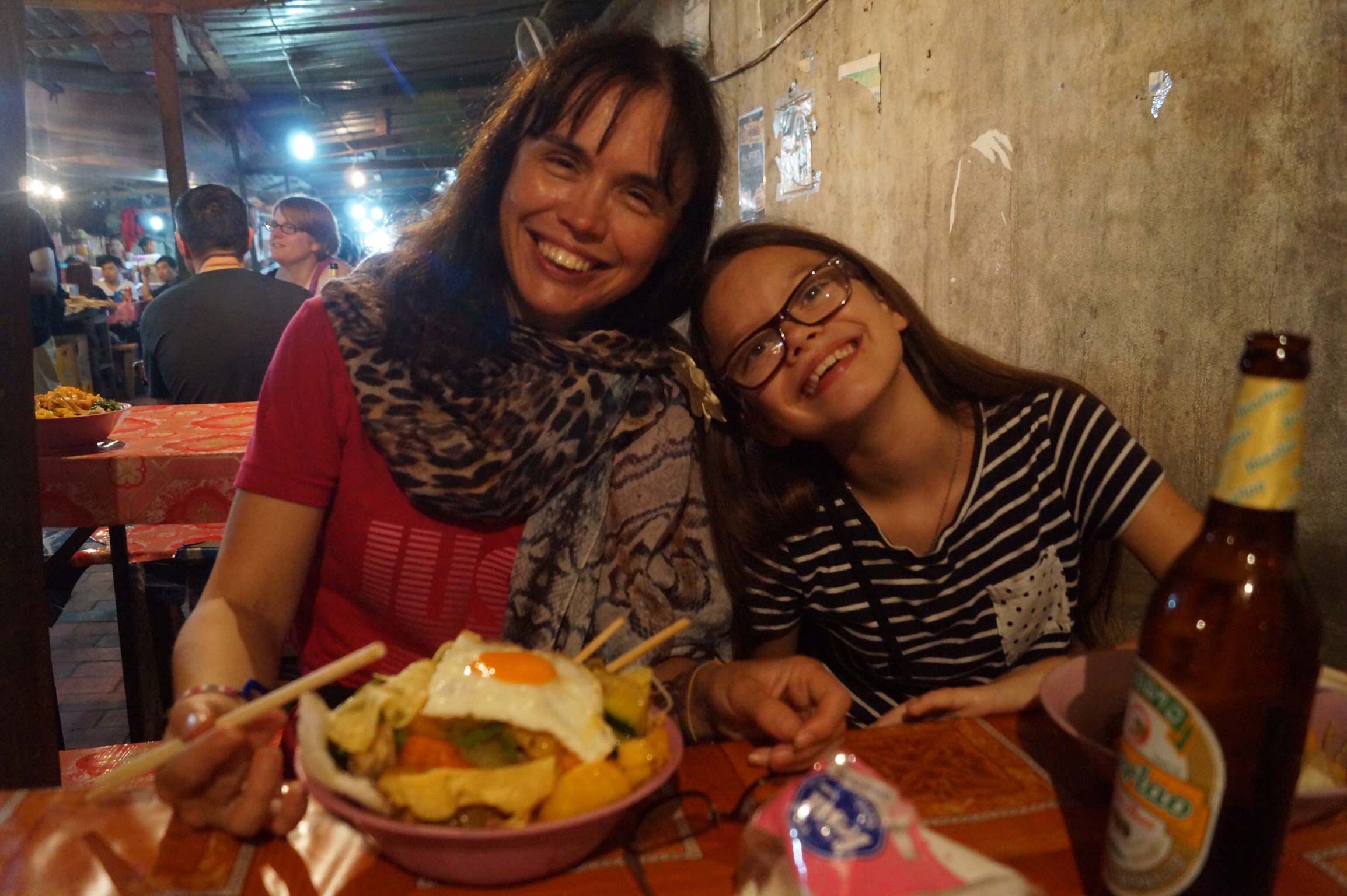
We spent one night on the Bolaven Plateau, which I loved as it dropped to about 12 degrees. We also had Halloween there, which I also enjoyed as it meant we could dress up and get lots of sweets. Daddy was very silly on the third time we went round the truck he kept offering us vegetables instead of sweets, it was very funny.
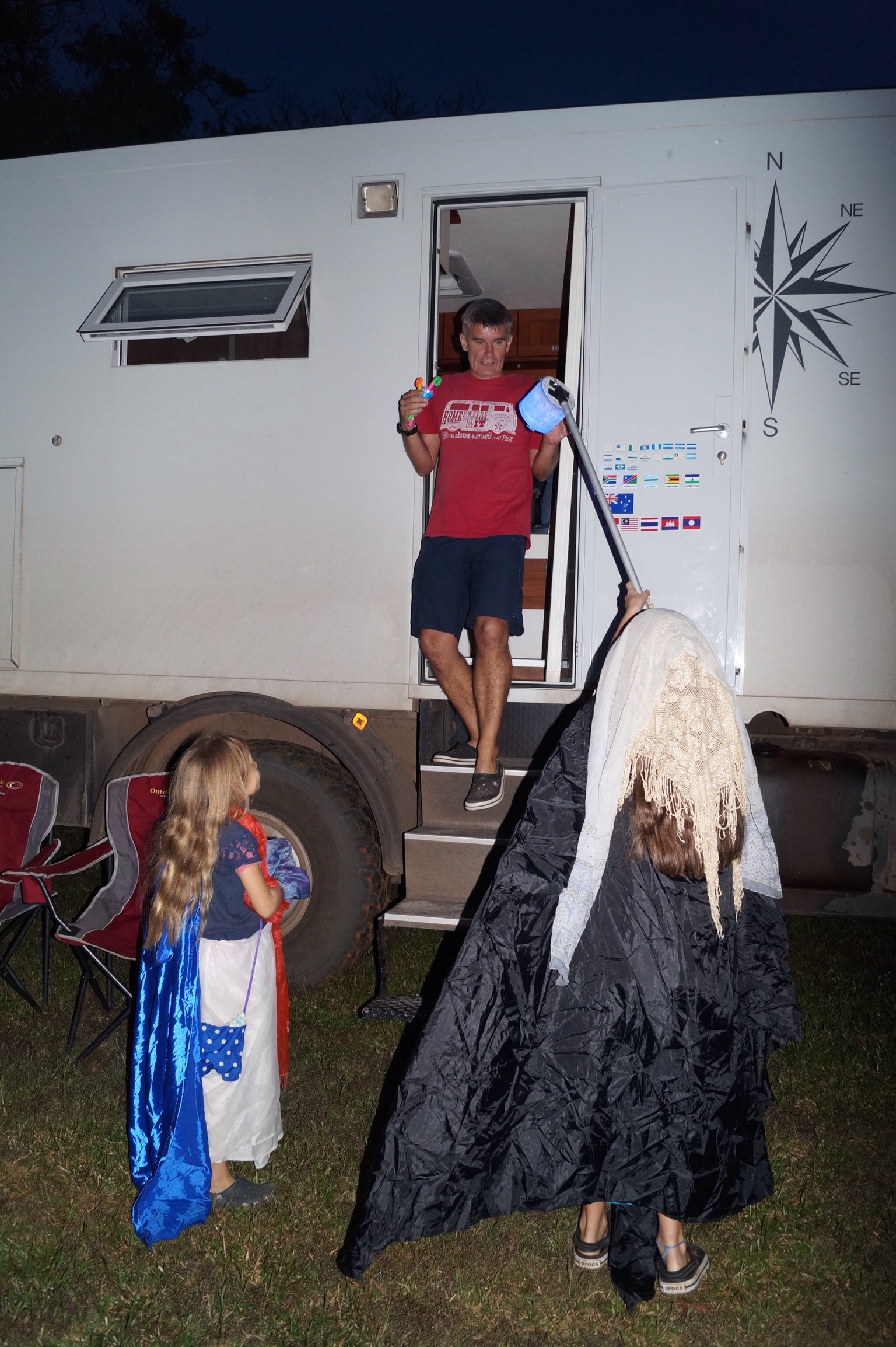
I liked going to the Buddha park in just outside Vientiane {which I called the ATM for a bit {don't ask me why} it was because I heard mummy and daddy talking about it through my head phone. It had a giant pumpkin in it for some weird reason {maybe it was a giant Halloween decoration that they had forgotten to take down or maybe Buddha's farvourite food was pumpkins or maybe) it had three levels to represent heaven, earth and hell there was a bit in the middle that I think was supposed to be nirvana but the only way to access it was by climbing through a devils head at the top but Lucy didn't want to so I stayed with her. The door was also a devil's head you had to climb in through its mouth.
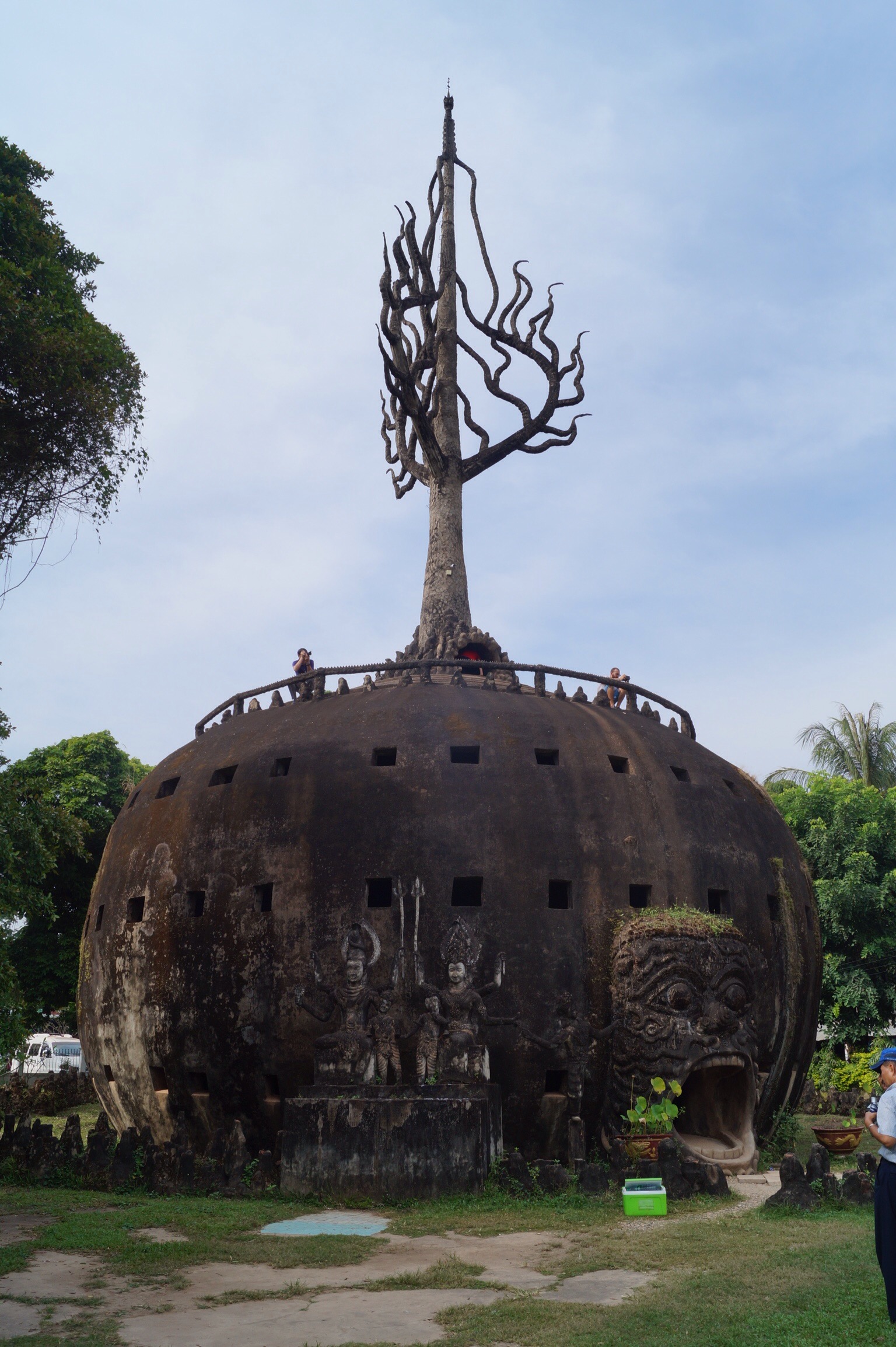
In Luang Probing we went shopping in the night market where we bought Christmas presents Auntie Clare gave us some early presents, which was great.
Then we went over some perilous roads. Once we where behind an overloaded truck that seemed to be holding long-dead animals {or so it smelled like}.
We did a 16 km hike!!!!!!!! But daddy bought lots of sweets so that wasn't too bad.
Next we cross into Thailand the spicy food country.
I liked Laos it was a good country
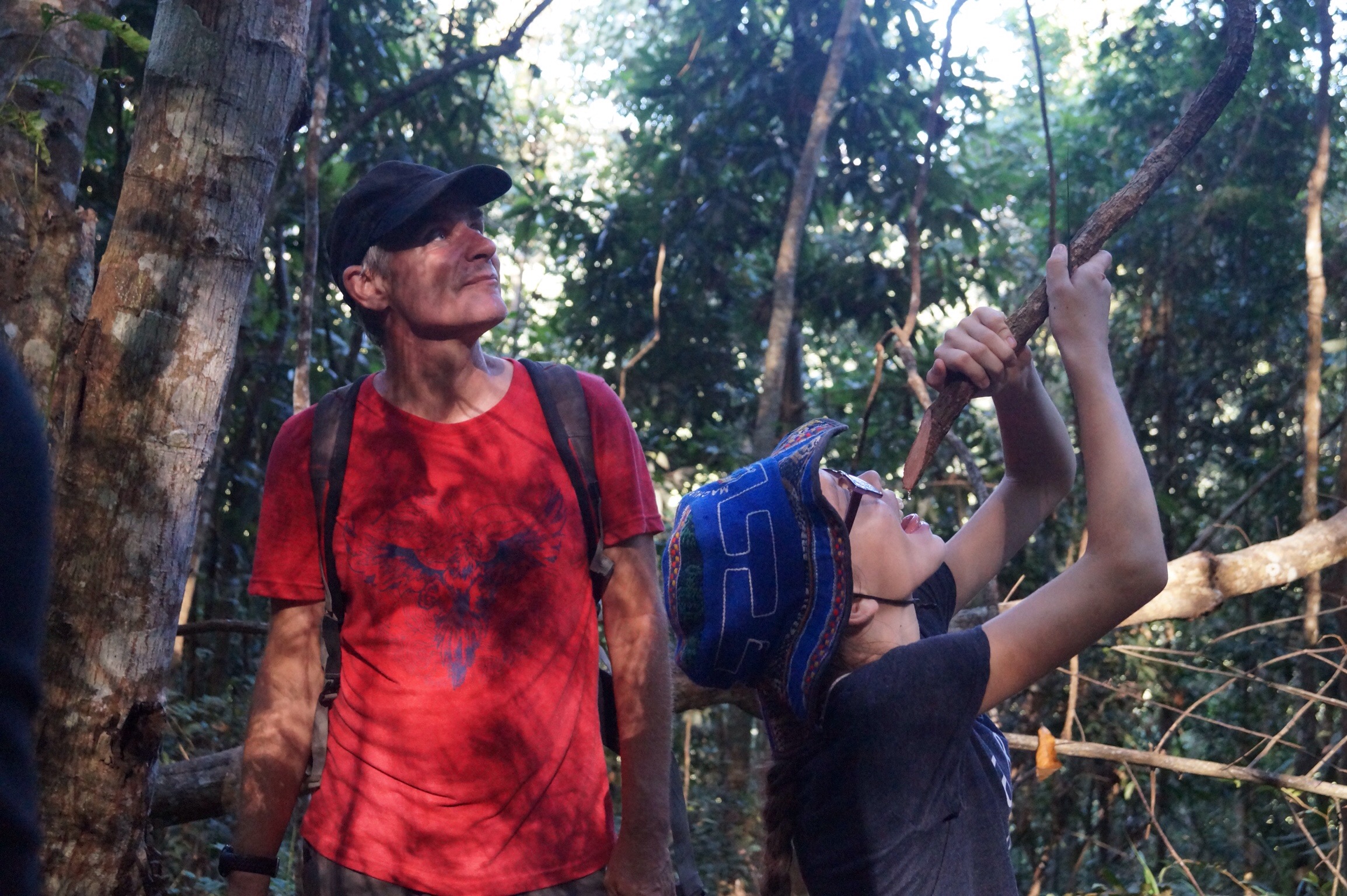
Gilly
My enduring image of Laos will be a crowd of girls streaming out of school in their smart black Sinhs (straight skirts with a white stripe at the bottom) and white shirts under pink tartan umbrellas. It's a scene we have seen repeated all over the country as we have travelled from the south to the north. There are usually two school sessions:morning and afternoon and the children travel by bike, motorbike or foot. It's a treacherous time to be driving as they stream out on-mass laughing, joshing and chattering - not paying attention to the road! In such an economically challenged country it's wonderful to see so many children, including high schoolers, in education. There seemed to me more girls than boys, which may just be my perception, but it is a promising observation about the education of girls in Laos.

Laos is still a communist country and the hammer and sickle is seen proudly flying everywhere alongside the national flag. It seemed very strange for us, I thought the flag had been done away with. In all those years we lived in Russia we only saw glimpses of it in older unrenovated buildings but in Laos it is everywhere. Like its neighbours Vietnam and China, Laos is economically definitely capitalist but to a far less aggressive degree. The Laos seem far less consumerist driven than their neighbours. Our guidebook has a quote from the French colonial times "The Vietnamese plant the rice, the Cambodians tend the rice and the Lao listen to it grow". I think there is a lot of balance in Lao between work, family and religion. It would drive me crazy to do business there but it makes it a lovely place to visit.
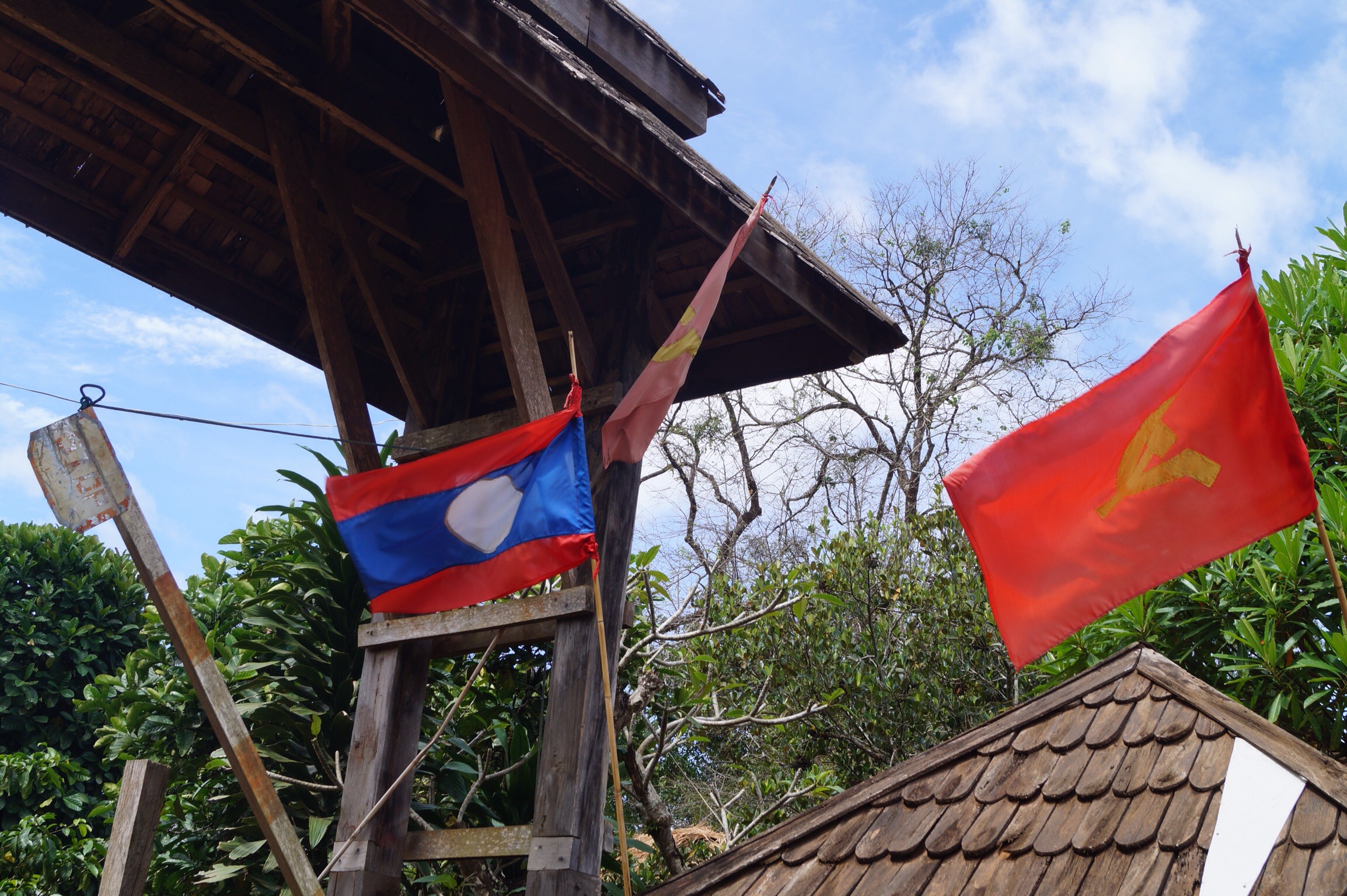
My favourite slogan and tastiest beer from Asia: Beerlaos - Beer of the Whole Hearted People.
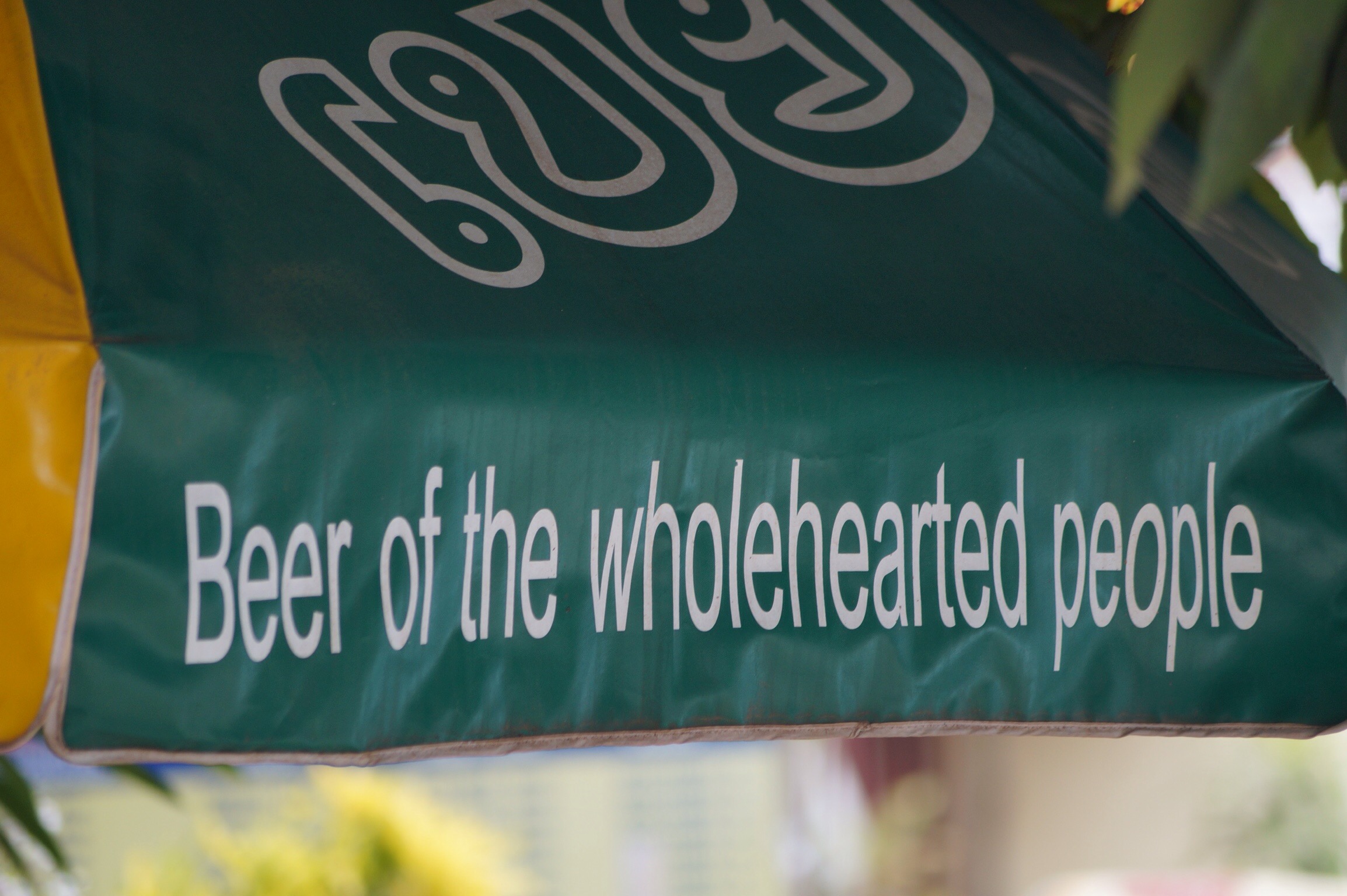
I think Laos might be my favourite country in South-East Asia. It might not have the top sites like Cambodia's Angkor Wat or Thailand's beaches, but it does have bags of character; the huge snaking Mekong River; beautiful mountainous scenery; and friendly, relaxed people. Definitely a winning combination for me.
Steve
Laos was a great country to wind down in. It's peaceful and relaxed. Everything is unhurried and even the driving is more mellow. Sometimes things seem so laid back that it's almost horizontal. Saying that I really enjoyed Laos. It is definitely one of the poorest countries in South East Asia but also one with a wealth of natural beauty.
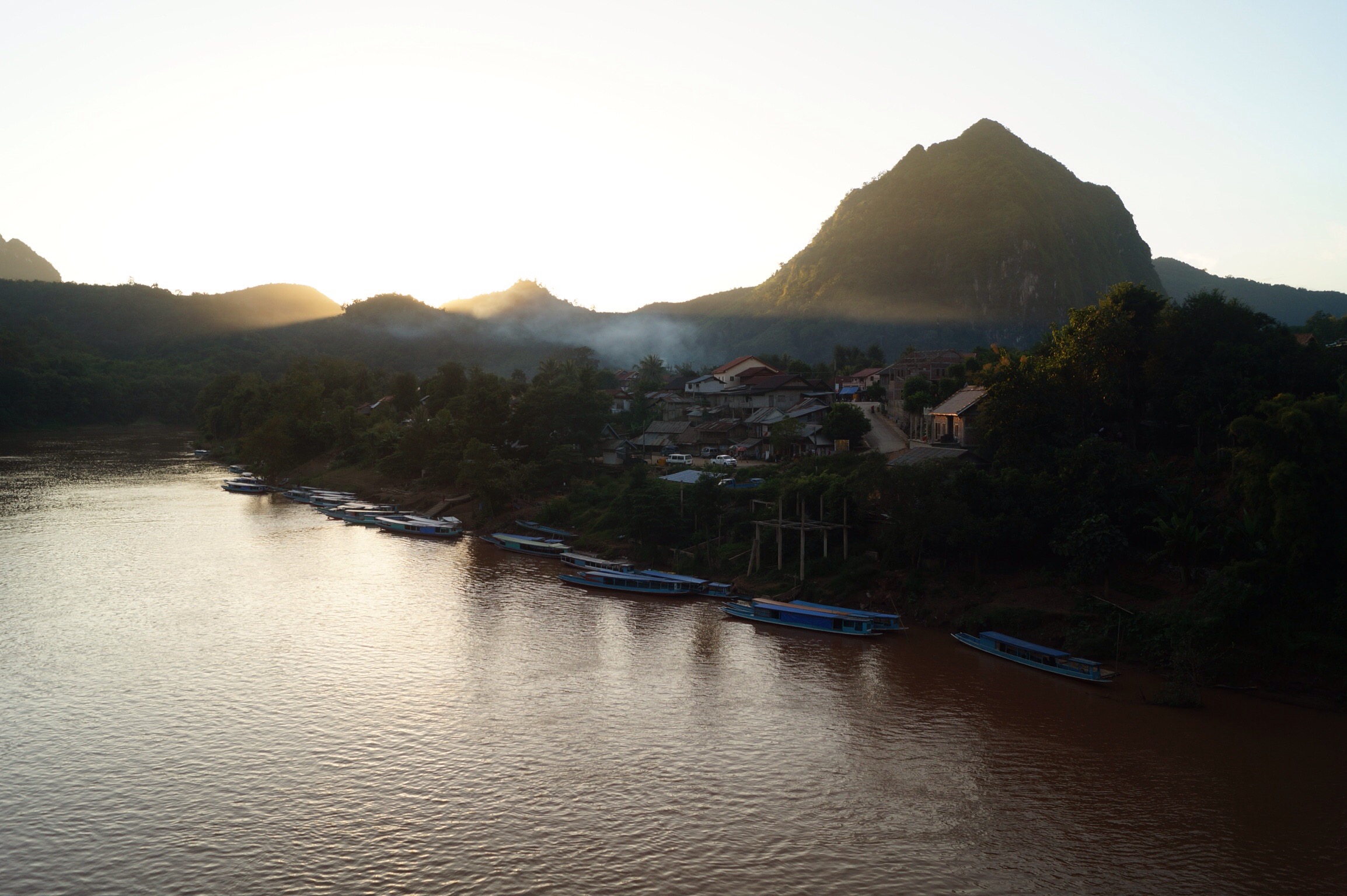
The people were generally very friendly although occasionally they seemed a little suspicious of us. As we are now in the dry season we could enjoy the lush beauty of the forests and jungles as well as the waterfalls and hills.
We travelled the length of the country and one of the most common sights was of the rice paddies along the way still been tilled by water bullocks and rice been harvested by hand. Whilst there are plenty of sights to see I think my overriding memory will be just how peaceful it was. We noticed the difference both in terms of development and speed of things as soon as we crossed the border into Thailand.
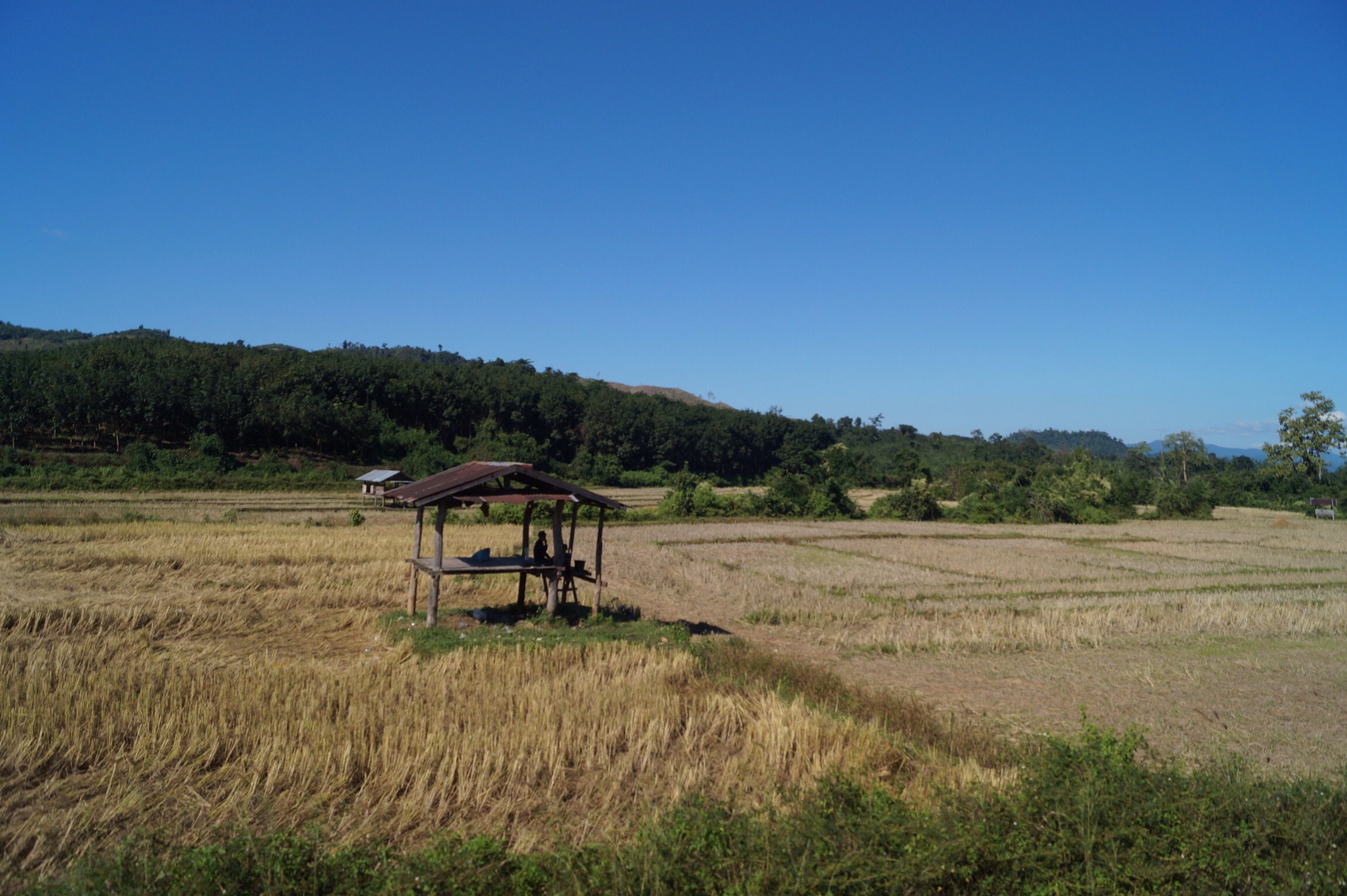
 Lucy
We crossed a river as we entered Laos and went to an island. One of the first things we saw was some beautiful kittens, the island was full of lovely cats and puppies. As we walked around the islands we saw pigs, cows, chickens, goats and water buffaloes. We walked through miles of rice paddies, where the rice was about to be harvested.
Lucy
We crossed a river as we entered Laos and went to an island. One of the first things we saw was some beautiful kittens, the island was full of lovely cats and puppies. As we walked around the islands we saw pigs, cows, chickens, goats and water buffaloes. We walked through miles of rice paddies, where the rice was about to be harvested.
 Before we met my Auntie Clare, we met a motorbiker who was travelling around the world, his name was Bob. When we saw my Auntie, we were so overjoyed. We went to the Night Market together in Luang Prabang, where we bought early Christmas presents. Once when we got up super early in the morning, it turned out there was a festival happening right next door, it was related to the full moon. We watched as all the monks put their bowls in a line on a table, while all the rest of the people put food in the bowls, an equal amount for each monk. There were other things that the monks might need, one lady brought some tissues, monks gets colds too.
Before we met my Auntie Clare, we met a motorbiker who was travelling around the world, his name was Bob. When we saw my Auntie, we were so overjoyed. We went to the Night Market together in Luang Prabang, where we bought early Christmas presents. Once when we got up super early in the morning, it turned out there was a festival happening right next door, it was related to the full moon. We watched as all the monks put their bowls in a line on a table, while all the rest of the people put food in the bowls, an equal amount for each monk. There were other things that the monks might need, one lady brought some tissues, monks gets colds too.
 When we left Luang Prabang, we went to a museum that told us about bombs. Many people had died when the bombs dropped. These bombs were designed to blow up as soon as they hit the ground but many didn't go off straight away and still haven't gone YET. The bombs were dropped a long time ago, before mummy was born. They are still scattered all over the country, usually under the ground. They still go off when when a farmer touches it with his hoe, when children find them and play with them or when a cooking fire is lit above it. The bombs have lots of scrap metal in them, so people go out to collect them to get money because they are very poor. This is very dangerous. Thankfully the Lao people are working hard to get them and make them safe.
When we left Luang Prabang, we went to a museum that told us about bombs. Many people had died when the bombs dropped. These bombs were designed to blow up as soon as they hit the ground but many didn't go off straight away and still haven't gone YET. The bombs were dropped a long time ago, before mummy was born. They are still scattered all over the country, usually under the ground. They still go off when when a farmer touches it with his hoe, when children find them and play with them or when a cooking fire is lit above it. The bombs have lots of scrap metal in them, so people go out to collect them to get money because they are very poor. This is very dangerous. Thankfully the Lao people are working hard to get them and make them safe.
 Alisha
I liked Laos, it was a good country. I think my farvourite bit was seeing Auntie Clare in Luang Prabang {I think that's how you spell it I might be wrong the computer certainly thinks so}
We started Laos off on an island in the middle off the Mekong. I enjoyed the many chicks, puppies and kittens running around the island.
Alisha
I liked Laos, it was a good country. I think my farvourite bit was seeing Auntie Clare in Luang Prabang {I think that's how you spell it I might be wrong the computer certainly thinks so}
We started Laos off on an island in the middle off the Mekong. I enjoyed the many chicks, puppies and kittens running around the island.
 We spent one night on the Bolaven Plateau, which I loved as it dropped to about 12 degrees. We also had Halloween there, which I also enjoyed as it meant we could dress up and get lots of sweets. Daddy was very silly on the third time we went round the truck he kept offering us vegetables instead of sweets, it was very funny.
We spent one night on the Bolaven Plateau, which I loved as it dropped to about 12 degrees. We also had Halloween there, which I also enjoyed as it meant we could dress up and get lots of sweets. Daddy was very silly on the third time we went round the truck he kept offering us vegetables instead of sweets, it was very funny.
 I liked going to the Buddha park in just outside Vientiane {which I called the ATM for a bit {don't ask me why} it was because I heard mummy and daddy talking about it through my head phone. It had a giant pumpkin in it for some weird reason {maybe it was a giant Halloween decoration that they had forgotten to take down or maybe Buddha's farvourite food was pumpkins or maybe) it had three levels to represent heaven, earth and hell there was a bit in the middle that I think was supposed to be nirvana but the only way to access it was by climbing through a devils head at the top but Lucy didn't want to so I stayed with her. The door was also a devil's head you had to climb in through its mouth.
I liked going to the Buddha park in just outside Vientiane {which I called the ATM for a bit {don't ask me why} it was because I heard mummy and daddy talking about it through my head phone. It had a giant pumpkin in it for some weird reason {maybe it was a giant Halloween decoration that they had forgotten to take down or maybe Buddha's farvourite food was pumpkins or maybe) it had three levels to represent heaven, earth and hell there was a bit in the middle that I think was supposed to be nirvana but the only way to access it was by climbing through a devils head at the top but Lucy didn't want to so I stayed with her. The door was also a devil's head you had to climb in through its mouth.
 In Luang Probing we went shopping in the night market where we bought Christmas presents Auntie Clare gave us some early presents, which was great.
Then we went over some perilous roads. Once we where behind an overloaded truck that seemed to be holding long-dead animals {or so it smelled like}.
We did a 16 km hike!!!!!!!! But daddy bought lots of sweets so that wasn't too bad.
Next we cross into Thailand the spicy food country.
I liked Laos it was a good country
In Luang Probing we went shopping in the night market where we bought Christmas presents Auntie Clare gave us some early presents, which was great.
Then we went over some perilous roads. Once we where behind an overloaded truck that seemed to be holding long-dead animals {or so it smelled like}.
We did a 16 km hike!!!!!!!! But daddy bought lots of sweets so that wasn't too bad.
Next we cross into Thailand the spicy food country.
I liked Laos it was a good country
 Gilly
My enduring image of Laos will be a crowd of girls streaming out of school in their smart black Sinhs (straight skirts with a white stripe at the bottom) and white shirts under pink tartan umbrellas. It's a scene we have seen repeated all over the country as we have travelled from the south to the north. There are usually two school sessions:morning and afternoon and the children travel by bike, motorbike or foot. It's a treacherous time to be driving as they stream out on-mass laughing, joshing and chattering - not paying attention to the road! In such an economically challenged country it's wonderful to see so many children, including high schoolers, in education. There seemed to me more girls than boys, which may just be my perception, but it is a promising observation about the education of girls in Laos.
Gilly
My enduring image of Laos will be a crowd of girls streaming out of school in their smart black Sinhs (straight skirts with a white stripe at the bottom) and white shirts under pink tartan umbrellas. It's a scene we have seen repeated all over the country as we have travelled from the south to the north. There are usually two school sessions:morning and afternoon and the children travel by bike, motorbike or foot. It's a treacherous time to be driving as they stream out on-mass laughing, joshing and chattering - not paying attention to the road! In such an economically challenged country it's wonderful to see so many children, including high schoolers, in education. There seemed to me more girls than boys, which may just be my perception, but it is a promising observation about the education of girls in Laos.
 Laos is still a communist country and the hammer and sickle is seen proudly flying everywhere alongside the national flag. It seemed very strange for us, I thought the flag had been done away with. In all those years we lived in Russia we only saw glimpses of it in older unrenovated buildings but in Laos it is everywhere. Like its neighbours Vietnam and China, Laos is economically definitely capitalist but to a far less aggressive degree. The Laos seem far less consumerist driven than their neighbours. Our guidebook has a quote from the French colonial times "The Vietnamese plant the rice, the Cambodians tend the rice and the Lao listen to it grow". I think there is a lot of balance in Lao between work, family and religion. It would drive me crazy to do business there but it makes it a lovely place to visit.
Laos is still a communist country and the hammer and sickle is seen proudly flying everywhere alongside the national flag. It seemed very strange for us, I thought the flag had been done away with. In all those years we lived in Russia we only saw glimpses of it in older unrenovated buildings but in Laos it is everywhere. Like its neighbours Vietnam and China, Laos is economically definitely capitalist but to a far less aggressive degree. The Laos seem far less consumerist driven than their neighbours. Our guidebook has a quote from the French colonial times "The Vietnamese plant the rice, the Cambodians tend the rice and the Lao listen to it grow". I think there is a lot of balance in Lao between work, family and religion. It would drive me crazy to do business there but it makes it a lovely place to visit.
 My favourite slogan and tastiest beer from Asia: Beerlaos - Beer of the Whole Hearted People.
My favourite slogan and tastiest beer from Asia: Beerlaos - Beer of the Whole Hearted People.
 I think Laos might be my favourite country in South-East Asia. It might not have the top sites like Cambodia's Angkor Wat or Thailand's beaches, but it does have bags of character; the huge snaking Mekong River; beautiful mountainous scenery; and friendly, relaxed people. Definitely a winning combination for me.
Steve
Laos was a great country to wind down in. It's peaceful and relaxed. Everything is unhurried and even the driving is more mellow. Sometimes things seem so laid back that it's almost horizontal. Saying that I really enjoyed Laos. It is definitely one of the poorest countries in South East Asia but also one with a wealth of natural beauty.
I think Laos might be my favourite country in South-East Asia. It might not have the top sites like Cambodia's Angkor Wat or Thailand's beaches, but it does have bags of character; the huge snaking Mekong River; beautiful mountainous scenery; and friendly, relaxed people. Definitely a winning combination for me.
Steve
Laos was a great country to wind down in. It's peaceful and relaxed. Everything is unhurried and even the driving is more mellow. Sometimes things seem so laid back that it's almost horizontal. Saying that I really enjoyed Laos. It is definitely one of the poorest countries in South East Asia but also one with a wealth of natural beauty.
 The people were generally very friendly although occasionally they seemed a little suspicious of us. As we are now in the dry season we could enjoy the lush beauty of the forests and jungles as well as the waterfalls and hills.
We travelled the length of the country and one of the most common sights was of the rice paddies along the way still been tilled by water bullocks and rice been harvested by hand. Whilst there are plenty of sights to see I think my overriding memory will be just how peaceful it was. We noticed the difference both in terms of development and speed of things as soon as we crossed the border into Thailand.
The people were generally very friendly although occasionally they seemed a little suspicious of us. As we are now in the dry season we could enjoy the lush beauty of the forests and jungles as well as the waterfalls and hills.
We travelled the length of the country and one of the most common sights was of the rice paddies along the way still been tilled by water bullocks and rice been harvested by hand. Whilst there are plenty of sights to see I think my overriding memory will be just how peaceful it was. We noticed the difference both in terms of development and speed of things as soon as we crossed the border into Thailand.



